Chambersburg Civil War Seminars & Tours Announces

Ted Alexander’s Retirement and Successor
Eric
Wittenberg
Ted Alexander, retired chief historian at Antietam National Battlefield, recently announced his retirement as program coordinator of Chambersburg Civil War Seminars & Tours; Eric Wittenberg has been named as his successor. Ted, along with the Greater Chambersburg Chamber of Commerce, hosted the first Chambersburg Civil War Conference in 1989 to support the local business community, attract tourism to the area, and raise funds for battlefield preservation. To date, the organization has raised more than $215,000 that has been donated to many nonprofit organizations supporting the interpretation and preservation of our Civil War heritage.
Ted has authored, edited, and/ or contributed to 10 books on the Civil War and other aspects of American history. He has written more than 200 book reviews and articles for publications such as the Civil War Times and The Washington Times. He retired in 2016 as the chief historian at Antietam National Battlefield after serving 35 years with the
National Park Service.
Ted’s work and legacy was recently recognized at the Antietam: The Bloodiest Day Conference held this past summer with more than 100 history enthusiasts in attendance. A special retirement celebration was held in Ted’s honor with talks given by Lark Kennedy of the Chambersburg Chamber; Scott Anderson, head of conference logistics; Dennis Frye, retired chief historian at Harpers Ferry National Park, and Dr. Tom Clemens, historian and interpreter at Antietam National Battlefield.
“Ted’s vision and collaboration with the Chambersburg Chamber has been critical to the success of the program, and we are grateful for his many years of service,” said Lark Kennedy. “We wish him good health, good luck, and great success in his retirement.”
Chambersburg Civil War Seminars & Tours will continue under the umbrella of the Chambersburg Chamber with Eric Wittenberg as the new program coordinator.
“2019 marks the 31st year for Chambersburg Civil War Seminars,” said Eric Wittenberg. “It’s been a remarkable run of success, with hundreds of thousands of dollars raised for battlefield preservation. Without Ted Alexander, there would be no Chambersburg Civil War Seminars; it’s that simple. These programs are the result of Ted’s vision, and since 1988, they have been the gold standard for programming of its type. We owe all of that to Ted.”


Eric Wittenberg is an award-winning American Civil War historian and one of the country’s foremost experts on Civil War cavalry. He is the author or co-author of 21 published books including the best-selling Plenty of Blame to Go Around: Jeb Stuart’s Controversial Ride to Gettysburg. Eric has written more than 30 articles published in national magazines and is an avid Civil War battlefield preservationist. He is a practicing attorney who resides in Ohio with his
For Civil War Enthusiasts
155th Anniversaries of the Crater and Weldon Railroad
Petersburg National Battlefield observes the 155th Anniversaries of the Battles of the Crater and Weldon Railroad/ Second Ream’s Station
By Professor Earnest Veritas
Special
Correspondent
to Civil War News
-Western TheaterPetersburg National Battlefield held observations of the 155th anniversaries of the savage battles of the Crater and the battles for Weldon Railroad and Second Ream’s Station on July 27-28 and August 17-18 respectively.
To explain to visitors about the Crater and the resulting battle; General’s Ulysses S. Grant and Robert E. Lee (Curt Fields and Thomas Jessee) were on hand to talk about what they were doing before and during the battle itself. They explained their efforts to dig and, conversely, find the Federal tunnel; to press or defeat, any advantage that might be gained by
the explosion. They held a number of scheduled talks with visitors and spoke to the scheduled Ranger-led tours, as well.
Ranger Aaron Rowland said that there were more than 600 visitors to the park’s Eastern Front visitor center for the weekend. He said that there were more
than 1,100 visitors for the battlefield talks and demonstrations over the two days.
Those programs were: The Battle of the Crater extended walking tour, Mahone’s counter attack walk and demonstration, an author discussion about “Behind the rifle: Women Soldiers of Civil War Mississippi” by author Shelby Harriel, “United States Colored Troops during the Civil War” by Morris Lockhart, and “The Life of William Mahone” by Earl Blythe.
Reenactors who brought the War to life for weekend visitors were:12th Virginia, 44th Virginia, Pegram’s Battery (Confederate), Cooper’s Battery (Federal), and the Ladies of the 12th Virginia in ongoing demonstrations at the Eastern Front visitor Center. The Aide-de-Camp to General Grant was Captain Gene Smallwood.
The 155th anniversary of the Battles for Weldon Railroad and Second Ream’s Station was held during the weekend of August 1718. General Grant (Curt Fields)
Vol. 45, No. 10 48 Pages, October 2019 $3.50 Civil War News America’s Monthly Newspaper
Inside this issue: 47 – Advertiser Index 8 – Black Powder, White Smoke 36 – Book Reviews 40 – Critic’s Corner 34 – Emerging Civil War 45 – Events Section 20 – The Graphic War 22 – Inspection, ARMS! 13 – News Briefs 41 – Small Talk-Trivia 16 – The Source 10 – The Unfinished Fight 26 – This And That 14 – Through The Lens H Chambersburg . . . . . . . . . . . . see page 9 H Anniversaries . . . . . . . . . . . . see page 9
CW N
Curt Fields portrays General’s Ulysses S. Grant at the 155th anniversary of Petersburg. (All photos by Jeff Seymour)
Grant and staff (L to R) Greg Eatroff as Aide-de-Camp, Mark Day as General E. O. C. Ord, Grant, Rick Gist as Grant’s surgeon.
Civil War News
Published by Historical Publications LLC
520 Folly Road, Suite 25 PMB 379, Charleston, SC 29412
800-777-1862 • Facebook.com/CivilWarNews mail@civilwarnews.com • www.civilwarnews.com
Advertising: 800-777-1862 • ads@civilwarnews.com


Jack W. Melton Jr. C. Peter & Kathryn Jorgensen
Publisher Founding Publishers
Editor: Lawrence E. Babits, Ph.D.
Advertising, Marketing & Assistant Editor: Peggy Melton
Columnists: John Banks, Craig Barry, Joseph Bilby, Matthew Borowick, Stephen Davis, Stephanie Hagiwara, Gould Hagler, Tim Prince, Salvatore Cilella, John Sexton, Michael K. Shaffer

Editorial & Photography Staff: Greg Biggs, Joseph Bordonaro, Sandy Goss, Gordon L. Jones, Michael Kent, Bob Ruegsegger, Gregory L. Wade, Joan Wenner, J.D.
Book Review Editor: Stephen Davis, Ph.D., Cumming, Ga.
Civil War News (ISSN: 1053-1181) Copyright © 2019 by Historical
Publications LLC is published 12 times per year by Historical Publications LLC, 520 Folly Road, Suite 25 PMB 379, Charleston, SC 29412. Monthly. Business and Editorial Offices: 520 Folly Road, Suite 25 PMB 379, Charleston, SC 29412, Accounting and Circulation
Offices: Historical Publications LLC, 520 Folly Road, Suite 25 PMB 379, Charleston, SC 29412. Call 800-777-1862 to subscribe.
Periodicals postage paid at U.S.P.S. 131 W. High St., Jefferson City, MO 65101.
POSTMASTER: Send address changes to: Historical Publications LLC 520 Folly Road Suite 25 PMB 379 Charleston, SC 29412
Display advertising rates and media kit on request. The Civil War News is for your reading enjoyment. The views and opinions expressed herein are those of its authors, readers and advertisers and they do not necessarily reflect the official policy or position of Historical Publications, LLC, its owners and/or employees.
P UBLISHERS :
Please send your book(s) for review to:
CWN Book Review Editor, Stephen Davis
3670 Falling Leaf Lane, Cumming, GA 30041-2087
Email cover image to bookreviews@civilwarnews.com
Civil War News cannot assure that unsolicited books will be assigned for review. We donate unsolicited, unreviewed books to libraries, historical societies and other suitable repositories. Email Dr. Davis for eligibility before mailing.
ADVERTISING INFO:
Email us at ads@civilwarnews.com Call 800-777-1862
MOVING?
Contact us to change your address so you don’t miss a single issue. mail@civilwarnews.com • 800-777-1862
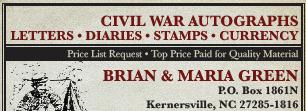
SUBSCRIPTION RATES
U.S. Subscription rates are $38.50/year, $66/2 years, digital only $29.95, add digital to paper subscription for only $10/year more. Subscribe at www.CivilWarNews.com
Civil War News Military Recognition
For the November issue, we will recognize subscribers who are currently in the military and those who have served their country. Please send in your name, branch of service, rank, position, and if you were in a war, conflict, years served, etc.

For example:
Carson Jenkins U.S. Army, E-6, Fire Control Supervisor, Vietnam War era, (1969-1974)
Email is the best way to submit your entries, but if you don’t have access to email, please mail it to us so that your information reaches us by the September 20th deadline. Email the information to ads@civilwarnews.com.
Please let us know if you move. Periodical mail is usually not forwarded to your new address. The Post Office tears your mailing address and throws the issue away. We then get charged for it. If you move and don’t let us know not only will you miss that issue but we’ll have to charge you to cover our costs if you request a replacement copy. Call us at 800-777-1862 or email ads@civilwarnews.com. It is that easy.
Hurricane Dorian
This issue was finished early due to hurricane Dorian. The coasts of Florida to South Carolina were under a hurricane watch and were ordered to evacuate. I apologize in advance for any mistakes or errors. We ran out of time.
Hopefully everyone in the affected areas will safely ride out the hurricane.
2 Civil War News October 2019
Letters to the Editor: Please email: mail@civilwarnews.com Civil War News 520 Folly Road, Suite 25 PMB 379 Charleston, SC 29412 Subscribe online at CivilWarNews.com
Digital Issues of CWN are available by subscription alone or with print plus archives from 2012 to present at www.CivilWarNews.com A note to
subscribers
Deadlines for Advertising or Editorial Submissions is the 20th of each month. Email to ads@civilwarnews.com






The North Georgia Relic Hunters 41st Annual Show
MARIETTA, Ga.—The North Georgia Relic Hunters recently sponsored its 41st Annual Southeastern Civil War and Antique Gun Show at the Cobb County Civic Center in Marietta, Ga. This event was held on Saturday, August 10th and Sunday, August 11th. The event featured over 230 tables with vendors displaying and selling items such as dug relics, guns and swords, books, framed and unframed prints, metal detectors, artillery items, and antique currency. With permission from the dealers, children and families
can see and touch many different types of historical items that were used by soldiers in the American Civil War.
This show helps support the club’s yearly donations to many local historical community organizations.
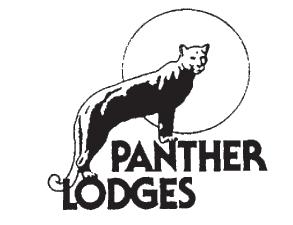
Vendors were happy to share detailed information about the various items which enabled attendees (both children and adults alike) to learn more about each item on display or for sale. The hands-on interaction helps to give attendees the perspective on the history of the items, some that
their ancestors may have even used in the Civil War. This show permitted one to get “up close” to items to the extent that one is typically not allowed to do in museums.
Guests speakers, including author and historian Michael Schaffer and historian Harper Harris, were present to give historical lectures and storytelling on various topics related to this period in our history.
Author and Civil War speaker, Stephen Davis, was set up on Saturday afternoon at the tables of Owens & Ramsey Booksellers. He debuted his much-anticipated new release 100 Significant Civil War Photographs: Atlanta Campaign and offer book signings.
Brad Quinlan, a local historian, was also set up for signing books on Saturday. He said this about the show, “If I won the lottery there’s a lot of stuff I’d love
to buy and take home. It’s the historical and personal value on some artifacts, especially those related to the 1864 Atlanta campaign, which is my niche. There are some wonderful relics and a few with great human-interest

stories.”
Overall, the 2019 Civil War show was a great success, and the promoters are looking forward to another rewarding year for vendors and visitors alike in August 2020.
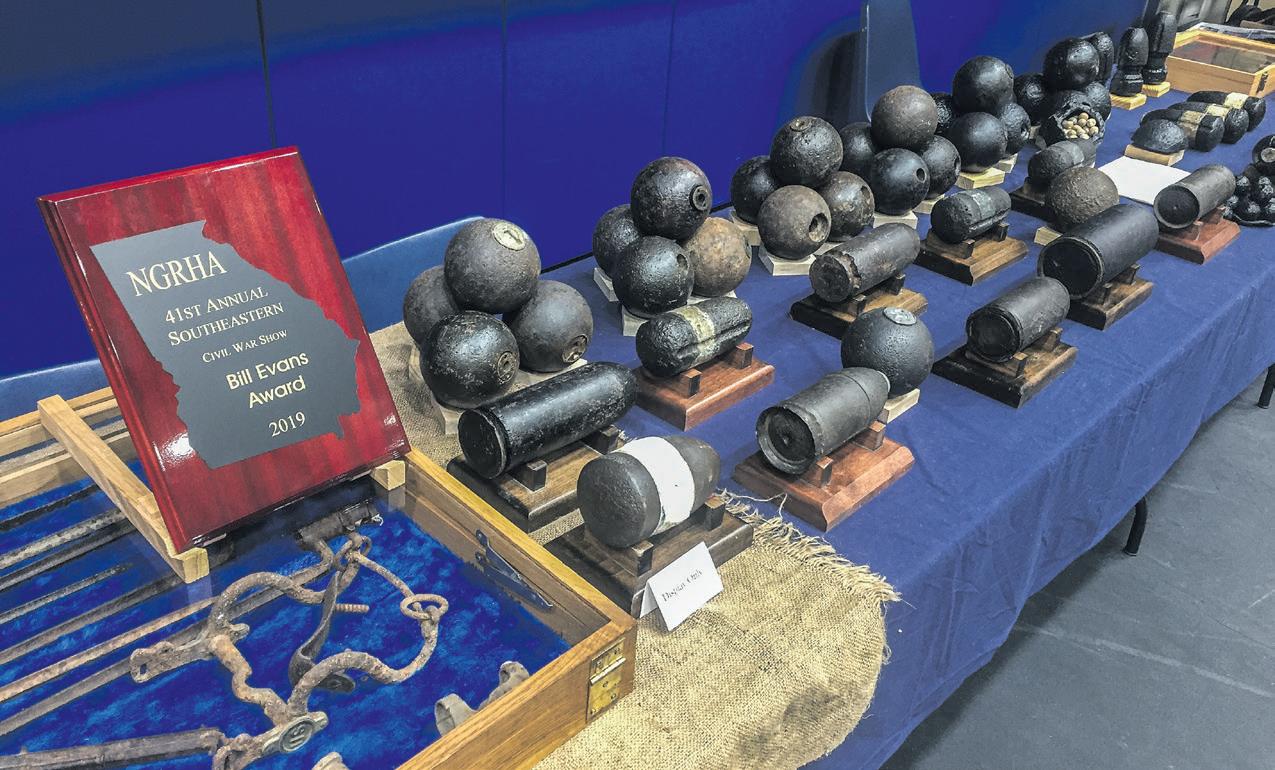
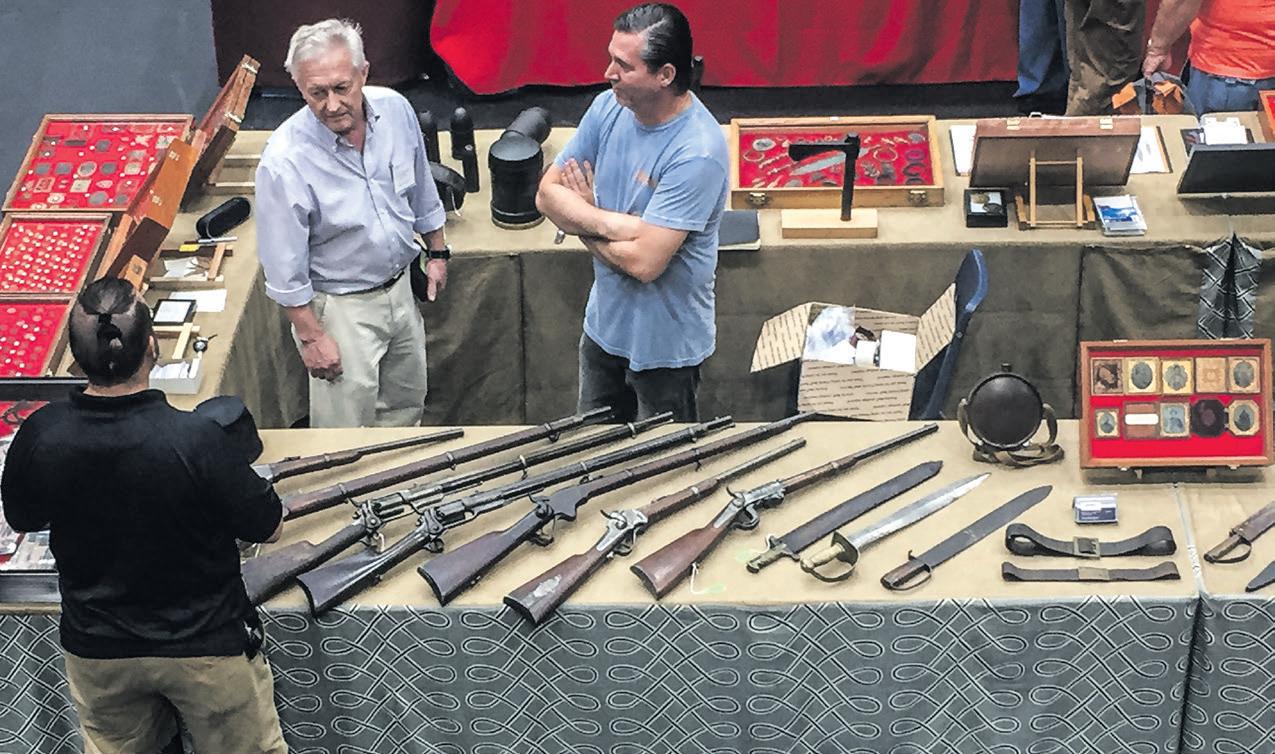






4 Civil War News October 2019 REINFORCEMENTS MAKE ALL THE DIFFERENCE!!! Nobody even comes close to building a Civil War tent with as much attention to reinforcing the stress areas as Panther. Our extra heavy duty reinforcing is just one of the added features that makes Panther tentage the best you can buy! PANTHER Catalog - $2 Web: www.pantherprimitives.com 160 pages of the best selection of historical reenactment items from Medieval era to Civil War era. Includes over 60 pages on our famous tents and a 4-color section. Your $2 cost is refundable with your first order. SEND for copy TODAY The Best Tents in History P.O. Box 32N Normantown WV 25267 (304) 462-7718
The show was packed full of artifacts, antique weapons, books, and other collectibles from the Civil War to World War II.
Vin Caponi’s table featured a variety of antique handguns, carbines, and other firearms for sale.
The 41st annual Southeaster Civil War and Antique Gun Show was held at the Cobb County Civic Center and featured vendors and collectors from all over the country.
Over 230 tables filled the venue on two floors at the newly renovated Cobb Civic Center.
Jerry Hayes won “Excavated Relics Display” for his Excavated Confederate Buckles and Buttons Display.
Wallace Markert and Nick Periut at their sale tables having a conversation with Brian Akins.
Stan Wills and Roy Baker won “Bobby Westbrook / Bill Evans Display” for his locally dug relics display.











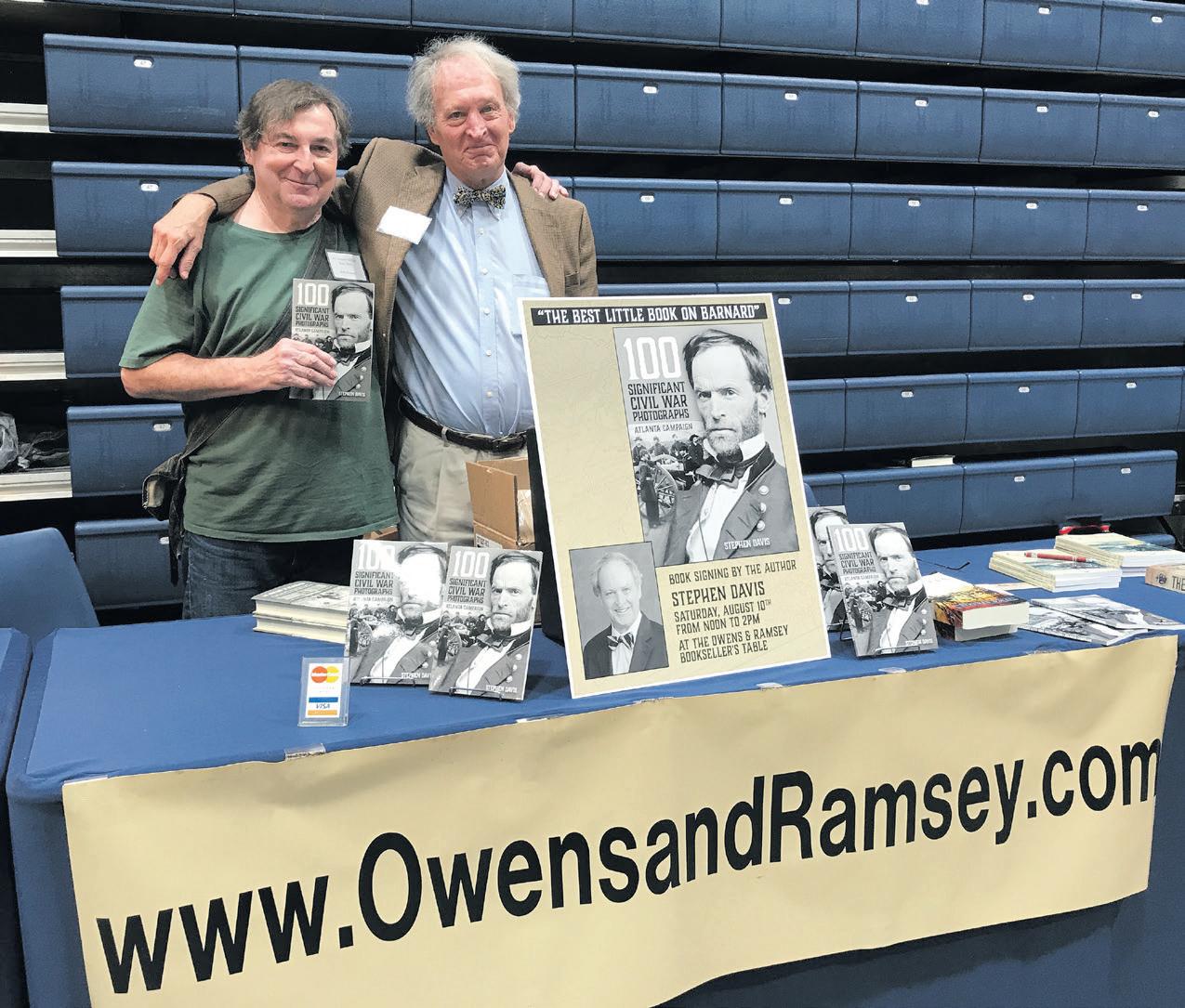
5 October 2019 Civil War News Subscribe online at CivilWarNews.com
Left to right: Jerry Hayes won “Excavated Relics Display” for his Excavated Confederate Buckles and Buttons presentation. Stan Wills (not shown) and Roy Baker won “Bobby Westbrook / Bill Evans Display” for his locally dug relics exhibit. Scott Riddle won “Judges Award” for his Atlanta Campaign Relics display. John Turner won “Non-Excavated Relic Display” for his snake buckle exhibit, and Jerry Kirkland won “Most Educational Display” for his South Carolina Brass.
One of many tables filled with merchandise for collectors alike.
Jerry Kirkand´s “Most Educational Display” of South Carolina Brass artifacts.
Bookseller Marc Ramsey and author Stephen Davis pose with his new book 100 Significant Civil War Photographs: Atlanta Campaign at Stephen’s first book signing for this book.








6 Civil War News October 2019
“Grant and Twain: The Men and the Memoirs” Plays in Quincy, Illinois
By Professor Earnest Veritas Special Correspondent to the Civil War News -Western Theater-

The 300 people in the buzzing auditorium went silent as the lights went down and the announcer said, “Ladies and Gentlemen, President Ulysses S. Grant and Mr. Samuel Clemens, bring you “Grant and Twain: The Men and the Memoirs”!”
The Date: April 2, 2019. The place: John Wood Community College, Mary Ellis Orr auditorium, in Quincy, Illinois.
President Grant wearing tophat and black suit and Samuel Clemens in his iconic white suit, strode from opposite sides of the stage to the center front; stopped, shook hands, and turned to face the audience. Mr. Clemens stepped back and to the side. President Grant began speaking and gesturing with his three-knob headed cane for emphasis; later explaining the significance of the three knobs (He told the audience during the question and answer session, that it was an inauguration gift from a veteran of the Civil War and the three nobs, graduating in size from smallest at the bottom, represent the three armies he took in surrender during the War). After the President spoke about his life up to being elected President, he stepped back and to the side as Mr. Clemens came forward, delivering a parallel soliloquy about his own life; drawing the audience’s attention to the similarities and differences between his life and that of President Grant.
The second act of the production was a discussion between President Grant and Mr. Clemens about how Clemens’ publishing company, Charles L. Webster, was chosen to publish his “Personal Memoirs” and how the process unfolded. The struggle of President Grant, dying of inoperable throat cancer while writing his memoirs was lifted up, revealing the supreme, lastditch effort of Grant to finish and provide for his wife, Julia, before he died.
Grant and Clemens then held a question and answer session with the audience.
That audience was approximately 300 middle and high school students, mostly Advanced Placement and excelling students, from Quincy Senior High School, Quincy Notre Dame, Quincy University, John Wood Community College, and students from nearby Hannibal, Mo., with teachers, supervisors,
college personnel, and others from the community.
The presentation was brought to Quincy by the joint efforts of the Historical Society of Quincy and Adams County and the TriState Civil War Round Tables. The groups were assisted by a generous contribution from a local benefactor; making the program possible.
“Grant and Twain: The Men and the Memoirs” is a joint effort of Living Historians Curt Fields as President Grant and Warren Brown as Samuel Clemens. They have collaborated for 18 months to put together the program about the writing and publishing of what is commonly referred to as one of the best works of American non-fiction and the best military memoirs ever written. It was developed to coincide with the sesquicentennial of Grant’s presidency.
The “Governor’s Post,” the quarterly publication of the Historical Society of Quincy and Adams County (in the winter quarter edition, 2018–19) said this about the men presenting the program:
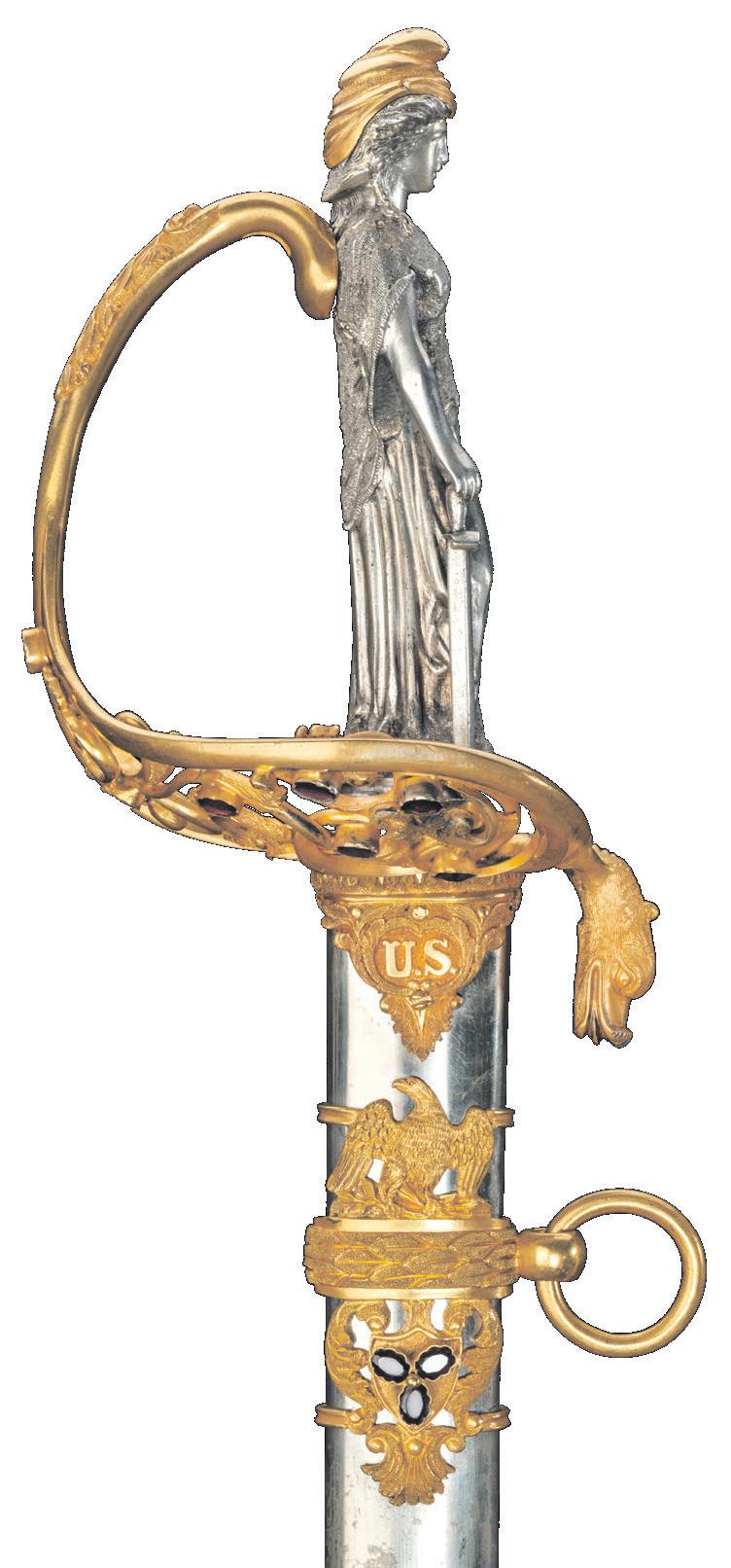
“Fields, an educational consultant and living historian, portrays General Ulysses S. Grant. He is the National Park Service representative for Grant and has played the character in films and re-enactments, including at the 150th anniversary of Lee’s surrender to Grant at Appomattox Court House, Virginia, in 2015. He is also featured as Grant and a Grant authority in the Discovery Channel’s series “How Booze Built America.”
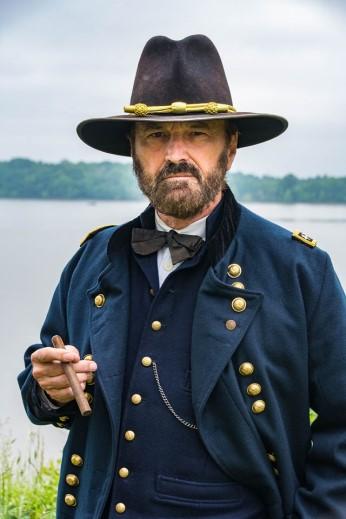

Brown, a living historian who has over 35 years of experience in business and industry, has been portraying Twain since 1996 and has appeared as the humorist more than 1,200 times. Brown has received the Studs Terkel Humanities Service Award for his portrayal of the man and his Catch the Twain program has been endorsed by the National Endowment for the Humanities and the Illinois Humanities Council.”
Rich Keppner, Education Director for the Historical Society of Quincy and Adams County, said this: “About a year ago a friend told me that she had been approached by a benefactor who wanted to sponsor a historical event for local high school students. I mentioned to her that I was aware of a production presented by Dr. Curt Fields (U. S. Grant) and Warren Brown (Mark Twain). After numerous communications back and forth, we were
delighted to schedule “Grant and Twain, the Men and the Memoirs” for students from Quincy and Hannibal. It was significant to have students from Hannibal because of Mr. Twain’s connection to that river community.
Keppner also pointed out some significant features of Quincy, Ill., in the Civil War: “...the town square where George Pickett undoubtedly walked while awaiting his appointment to the Military Academy, the same square where Lincoln and Douglas held their sixth debate; the home of Dr. Richard Eells who helped a runaway slave and who was fined by Judge Stephen Douglas; and the site of a church attended by another runaway slave, Augustus Tolton, who would grow up to become the first black Catholic priest in the United States.”
Beth Young was the event co ordinator and said this about the program, “I thought the GrantTwain presentation was very well-received by both students and adults. Fields and Brown brought both men to life con vincingly as they discussed their importance in 19th century American history.”
Beth also said, “This venture is the first of what I hope will be many other historical programs offered to Quincy’s teens; the Historical Society of Quincy and Adams County and the Tri-State Civil War Round Tables are committed to supporting this type of venture in the future. Providing special programs like this enhances the information students ordinarily receive in the classroom.”
In the planning stages by the same organizations that brought “Grant and Twain: The Men and the Memoirs” to Quincy, is the


Civil War Symposium II:

“Civil War Symposium II: Lincoln, Grant, Twain, and Guerrilla Warfare in Northeast Missouri” will be held in Quincy, on October 4-5, 2019. The tentatively scheduled event topics include the Lincoln assassination, a look at Lincoln through music and commentary, the writing and publication of Grant’s Memoirs, Tad Lincoln’s Civil War, and the war in Northeast Missouri. The symposium is free and open to the public, but RESERVATIONS ARE REQUIRED. Arrangements may be made by calling the Historical Society at 217-222-1835 from 9 a.m. – 3 p.m. M-F.
Additional information may also be obtained by using email info@hsqac.org or by checking our web-page Historical Society of Quincy and Adams County. The planned symposium should prove be an excellent program and is not to be missed if possible to attend.
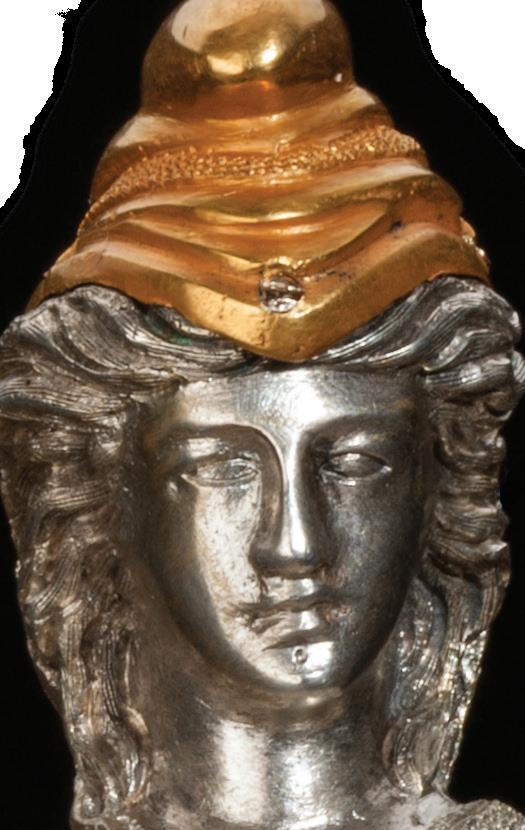
All in all, it was a good day in History in Quincy, with more to come.
Professor Veritas wishes to extend appreciation to the following people for their significant contributions to this dispatch: Beth Young- event coordinator for the HSQAC Rich Keppner- Education Program Director for HSQAC

7 October 2019 Civil War News
Buying and Selling The Finest in Americana 11311 S. Indian River Dr. • Fort Pierce, Florida 34982 770-329-4985 • gwjuno@aol.com George Weller Juno
Deadlines for Submissions is the 20th of each month. Email to: ads@civilwarnews.com
Garry Yee, author of Sharpshooters 1750–1900: The Men, Their Guns, Their Story, a book that has become an instant classic and go-to source on the subject, has a new work out from Osprey publishing. The book, Union Sharpshooter versus Confederate Sharpshooter, an 80page soft cover, is a unique study. The book’s artwork and strategic and tactical maps are superb; and Gary’s combat and tactical analysis is excellent and without peer.
In Union Sharpshooter versus Confederate Sharpshooter Yee, a former firearms and relics curator at the San Francisco




War Memorial and a trained gunsmith, selects three battles, Fredericksburg, Vicksburg, and Battery Wagner, where the tactical role of sharpshooters in the opposing armies was significant, to analyze. He begins with an overall assessment of weapons, dress, and equipment available to and used by sharpshooters of both sides; he then describes and analyzes their training and tactics before considering the particular battles. He concludes the book by discussing the aftermath of the conflict, in which, perhaps surprisingly to many, the idea of special sharpshooter units was ignored by the United States Army. Union Sharpshooter versus Confederate Sharpshooter is a must for students of military and/ or firearms history and deserves a place on the bookshelf of any Civil War buff as well.
by Joe Bilby
Buffalo Arms
With the shooting season coming to an end soon, it is probably a good time to check out the Buffalo Arms website for components and equipment to use over the winter to restock your shooting supplies and reloading bench. The Buffalo Arms website offers most anything a black powder shooter could desire, including various brands of black powder, loaded tapered percussion revolver cartridges in .36 and .44 calibers, hand cast bullets for those who do not wish to mold their own slugs, rare brass cartridge cases for reloading old time breechloaders, case cleaning devices designed to get black powder residual crud removed, and much more. Dedicated black powder shooters, whether their specialty is military or civilian arms, pre-1865 or after, should check out the company’s website at https://www.buffaloarms.com.






Cody Firearms Museum

This is not specifically a Civil War story, although William “Buffalo Bill” Cody did serve as a teamster with the 7th Kansas Cavalry in the last year of the war and generously enhanced
his reputation in the conflict’s aftermath. The Cody Firearms Museum in Cody, Wyo., has been a firearms history fan’s must see tour site for many years. Closed for more than a year for a twelve million dollar remodeling, today it is an integral part of the larger Buffalo Bill Center of the West with four other museums, the Whitney Western Art Museum, the Buffalo Bill Museum, the Plains Indian Museum, and the Draper Natural History Museum. Each museum has its own staff, advisory board and curator.
The curator of the Cody Firearms museum is Ashley Hlebinsky, who has worked at the museum for eight years and


appeared on several television series, including Travel Channels’ “Mysteries at the Museum” and Discovery Channel’s “Master of Arms.” She is also the CEO of a firearms museum consulting firm, a television producer, public speaker, and expert court witness.
George Dillman, a member of the museum’s Board of Trustees, said that “one of the objectives of the renovation was to make the firearms museum more a handson experience, especially for the non-gun enthusiast who would often leave the museum numbed by sensory overload.” Ashley had noted that many visitors had little or no knowledge of firearms or firearms history and often

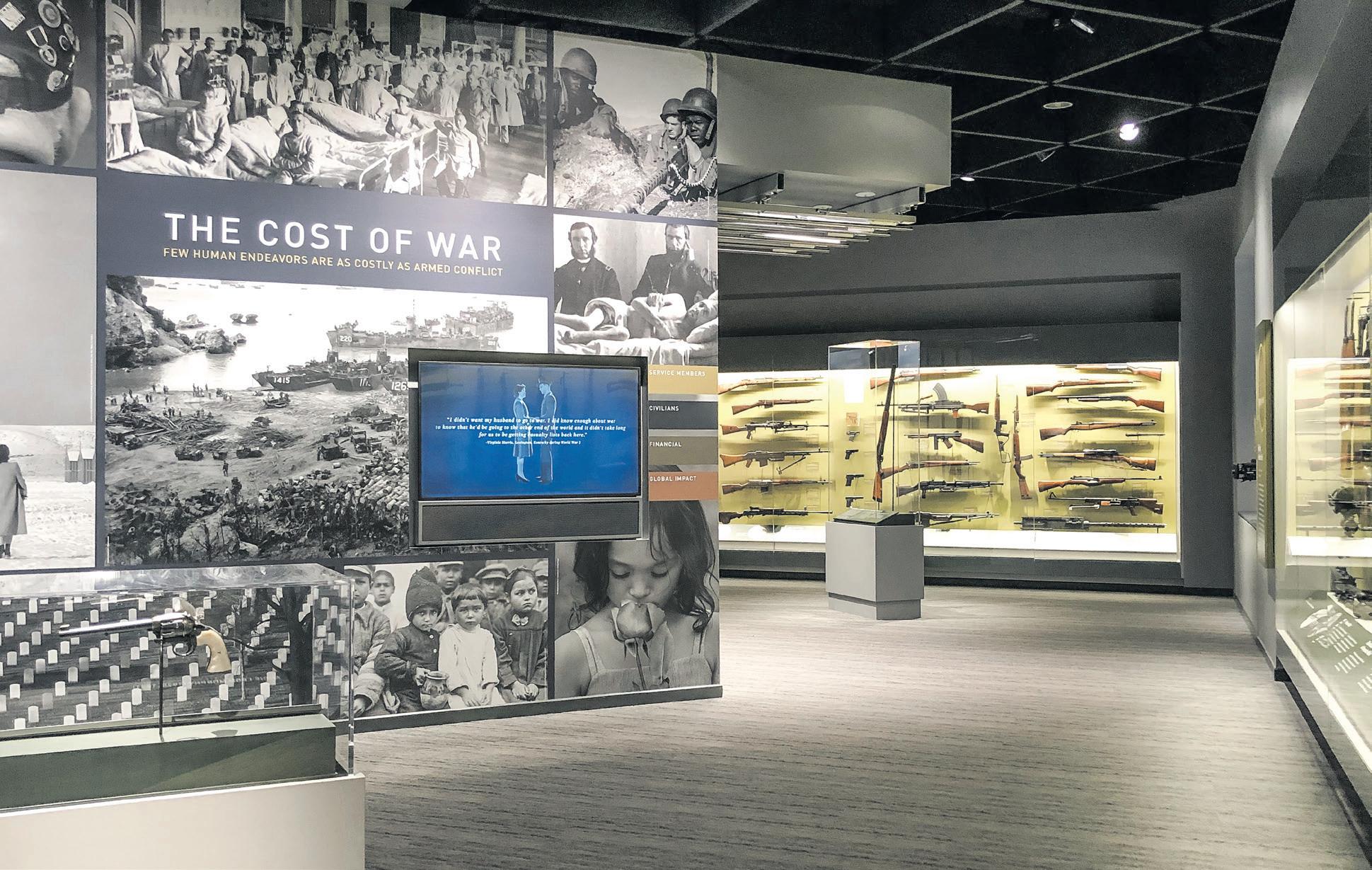
8 Civil War News October 2019
Sharpshooter Duels, Buffalo Arms and Wild Bill’s Firearms Heritage
Cody Firearms Museum “The Cost of War” exhibit. (All photos courtesy Cody Firearms Museum)
Firearms display inside “The Cost of War” exhibit.
Interactive display “Learn about History.
seemed somewhat confused or bewildered by the museum exhibitions, that problem has been solved. The new and up to date exhibits are explanatory beyond their predecessors, using video, interactive touch screens, and hands on displays to enlighten the visitor.
A recent feature article in the “Shooting Wire” online newsletter by noted gun and outdoor writer and former law enforcement and USMC officer Greg Moats noted that: “The CFM now houses 10,675 artifacts on display dating back to the 1200’s. The displays are not a random accumulation of guns; each exhibit manifests some element of historical significance due to either innovation, scarcity, or provenance. Ernest Hemingway’s Winchester Model 21, Theodore Roosevelt’s “Big Medicine” Winchester 1895, and guns of numerous other U.S. Presidents grace the halls, as do the tools of exhibition shooters and competitors of note.”

Moats also noted that “Cinematic celebrity-guns dating back to Gary Cooper’s Colt Single Action Army right up to Robert Taylor’s 1911 used on the Longmire series are on display. Matt Dillon, Paladin, and the Cartwrights’ sidearms are on display (if those names are unfamiliar, you’re either very young or suffered a mis-spent youth).” I guess my youth was not misspent.
The Cody museum also has a vastly expanded top notch military arms display, including Civil War guns. If you are traveling out west be sure to stop and pay a visit. For more information check out the museum website at https://centerofthewest.org/ explore/firearms.
Joseph G. Bilby received his BA and MA degrees in history from Seton Hall University and served as a lieutenant in the 1st Infantry Division in 1966–1967. He is Assistant Curator of the New Jersey National Guard and Militia Museum, a freelance writer and historical consultant and author or editor of 21 books and over 400 articles on N.J. and military history and firearms. He is also publications editor for the N.J. Civil War 150 Committee and edited the award winning New Jersey Goes to War. His latest book, New Jersey: A Military History, was published by Westholme Publishing in 2017. He has received an award for contributions to Monmouth County (N.J.) history and an Award of Merit from the N.J. Historical Commission for contributions to the state’s military history. He can be contacted by email at jgbilby44@aol.com.
H Chambersburg
from page 1
wife, Susan.
“Being asked to succeed Ted as program coordinator is one of the great honors of my life,” said Eric. “I say ‘succeed’ rather than ‘replace,’ because nobody can replace a legend. One can only hope to carry on and to maintain the high standards set by Ted. Knowing that, and with a great deal of humility and no small dose of trepidation, I have agreed to succeed Ted as program coordinator.”
With the transition,
H Anniversaries
from page 1
was joined by General E. O. C. Ord (Mark Day) to talk of the success and failure of attempts to cut Lee’s supply lines. General Grant talked of his desire to cut Lee’s supply arteries by taking the Weldon Railroad and extending his lines to the Globe Tavern. He also addressed the same efforts leading to the second battle of Ream’s Station. General Grant and Ord both stressed the importance of railroads in the War in general and during the Petersburg Campaign in particular.
General Grant was pleased to be joined on Sunday by his Aidede-camp as well as his personal Surgeon (Greg Eatroff and Rick Gist).
Ranger Rowland advised that the numbers of visitors for the weekend was 532. They attended four programs presented by General’s Grant and Ord, an extended caravan tour of the battles for Weldon Railroad on Saturday and Sunday, and “Confederate Rail Supply Systems in Petersburg” (Saturday-Ranger Grant Gates/Sunday-Ranger Tracy Chernault).


The second weekend anniversary observations were deemed
successful in explaining what happened at Weldon Railroad and Ream’s Station.
Ranger Rowland gave this statement to the local journalists:
“The final year of the American Civil War brought large Federal armies to Petersburg where numerous offensives were launched against the city’s railroads. For ten months, Robert E. Lee struggled to defend the city’s lifelines.
Petersburg National Battlefield commemorates the struggles of both sides that fought for control of the railroads.”
Professor Veritas would like to thank NPS Ranger Aaron Rowland for his significant contribution to this article.
“Simply put: tell the simple truth, simply.”
Professor E. Veritas

Chambersburg Civil War Seminars & Tours will no longer be necessarily tied to Chambersburg. In the future, summer programs will stay focused on the Civil War and alternate between the Eastern and Western campaigns. For July 2226, 2020, the program will cover the Battles of Chickamauga and Chattanooga with David A. Powell as the lead tour guide. The July 2021 program will focus on the Battle of Chancellorsville, and July 2022 on the Battle of Vicksburg.
This coming spring, the American History Seminar series will be held April 30-May 1 and cover the 1777 Philadelphia Campaign led by Michael Harris. This conference will shift its focus beyond the Civil War and include other conflicts including the French & Indian Wars, Revolutionary War, and others. The April 2021 Seminar will focus on the Battles of Brandywine, Paoli, Germantown, Whitemarsh, and the winter encampment at Valley Forge.
Future fall conferences will focus on Civil War topics and will remain based in Chambersburg, Pa. These events will feature intensive study of specific themes such as infantry, artillery, cavalry, and guerilla warfare.
More information about the upcoming 2020 tours can be found by visiting CivilWarSeminars.
org or by calling 717-264-7101. If you have any questions regard
ing the transition, please contact Lark Kennedy at 717-264-7101 or email her at lkennedy@chambersburg.org.
About Chambersburg Civil War Seminars & Tours
Chambersburg Civil War Seminars & Tours was founded by the Greater Chambersburg Chamber of Commerce in partnership with Ted Alexander in 1989. The programs are designed to support the local business community, attract tourism to the area, and raise funds for battlefield preservation. To date, more than $215,000 has been donated to nonprofit organizations that support the interpretation and preservation of our Civil War heritage. For more details about upcoming tours, please visit CivilWarSeminars.org or call 717-264-7101.
9 October 2019 Civil War News Subscribe online at CivilWarNews.com Deadlines for Advertising or Editorial Submissions is the 20th of each month. Email to ads@civilwarnews.com
-
. . . . . .
. . . . .
. . . . . . . . . . .
Robert E. Lee (Thomas Jessee) speaking to a crowd of participants. Ranger Aaron Rowland has his back to camera.
Even the Generals read Civil War News. General E. O. C. Ord (Mark Day) and General’s Ulysses S. Grant (Curt Fields). (CWN photo was taken by Ranger Abbi Smithmier)
Ted Alexander stands behind one of the interpretive signs at the Third Battle of Winchester.
Eric Wittenberg
California Beer
In 1864, during Sherman’s “March to the Sea,” his invading army lived on the bounty of the farmlands they marched across. For every story of subsisting on parched corn or frying a rat for want of rations, there are recollections of soldiers who wisely made friends with the local civilian population. In this way they were able to buy food or were invited to meals at civilian homes in the area. At least while the civilian population had resources to share, the stories soldiers shared in their diaries suggest abundance. One soldier reported the supper he was served included:
Warm biscuits, corn bread and honey, fried ham, stewed punkin sass (sauce), good coffee, sweet
milk, and buttermilk. We could not have had a better meal.
He was not alone; here is another similar experience from “Company Aytch.” This recollection enthusiastically describes a family style meal prepared for some men of the First Tennessee Infantry near Chattanooga in late summer, 1863, just before Chickamauga. Sam Watkins was apparently one of the men invited into this civilian home for a meal that made a lasting impression on him:


…the old gentleman invited us all to take supper with him. If I have ever eaten a better supper than that I have forgotten it. They had biscuits for supper. What! flour bread? Did my eyes deceive me? Well, there were biscuits—sure enough flour bread-and sugar and coffee—genuine
Rio—none of your rye or potato coffee, and butter—regular butter—and ham and eggs, and turnip greens, and potatoes, and fried chicken, and nice clean plates—none of your tin affairs— and a snow-white table-cloth and napkins, and white-handled knives and silver forks… We were invited to help ourselves. Our plates were soon filled with the tempting food and our tumblers with California beer. We would have liked it better had it been twice as strong, but what it lacked in strength we made up in quantity.
As for the elixir Watkins called “California Beer,” it was a fermented drink produced from water, molasses (or sorghum), and some kind of yeast (seed) as an activating agent. It sounds like the starter for a sourdough bread recipe. See the following:
SACRAMENTO, Nov. 4—A plea for a stake of “California Beer Seed” that will produce a beverage… has been received by Charles Paine, secretary of the California State Agricultural Society, from W. A. Adair of Marshall, Texas. Mr. Paine said he had no information
concerning this “beer seed,” but has appealed to the public for assistance that he may comply with the request.
Adair’s letter said:
During the Civil War, we made a home beverage called California

Available online at http://booklocker.com/books/9403.html

10 Civil War News October 2019
Noble.
534
Amazon.com and Barnes &
Hardcover,
pages. $39.95
Bealeton, Va. Noncommissioned officers’ mess of Co. D, 93d New York Infantry. (Library of Congress)
Two unidentified soldiers in Union uniforms drinking whiskey and playing cards. (Library of Congress, Liljenquist Family Collection of Civil War Photographs)
beer, made from beer seed. The seed multiplied several hundred fold monthly, is my recollection. I know that a seed the size of a grain of sugar grew to be as large as buckshot rose gradually from the bottom of the container to the top then burst into hundreds of little ones and sank to the bottom again. It was mighty good with ginger cake during the war and beat sassafras tea. As it is made of water and cheap molasses, it will beat ice tea without sugar… and it is a healthful drink much better than root beer. It never intoxicates.
That California beer concoction would certainly ferment and therefore will intoxicate if you follow this recipe and consumed enough of it. The sugar from the sorghum would result in fermentation if it was aged a while. You are to be excused if you do not find all of this as fascinating as I do. Any careful study of the material culture below Mason & Dixon’s line during the 1860s must take note of the many differences in the basic food served as well as preparation methods and how it was served.
There was a recent television series produced where a group of modern people were trying to live in a Victorian-era home with

no modern conveniences. If the thrust of it is remembered correctly, the modern contestants all nearly starved to death for lack of necessary basic culinary skills needed to cook food given the uneven temperatures produced by wood burning stoves of the era.
Craig L. Barry was born in Charlottesville, Va. He holds his BA and Masters degrees from the University of North Carolina (Charlotte). Craig served The Watchdog Civil War Quarterly as Associate Editor and Editor from 2003–2017. The Watchdog published books and columns on 19th-century material and donated all funds from publications to battlefield preservation. He is the author of several books including The Civil War Musket: A Handbook for Historical Accuracy (2006, 2011), The Unfinished
Fight: Essays on Confederate Material Culture Vol. I and II (2012, 2013) and three books (soon to be four) in the Suppliers to the Confederacy series on English Arms & Accoutrements, Quartermaster stores and other European imports.


11 October 2019 Civil War News The deadline for submissions/advertising is the 20th of each month. Deadlines for Advertising or Editorial Submissions is the 20th of each month. Email to ads@civilwarnews.com
Digital Issues of CWN are available by subscription alone or with print plus archives from 2012 at CivilWarNews.com
Emerging Civil War Presents Annual Awards
Emerging Civil War presented its 2019 ECW Awards at its annual Symposium earlier this month in Spotsylvania, Virginia.

Award recipients included:

• Historian John Coski of the American Civil War Museum in Richmond, recipient of the Emerging Civil War Award for Service in Civil War Public History;

• Historian A. Wilson Greene, recipient of the Emerging Civil War Book Award for 2018;
• C-SPAN, recipient of the Brig. Gen. Thomas Greely Stevenson Award; and

• Historian Sarah Kay Bierle, ECW’s managing editor, recipient of the Brig. Gen. Emory Upton Award.

Emerging Civil War’s Award for Service in Civil War Public History recognizes the work of an individual or organization who has made a significant impact on the field of public history in a way that helps the general public better connect with America’s defining event. “We have a strong public history mission at ECW, and we want to recognize, and offer our gratitude to, the work of others who share that same mission,” explains ECW Editor-inChief Chris Mackowski.
This year’s recipient, John Coski, is Historian and Director of Research & Publications at the American Civil War Museum, a position he’s held since 2014. Prior to that, he served in a variety of positions at the Museum of the Confederacy, including historian and director of the library and research, since 1988. He’s the author of dozens of publications, including the groundbreaking The Confederate Battle Flag: America’s Most Embattled Emblem (Harvard University Press, 2005).
Coski earned his B.A. from Mary Washington College and his M.A. and Ph.D. in History from the College of William and Mary. He worked summers at Fredericksburg and Spotsylvania National Military Park, Antietam National Battlefield, and the Colonial Williamsburg
Foundation. He has delivered more than 250 public talks, conference papers, and panel discussion commentary around the country on a wide range of topics. He recently began research toward what he hopes to be a booklength history of Belle Isle, tentatively entitled Belle Isle: Life and Death, Past and Present on America’s Founding River.
“John Coski is one of the people in the Civil War community I respect the most,” said ECW Chief Historian Chris Kolakowski in presenting the award. “Since 1988, John has been the maven of the library of the Museum of the Confederacy and its successor, the American Civil War Museum. This is an essential collection for anyone wanting to understand any aspect of the Confederate war. Everyone who has come in contact with him recognizes his expertise, his modesty and willingness to share, and his absolute professionalism.”
Kolakowski also lauded the accessibility of Coski’s scholarship.
“John Coski is a fantastic scholar on the Civil War and Confederate iconography,” he said. “His publications on the naval war and the Confederate battle flag provide superb information and important perspectives.”
The Emerging Civil War Book Award recognizes a work of Civil War history with a public history focus published in the preceding calendar year. Recipients are chosen by ECW’s stable of published authors, making the award the only peer-to-peer award given by Civil War writers to Civil War writers.
This year’s selection, A Campaign of Giants: The Battle for Petersburg (UNC Press, 2018) by A. Wilson Greene, opens a sweeping new three-volume history of the Petersburg Campaign, taking readers from Grant’s crossing of the James in mid-June 1864 to the fateful Battle of the Crater on July 30.
Greene is the former president of the Pamplin Historical Park and the National Museum of the Civil War Soldier. The author of several books, he is also a former historian with Fredericksburg and Spotsylvania National Military Park, and he is one of the founding fathers of the modern preservation movement.
“Will Greene’s A Campaign of Giants is a wonderful work done by a preeminent expert on the Petersburg Campaign,” said ECW Book Review Editor Ryan T. Quint. “For too long now, the months-long operation around Petersburg has
“The reach C-SPAN has given ECW has been invaluable.”
C-SPANs series on the Civil War is part of American History TV, which runs on C-SPAN 3 for 48 hours each weekend starting at 8 a.m. Saturdays. American History TV also airs on all holidays and in prime time when Congress is out of session. Once their Civil War programming debuts on TV, it then also become available on their website, c-span. org/history. Since American History TV officially launched in 2011, they have aired more than 600 programs related to the Civil War—including dozens of ECW segments.
been misunderstood, with only a handful of books available to help readers understand the full scope of what happened outside the Cockade City. With this first book, Greene brings the reader from the beginning of the fighting to the famed explosion of the Crater in an easily readable and more easily understood prose. We at the Emerging Civil War eagerly anticipate the follow-up books that will complete this excellent trilogy.”
Quint also announced two finalists for the ECW Book Award: Frederick Douglass: Prophet of Freedom by David W. Blight (Simon & Schuster, 2018) and Fighting Means Killing: Civil War Soldiers and the Nature of Combat by Jonathan M. Steplyk (University Press of Kansas, 2018).
The Brig. Gen. Thomas Greely Stevenson Award is presented to an individual or organization in recognition of their outstanding service to ECW. This year’s recipient was C-SPAN. For the past five years, C-SPAN has taped all or portions of each ECW Symposium.
During the award presentation, Mackowski asked the assembled audience how many of them had watched an ECW presentation on C-SPAN. All hands rose. “And I can’t tell you how many times I, or one of my ECW colleagues, has gone to speak somewhere and have had people come up to us and say, ‘I saw you on C-SPAN,’” Mackowski added.
C-SPAN and ECW share a common mission, said C-SPAN producer Russell Logan, who accepted the award. “We like to give a platform for new voices,” he said.
The Brig. Gen. Emory Upton Award is presented each year to a member of the ECW community who has performed exceptional service to the organization. “The award is essentially our staff person of the year award,” Mackowski explained.
This year’s recipient, Sarah Kay Bierle, is Emerging Civil War’s managing editor. Bierle is responsible for the day-to-day operations of the blog and oversees the work of its editorial board. She is also the author of the new ECW Series book Call Out the Cadets: The Battle of New Market. Bierle has a B.A. in History from Thomas Edison State University and is exploring and enjoying her career path as a historian, writer, and speaker. Emerging Civil War is the collaborative effort of more than two-dozen historians committed to sharing the story of the Civil War in an accessible way. Founded in 2011 by Kris White and Chris Mackowski, Emerging Civil War features public and academic historians of diverse backgrounds and interests, while also providing a platform for emerging voices in the field. Initiatives include the award-winning Emerging Civil War Series of books published by Savas Beatie, LLC; the “Engaging the Civil War” Series published by Southern Illinois University Press; an annual symposium; a speaker’s bureau; and a daily blog: www.emergingcivilwar.com.
12 Civil War News October 2019 Publishers: Please send your book(s) for review to: CWN Book Review Editor, Stephen Davis 3670 Falling Leaf Lane, Cumming, GA 30041-2087
ECW Editor-in-Chief Chris Mackowski presents the Brig. Gen. Thomas Greely Stevenson Award to producer Russell Logan of C-SPAN’s History TV.
Award-winners John Coski and A. Wilson Greene share a laugh during the Sixth Annual Emerging Civil War Symposium at Stevenson Ridge.
American Civil War Museum’s 49th Annual Literary Awards

RICHMOND, Va.—The American Civil War Museum is pleased to announce the results of its 49th annual literary awards honoring outstanding scholarship on the origins, life, and legacies of the Confederate States of America and the American Civil War.
The Calculus of Violence: How Americans Fought the Civil War by Dr. Aaron Sheehan-Dean, published by Harvard University Press, is the recipient of the 2018 Jefferson Davis Award for outstanding narrative works. Dr. Sheehan-Dean is Fred C. Frey Professor and Chair of the History Department at Louisiana State University.
The two-volume Correspondence

of Major General Emory Upton, edited by Salvatore G. Cilella, Jr., published by the University of Tennessee Press, is the recipient of the 2017–2018 Founders Award for outstanding editing of primary source materials. Mr. Cilella is the former President and CEO of the Atlanta History Center.
The Founders Award jury also named as finalists for the award


The Legion’s Fighting Bulldog: The Civil War Correspondence of William Gaston Delony
Lieutenant Colonel of Cobb’s Legion Cavalry and Rosa Delony, 1853–1863, edited by Vincent Joseph Dooley and Samuel Norman Thomas, Jr., published by Mercer University Press; and
The War Outside My Window: The Civil War Diary of LeRoy Wiley Gresham, 1860–1865, edited by Janet Elizabeth Croon and published by Savas Beatie.
A. Wilson Greene Receives Houston Civil War Round Table’s “Frank E. Vandiver Award of Merit”

HOUSTON, Texas—May 16. Continuing a 37-year tradition, the Houston Civil War Round Table (HCWRT) has awarded A. Wilson “Will” Greene the Frank E. Vandiver Award of Merit.
The Vandiver Award recognizes outstanding contributions to Civil War scholarship or preservation efforts by an individual or an institution. Presented annually, the award honors the memory of Dr. Frank Everson Vandiver (1925–2005), a renowned Civil War historian and one of the earliest members of HCWRT. Lynda Crist, a long-time member of HCWRT and editor of the Jefferson Davis Papers at Rice University, was the first Vandiver Award recipient in 1982. Other past winners include Gary Gallagher, Ed Bearss, Richard Sommers, Frank O’Reilly, William C. “Jack” Davis, Don Troiani, David E. Roth, James “Bud” Robertson, Eric Jacobson, Ed Cotham, Gordon Rhea, and James McPherson.
HCWRT selected Mr. Greene for this year’s award in view of his contributions to the historiography of the Civil War and his service as a tour guide, speaker, and preservationist over a career spanning more than 40 years. A prolific writer on Civil War topics, Will Greene is especially noted for his studies of the Petersburg Campaign. He was the Executive Director of Pamplin Historical Park and the National Museum of the Civil War Soldier in Petersburg, Va., before retiring in 2017. Prior to this position, Mr. Greene served
as historian and manager with the National Park Service for sixteen years. This service included assignments at Fredericksburg & Spotsylvania National Military Park and Petersburg National Battlefield. From 1990 to 1994, he was President and Executive Director of the Association for the Preservation of Civil War Sites (now the Civil War Trust, under the American Battlefield Trust).
In presenting the award to Mr. Greene at the May 16 meeting of HCWRT, President Mike Harrington commented, “It is truly a privilege to honor such an outstanding member of the Civil War community.” Mr. Harrington then handed Mr. Greene a large, wooden Minié ball symbolizing the award.
Visit www.houstoncivilwar. com for information about the Houston Civil War Round Table.

13 October 2019 Civil War News Publishers: Please send your book(s) for review to: CWN Book Review Editor, Stephen Davis 3670 Falling Leaf Lane, Cumming GA 30041-2087
Dr. Peter C. Luebke, U.S. Military Historian, and Christy Coleman, CEO of the American Civil War Museum in Richmond, present Salvatore Cilella his award, July 1, 2019 at the awards dinner.
HCWRT President Mike Harrington, left, with A. Wilson “Will” Greene holding the Frank E. Vandiver Award of Merit.
David vs. Goliath
“It [was] my right, if not my duty, to act the part of a belligerent.” – C.S. Lt. William T.
 Glassell
Glassell

On September 7, 1863, the Federals captured Morris Island, Charleston, S.C., after hardfought battles. Fort Sumter still anchored Confederate control of the harbor. Furthermore, the Rebels had not lost their determination to break the blockade. Instead of competing with the North’s ability to build large vessels, C.S. Capt. Francis D. Lee obtained approval to build the first assault boat in world naval history.

Lee, a successful Charleston architect, had been assigned as an engineering officer to the staff of C.S. Gen. Pierre G.T. Beauregard. Intrigued with the concept of attaching underwater explosives to enemy ships, Lee tinkered with fuses and torpedoes. With Beauregard’s encouragement, Lee designed a cooper torpedo containing one hundred pounds of gun powder. It had not one but four separate primers. Each chemical fuse was placed into a glass vial, protected by a three-inch lead tube, capped by a
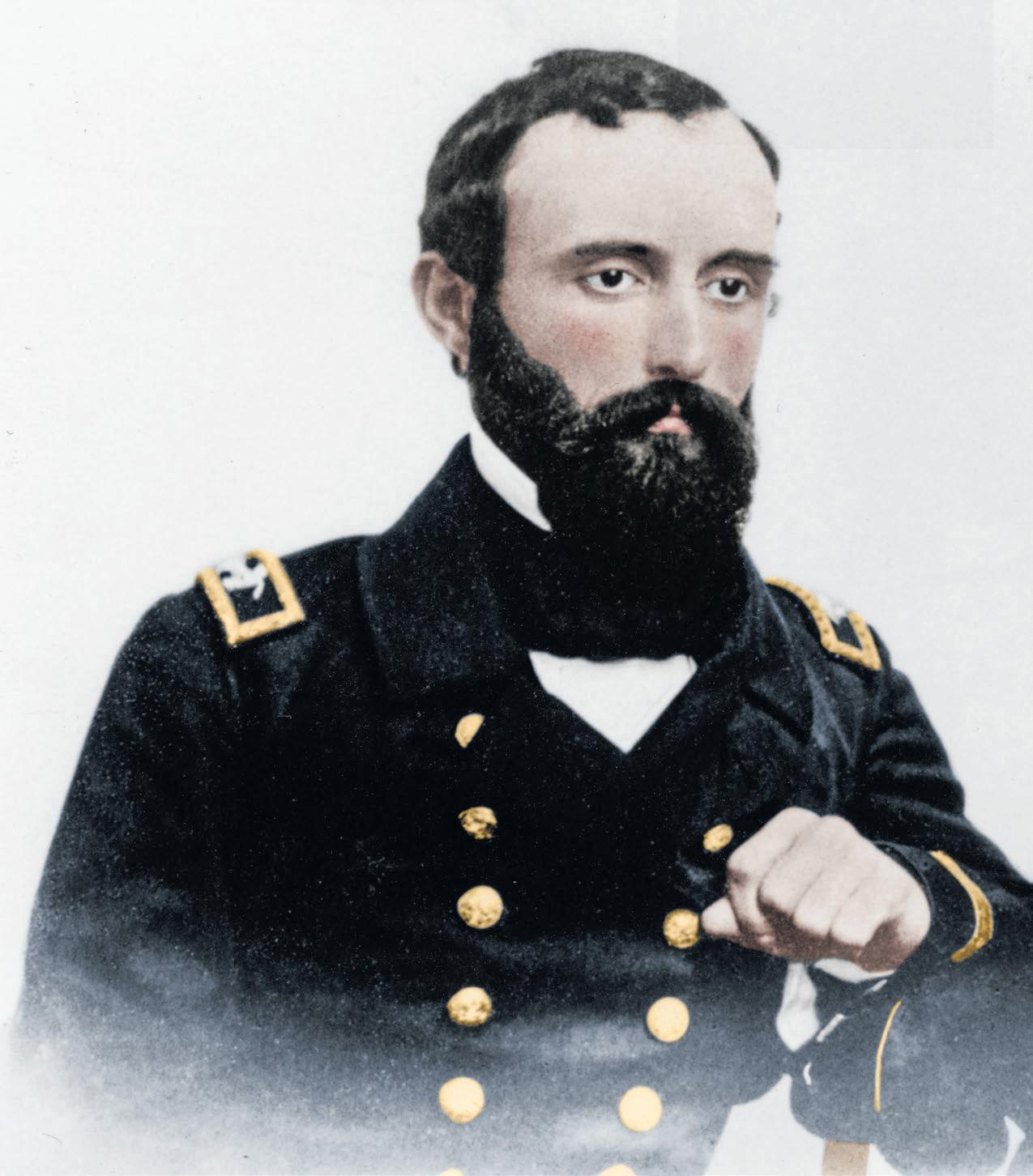
thin piece of metal. Denting the cap ignited the torpedo.
A stealth vessel was needed to come alongside the enemy ship to position the torpedo. A 50-footlong, six-foot-wide cigar shaped boat was built. Its tallest feature was an armored iron funnel. A steam engine powered the one propeller to reach 7 knots. A fourteen-foot-long, hollow iron spar to place the torpedo was attached to the bow. Ballast tanks similar to a submarine’s, enabled her to submerge, leaving only part of her deck above the water when stalking prey. Perhaps inspired by the story of David and Goliath, she was named CSS David William T. Glassell volunteered to serve as the David’s captain. The Virginia native had been serving as a lieutenant on the USS Hartford in the Pacific Ocean near Java when the vessel was ordered to return at the start of the Civil War. On arrival in 1862, Glassell was given the choice of taking a new oath of allegiance or being imprisoned at Fort Warren, Mass. Glassell
“refused to take this oath, on the ground that it was inconsistent with one I had already taken to support the Constitution of
the United States.” After eight months, he was exchanged as a P.O.W.


The David was put through training runs with her crew of Acting First Assistant Engineer James H. Tomb, James Stuart as fireman, and Walker Cannon as pilot. The boat was painted blockade running grey. To make her crew “feel safe,” four double-barreled shotguns, .36 caliber Colt “Navy” revolvers, and cork life-preservers “had been thrown aboard.”
Glassell chose October 5, during the change of tide at 9 p.m., for the attack. The water was smooth, the night misty, lit only by starlight. The vessel left Charleston wharf on the ebb-tide. She glided past Fort Sumter, the Federals’ picket-boats, and the campfires of the 20,000 troops on Morris Island. In the dark she waited until the nine o’clock signal to extinguish unnecessary lights had sounded and the
responding “music of drum and fife had just ceased” from the surrounding boats.
“It is now nine o’clock. Shall we strike her?” Glassell reportedly asked his crew. Cannon replied laconically, “That’s what we came for. I am ready.” Tomb was ready too; “Let’s go at her then, and do our best!” Sullivan agreed: “I’m with you all, and waiting. Go ahead!” The men
loaded their firearms, lowered the torpedo spar and the boat raced forward.
The target, the USS New Ironsides, had her fires banked and steam up in all four boilers, as part of blockade duty. She had been selected as she “threw a great deal more metal at each broadside than all of the monitors together.” A sentinel spotted the fast-moving, low lying craft
14 Civil War News October 2019
Portrait of William T. Glassell, ca. 1855. Colorization © 2019 civilwarincolor.com courtesy civilwarincolor.com/cwn (Orange Public Library and History Center)
Confederate David-type torpedo boat abandoned at Charleston, S.C., after the city’s capture by Federal forces, 1865. Colorization © 2019 civilwarincolor.com courtesy civilwarincolor.com/cwn. (Naval History and Heritage Command)
on their starboard side. Acting Ensign Charles W. Howard leapt to the gangway hailing, “Boat ahoy! Boat ahoy!” Not receiving a response Howard warned, “Keep off or I will fire into you.”
Now in range, Glassell responded with his shotgun, mortally wounding Howard. The David rushed forward, slamming the torpedo into the wrought iron hull at the waterline. The torpedo exploded with a deafening roar. “The huge ship trembled in every plate and spar throughout her length; rigging crashed to the deck; cannon leaped from their moorings; shot and shell scattered across the decks, rolling as the vessel heeled violently to port.”
The blast threw an enormous plume of water into the air, falling on both boats and down the David’s smokestack extinguishing her engine fire. Both sides thought their vessel might sink. Glassell ordered his men to abandon ship. The crew leapt overboard wearing their cork vests. The Ironsides’ Marines rushed to fire their rifles and pistols at their fleeing foe.
Glassell and Tomb swam away. Sullivan would be captured while clinging to the Ironsides’ rudder chains. Cannon, unable to swim, climbed back into the David as it drifted away. The Ironsides fired
two 11-inch shells at the vanishing craft. Cannon plucked Tomb out of the water. Tomb restarted the engine and the David steamed back to Charleston.
Glassell, swiftly swimming out of firing range, found himself alone in the cold water. He was picked up by a schooner and transferred to the guard ship USS Ottawa. Glassell and the Ottawa’s captain, Lt. William D. Whiting, knew each other from the “old” Navy. Glassell would be grateful for the connection. Whiting arranged for him to give his word not to escape instead of transporting him in chains. U.S. Adm. John Dahlgren considered, “It is desirable that this Officer should not be allowed to return here until some time has elapsed, as he could not fail to be of great service to the enemy in future operations of the same kind.” P.O.W. Glassell was returned to Fort Warren and promoted by the Confederates for “gallant and meritorious service.”
Dahlgren joined the Ironsides’ crew to inspect the damage. The torpedo had struck under number six starboard gun where the coal bunker gave her additional support. Aside from the “stores thrown in confusion,” the ship suffered minor damage overall. Her assistant engineer, William S. Wells, speculated that, “If the

Civil War Catalog
Featuring a large assortment of Civil War and Indian War autographs, accoutrements, memorabilia, medals, insignia, buttons, GAR, documents, photos, & books. Please
torpedo had struck the ship on the port side we would certainly have gone down,” since the main condenser overboard discharge was “just on a line with the point where the torpedo struck on the starboard side.”
Dahlgren, the inventor of the Dahlgren gun, was impressed. “Among the many inventions with which I have been familiar, I have seen none which have acted so perfectly at first trial. The secrecy, rapidity of movement, control of direction, and precise explosion indicate, I think, the introduction of the torpedo element as a means of certain warfare. It can be ignored no longer. If 60 pounds of powder, why not 600 pounds?”
Sources:
• Tomb, James H. Engineer in Gray: Memoirs of Chief Engineer James H. Tomb, CSN
• Glassell, William T. “Reminiscences of Torpedo Service in Charleston Harbor”, Southern Historical Society Papers
• Luraghi, Raimondo. A History of the Confederate Navy
• Roberts, William H. USS New Ironsides in the Civil War
• Perry, Milton F., Infernal Machines: The Story of Confederate Submarine and Mine Warfare
Stephanie Hagiwara is the editor for Civil War in Color.com and Civil War in 3D.com. She also writes a column for History in Full Color. com that covers stories of photographs of historical interest from the 1850’s to the present. Her articles can be found on Facebook, Tumblr and Pinterest.
By Bradley M. Gottfried, Ph.D.
I prepare detailed map atlases of Civil War campaigns—six are in print and a couple are on the way. I visit battlefields multiple times as I work on each volume. Sometimes I am pleased by what I see and sometimes not. Gettysburg is a prime example, where virtually the entire battlefield is preserved. Then there is Fredericksburg, where development has engulfed the sacred ground traversed by wave after wave of Union troops attempting to capture Marye’s Heights on December 13, 1862. The Wilderness is another example of development destroying pivotal parts of a battlefield. In this case, it is a gated high-end housing development that does not permit visitors to even walk the sacred ground—at least, what is left of it. Much of the fighting on May 6, 1864 occurred within its boundaries, including the unfinished railroad cut which General Longstreet’s men used to roll up the Union flank on May 6, 1864. Salem Church is still another example of unbridled and unregulated growth almost completely destroying an important battlefield, leaving only its namesake untouched.
That’s why when invited to join the Board of Directors of the Central Virginia Battlefield Trust (CVBT), I jumped at the opportunity. Like a growing number of regional preservation groups, the CVBT concentrates on a specific area. All of the examples above are areas of CVBT’s focus. Because of their efforts, a major portion of the Chancellorsville battlefield is now preserved. They were also instrumental in protecting Willis’ Hill and other important portions of the Fredericksburg battlefield, such as Pelham’s Corner. More recently, they have purchased important parcels on the Wilderness battlefield.

I am most excited about their recent work at Spotsylvania. Large portions of this battlefield remain undeveloped, but the building trend will soon overtake any unprotected portion. The CVBT moved quickly to purchase over fourteen acres along Brock Road that was pivotal during the opening phases of this battle. When the owner of Myer’s
Hill indicated a willingness to work with the CVBT to purchase the 73-plus acres, the organization worked with him on a financial agreement that will preserve this important battlefield. This parcel contains a pristine battlefield where General Emery Upton and his brigade were pushed off the top of the hill by a coordinated Confederate attack. General George Meade watched the action here and was almost captured by the surging Confederates. Because of the CVBT, this important battleground will be protected in perpetuity.
I especially appreciate the fact that the organization can and does move quickly to secure property as it comes on the market. The U. S. Park Service may have the funds to purchase land, but is usually not able to move quickly to secure it. As a result, the two entities work closely to ensure that important battlefield lands are being protected. Readers should also know that the CBVT does not simply sit back and wait for land to come on the market. It regularly identifies desirable land and contacts owners to see if they are interested in selling the property. This proactive approach has effectively kept a number of important properties off the market. The CVBT has also received a number of donations of sacred land, including the position of the Norfolk Artillery on the Fredericksburg battlefield.
Because I moved to Pennsylvania and could no longer be an active participant of the CVBT, I reluctantly stepped off the Board. My support for the organization remains strong as I continue to support it financially and through cartography. It is only through the support of its members can the CVBT continue its vitally important work. For further information please see its web site at www.cvbt.org.
15 October 2019 Civil War News Digital subscriptions available online at CivilWarNews.com
visit our fully illustrated online
Free copy mail catalog Mike Brackin PO Box 652, Winterville, NC 28590 • 252-565-8810
catalog at www.mikebrackin.com
David torpedo boat in front of John A. Alston’s mansion, on Chisolm’s Causeway by photographer Selmer Seibert, March 23, 1865. (National Archives)
Subscribe online at CivilWarNews.com
Why I Support the Central Virginia Battlefield Trust
Life and Reminiscences of General Wm. T. Sherman:
By Distinguished Men of His Time.
“To you is dedicated this memorial volume of your honored and much-loved leader, William Tecumseh Sherman,” or so editor and compiler Thomas Clement Fletcher wrote in 1891, with the release of a rather interesting collection of testimonials from various individuals who knew Sherman well. R.H. Woodward
& Company in Baltimore published the original edition, but researchers can easily locate affordable reprints. In addition to the accounts detailed below, 16 illustrations appear in the book, including some not often seen in other works; see illustration below.

Fletcher penned the introduction of the book and then wrote the first eight chapters. The titles of each chapter: ‘His Life Before the War,’ ‘During the War,’ ‘After the War,’ ‘His Life in New York,’ ‘His Humorous Side,’ ‘His Last Sickness and Death,’ ‘The Funeral,’ and ‘His Character.’ Fletcher, a Missouri native,
served in St. Louis as assistant provost marshal general until October 1862, when he received a colonel’s commission in the 31st Missouri Volunteers. He later commanded the 47th Missouri Volunteers. His wartime service did not take him through to the final surrender ceremonies, as the good folks of Missouri elected him to serve as their state’s 18th governor. While Fletcher’s contributions to the narrative offer a general overview of Sherman’s life and career, the real value of this source rests in the book’s second section—Reminiscences and Tributes.
The following gentlemen contributed various accounts of their experiences with Sherman, Horatio G. King, George W. Childs, Oliver Otis Howard, Hiram Hitchcock, David Dixon Porter, Horace Porter, Chauncey M. Depew, Benjamin Harrison, Reverend T. DeWitt Talmage, George A. Knight, Henry Slocum, Senator John Morgan of Alabama (a former Confederate officer), Senator Joseph Hawley of Connecticut (Brevet Major General in the U.S. Army during the war), Carl Schurz, Rutherford B. Hayes, and Charles F. Manderson. Most of these fellows had served in various capacities
with Sherman during the war. A few penned brief remarks, two or three pages; others wrote more detailed accounts. For example, O.O. Howard discussed his working relationship with Sherman during the March to the Sea and during the Carolinas Campaign. Howard’s final analysis on Sherman: “As a military leader he was, in my judgment, one of the greatest that ever lived, and the only General in the war who was a genius.” Ponder how other generals, including those also contributing to this narrative, might have felt after reading Howard’s assessment!
Admiral David Porter offers a tongue-in-cheek account of the first time he met Sherman while the Federals continued their work to take Vicksburg. Porter recalled he “…put on my uniform coat, the splendor of which rivaled that of a drum major.” Sherman entered Porter’s quarters on board his ship, dressed in an old “… blue flannel suit.” Porter concluded with, “…we met, both a little surprised at the appearance of the other.”

Fletcher allowed the subject of the book to also contribute to the effort, and “Cump” wrote the final six sections of this book, which appeared labeled as the ‘Appendix.’ His installments carry the following titles, ‘Old Time in California;’ ‘Grant, Thomas, Lee;’ Our Army and Militia;’ Camp-Fires of the G.A.R.;’ ‘Response of General Sherman; and ‘Sherman on Longstreet.’ Perhaps Sherman’s greatest observations rest in the section on ‘Grant, Thomas, Lee,’ where he strikes favorable comparisons toward each officer. Equally fascinating are Sherman’s comments regarding James Longstreet. “Longstreet went into the Confederate army
from an impulse – honest, enthusiastic and positive – and when the war was over I know of my own knowledge that he stood up like a man to regain for his whole country the condition of law and prosperity which had been so foolishly and recklessly jeopardized by the civil war.”
Researchers can view the book online at https:// quod.lib.umich.edu/m/moa/ acp5097.0001.001/1?view=image&size=100, purchase a reprint at various online bookstores, or locate a copy in their local library using https://www.worldcat.org. Search for the book’s title, as ISBN numbers vary depending on the various publishers cranking the book out over the years.
Next month, we will explore additional primary sources. Until then, good luck in researching the Civil War!
Michael K. Shaffer is a Civil War historian, author, lecturer, instructor, and a member of the Society of Civil War Historians, the Historians of the Civil War Western Theater, the Georgia Association of Historians, and the Georgia Writers Association. Readers may contact him at mkscdr11@ gmail.com, or to request speaking engagements, via his website www.civilwarhistorian.net. Follow Michael on Facebook www.facebook.com/michael.k.shaffer and Twitter @michaelkshaffer.

16 Civil War News October 2019
Deadlines for Advertising or Editorial Submissions is the 20th of each month. Email to: ads@civilwarnews.com
Sherman’s Army Leaving Atlanta illustration from the book.
Charleston’s First Memorial Day: Forgotten No More
 By Stephen Davis Special to Civil War News
By Stephen Davis Special to Civil War News
History, if you’ll pardon a digression, can be like a rock ‘n’ roll hit. An artist writes and records a song, but it only catches on when, say, the Beatles cover it on one of their albums; I’m thinking of Chuck Berry’s “Rock and Roll Music” here.
Let me explain.
Forty years ago I read Paul Buck’s The Road to Reunion 1865–1890. Here, from page 116:
Especially did it seem fitting that the lonely graves of Federal soldiers buried in the South should be remembered. Small groups of Unionists, sometimes an individual alone, performed the rite in communities scattered throughout the South. Frequently Negroes joined in bringing flowers to the graves of their deliverers. One such occasion transcended others in importance, and, attracting nation-wide attention, introduced the idea of Memorial Day to the North. In Charleston, South Carolina, on May 30, 1865, James Redpath led a throng of Negro school children to the bleak spot near the city where rested the remains of several hundred Union soldiers in four long trenches. Quietly the ugly mounds were covered with flowers strewn by black hands which knew only that the deceased they were honoring had raised them from a condition of servitude.
Road to Reunion was published in 1937, so knowledge of Charleston’s freed people honoring the graves of Northern soldiers has been around a good while. In his book Confederate Charleston, Robert Rosen featured a woodcut illustration of a Northern soldier tending graves of Union prisoners buried at Charleston’s Race Track, whose grounds during the war had been turned into a POW camp. Rosen rightly terms this observance “the first Union Memorial Day ever.” The illustration was published in Harper’s Weekly on May 18, 1867; Rosen’s book was published in 1994.

Now for the Beatles part. “For years, the ceremony [at the Race Track] was largely forgotten,” writes Brian Hicks in the Charleston News and Courier. “It had been mentioned in some history books, including Robert Rosen’s ‘Confederate Charleston,’ but the story gained national attention when David W. Blight, a professor of American
history at Yale, took an interest. He discovered a mention of the first Decoration Day in the uncataloged writings of a Union soldier at a Harvard University library.” Dr. Blight wrote about his discovery in the New York Times a few years ago. “The largest of these events,” speaking of blacks’ commemoration ceremonies, was “forgotten until I had some extraordinary luck in an archive at Harvard.”
I never met John, Paul, George, or Ringo, but I remember very clearly the day I met David Blight.
In October 2002 Emory was hosting a multi-day conference on lynching and racial violence in America. I heard that Professor Blight, then at Amherst, was scheduled to participate in a panel. I was teaching a course at Oglethorpe University on Americans’ memory of the Civil War, and was using Professor Blight’s Race and Reunion: The Civil War in American Memory (2001) as my class text. I wanted him to sign my copy. So I got out of work that morning to drive to Emory. I got there early and sat on the front row so I could catch his eye when he walked in.
David Blight was Professor of History and Black Studies at Amherst, so I looked for an African American. Instead this white gentleman walked onto the podium and finally I guessed it was Professor Blight. I walked up, introduced myself, and asked if he would inscribe my book. He kindly agreed as I opened my paperback. He remarked that its pages were brown and waffled. I explained that while preparing material for my class I had taken his book to the beach and dropped it in the surf.
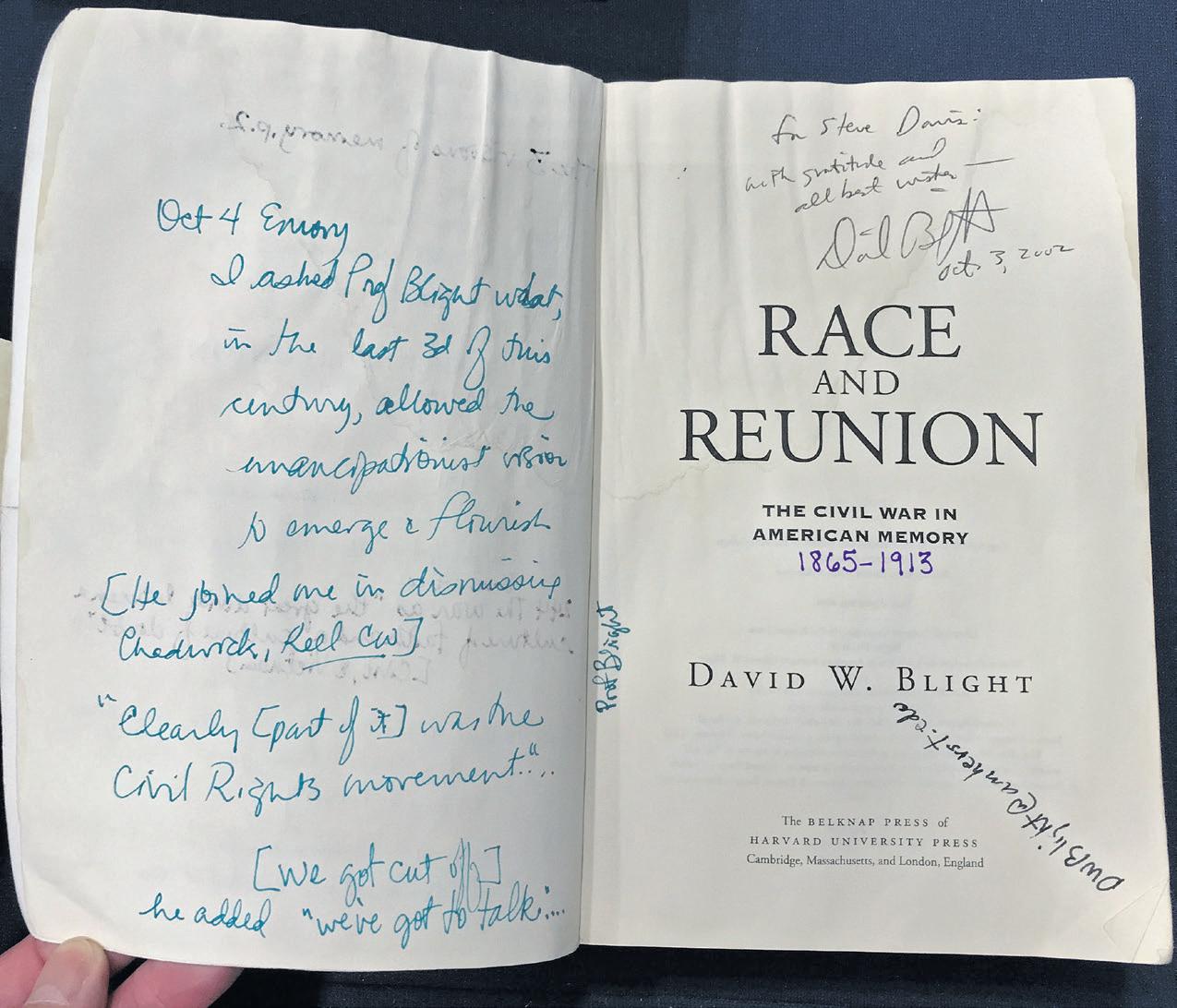
He turned excitedly to the professor next to him: “HE TOOK MY BOOK TO THE BEACH!”
We talked on till we were cut off. I noted that before I left the podium he remarked “we’ve got to talk.” Professor Blight and I exchanged e-mails for a while afterward.
So David Blight covered Paul Buck’s rendition of the Race Track commemoration, and made it a national hit. Actually, the story can be traced back to the Charleston Daily News of May 2, 1865. In an article titled, “The Martyrs of the Race Course,” the paper related that on the day before, a huge crowd had gathered to consecrate the burial ground of 257 Union soldiers. An estimated 10,000 people were in attendance, “mostly of the colored population.”
African Americans, newly freed in Charleston, had organized as “Friends of the Martyrs” and the “Patriotic Association of Colored Men.” They had worked to improve the burial grounds. Then they arranged a big public dedication. James Redpath, General Superintendent of Education in occupied Charleston, assisted.
The ceremonies included a procession into the cemetery, where everyone carried a floral bouquet. “The colored children, about twenty-eight hundred in number, marched first over the burial ground strewing the graves with their flowers,” the newspaper declared.
Then came the Patriotic Association—one hundred men. Two hundred more represented the Mutual Aid Society, an organization formed for seeing to the proper burial of “poor colored people,” as the Charleston Daily News attested.
A Psalm from the Bible was read, a prayer delivered, a hymn sung. School children sang “The Star Spangled Banner” and “America.” “The graves at the close of the procession,” the Daily News article concluded, “had the appearance of a mass of roses.”
Jack Melton and I are working on a book of photographs depicting Charleston in the war, similar to our recently published 100 Significant Civil War Photographs: Atlanta Campaign. Look for this book, 100 Significant Civil War Photographs: Charleston in the War, and other stories when our book is published later this year.
17 October 2019 Civil War News
My copy of Professor Blight’s book, inscribed by him in 2002.
Union soldiers’ graves at the Charleston Race Track.
May 18, 1867, Harper’s Weekly, p. 309, is titled “The Martyrs of the Race-Course—Union Prisoners’ Cemetery at Charleston, S.C.—Sketched by A. R. Waud.”
Native New Yorker Survived Pickett’s Charge – with the 11th Virginia Infantry!
By Joe Bordonaro
Visitors to Fairfield Cemetery in Spencerport, N.Y., may be surprised to see a Southern Cross of Honor and a Point Lookout Survivor’s marker on a gravestone. The grave is that of DeWitt Clinton Guy. He was born in Lockport, N.Y., in 1842 and named after the then-governor of New York, DeWitt Clinton. Guy and his family returned to their former home near Lynchburg, Va., after his father’s death while
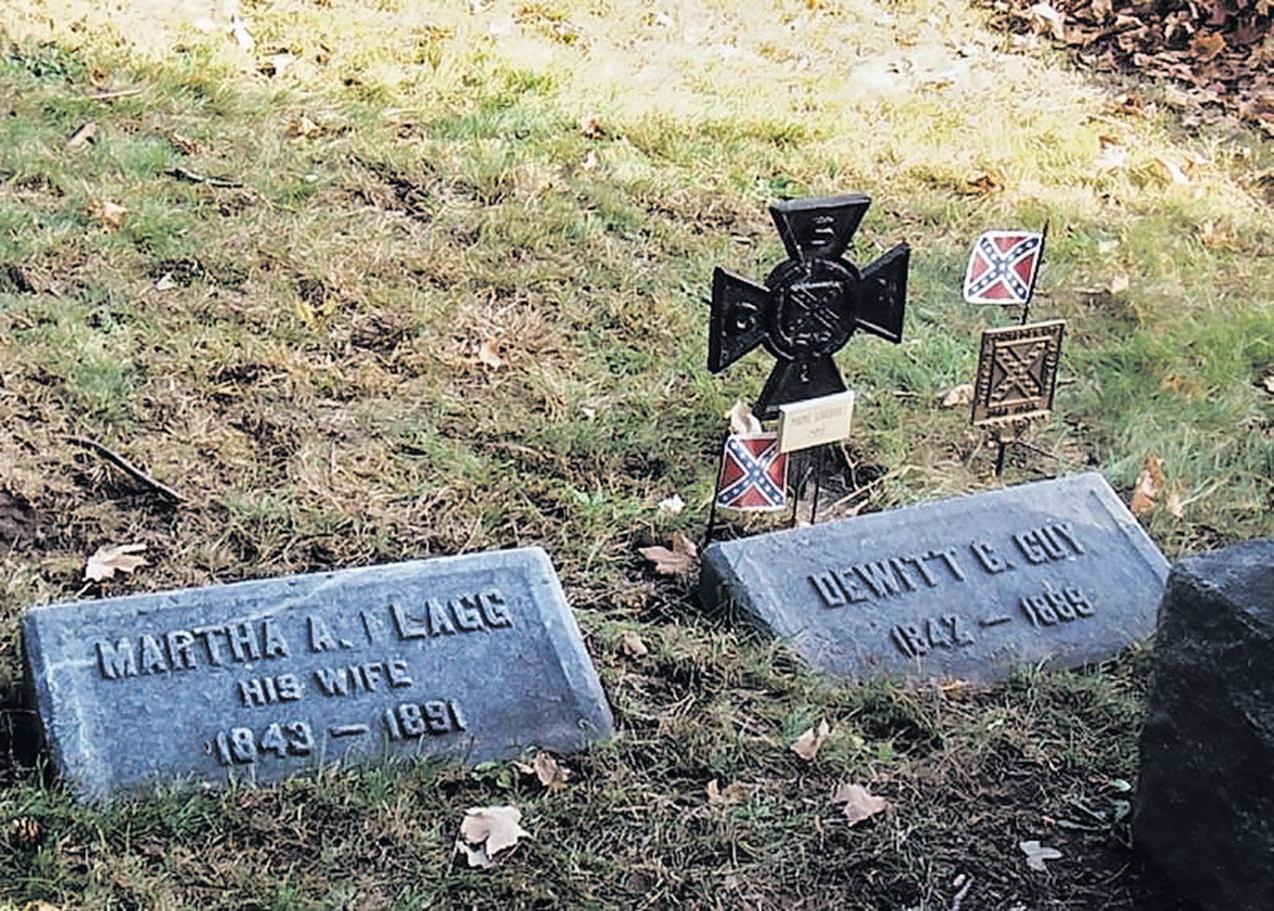
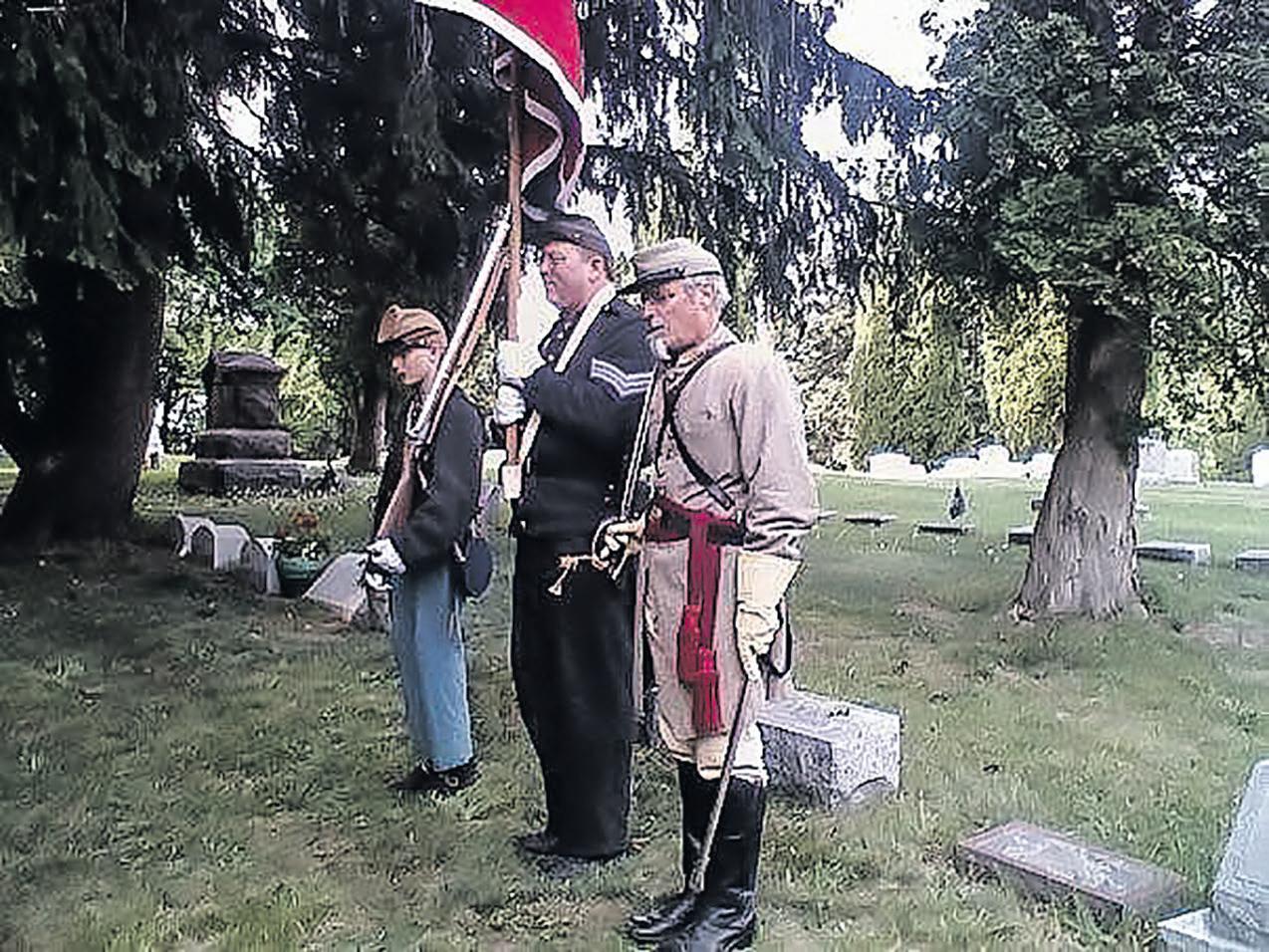
working on an Erie Canal lock. So it was that on April 23, 1861, Guy joined the Lynchburg Home Guard, later to become the 11th Virginia Infantry. The following information was supplied by Mrs. Charles A. Hutton, of Churchville, N.Y. She is a descendent of DeWitt Guy: “(Guy) saw hard service, fighting a major engagement nearly every month until his capture at Five Forks on April 1, 1865. Guy saw action at First and
Second Manassas, Williamsburg, Frazier’s Farm, Malvern Hill, Sharpsburg, Chancellorsville, Gettysburg, Brandy Station, Drewry’s Bluff, and Five Forks. The 11th participated in Pickett’s Charge as part of Kemper’s Brigade, Longstreet’s Corps, Army of Northern Virginia. Their losses in this charge were high: 18 men killed, 95 wounded, 73 captured, and six missing in action. DeWitt Guy was wounded three times. After an injury in the Battle of Seven Pines on May 31, 1862, he returned to service and was promoted to the rank of Sergeant on November 16, 1862. He was wounded on July 3, 1863, in the grand charge at Gettysburg, then again at Drewry’s Bluff on May 16, 1864. Captured at Five Forks, Guy was sent to Point Lookout, Md. He was released from that Union prison camp on June 12, 1865.”
After his release from prison, DeWitt returned to New York and married his childhood sweetheart, Martha Flagg. They moved to Lynchburg, Va., but often traveled back to Western New York to visit Martha’s family.
After DeWitt’s death in 1889 at the young age of 47 (like many Civil War soldiers, DeWitt died young, probably as a result of wounds suffered, exposure to the elements, poor diet, and other hardships), he was buried in Lynchburg. Honoring Martha’s dying wish (she died in 1891), her sister had DeWitt’s remains moved to Fairfield Cemetery and laid them to rest next to his wife’s grave.

Perhaps hoping to avoid
still bitter enemies desecrating DeWitt’s grave, it was left unadorned for over 100 years. In 2000, a Southern Cross of Honor and a Point Lookout Survivor’s marker were installed on the grave. A ceremony was held that included relatives, reenactors, and local residents. In 2005, a Civil War reenactment group was started in Guy’s honor. The photos show some of its members engaged in a “Silent Vigil” at Sgt. Guy’s grave.
Joe Bordonaro is a USAF veteran (1973–1977), Glassboro State College graduate (1980), Catholic school teacher (St. Joseph’s ProCathedral, 1983–1988), and retired public school teacher (Mullica Township School, 1988–2009). He has been involved with Civil War reenacting/living history since 1999. Joe began submitting articles to the Civil War News in 2005 and has been covering events for the News on a regular basis since 2016. Joe lives in Mount Laurel, NJ, and has been married to his wife Karen for 29 years. If you wish to contact Joe, you may send an email to joe1861@gmail.com.
Civil War Artillery Book
New 392 page, full-color book, Civil War Artillery Projectiles – The Half Shell Book.

For more information and how to order visit the website www.ArtillerymanMagazine. com or call 800-777-1862.
$89.95 + $8 media mail for the standard edition.
18 Civil War News October 2019
Confederate Sergeant DeWitt Clinton Guy. Courtesy of Mrs. Charles A. Huttton.
Members of the 11th Virginia hold a Silent Vigil at Sgt. Guy's grave site. (David Berndt)
Sergeant Guy’s Grave Stone. (David Berndt)
Confederate 2nd Model LeMat Revolver

 By Shannon Pritchard
By Shannon Pritchard
The LeMat “grapeshot” revolver was a highly prized sidearm among Confederate officers. Developed in 1856 by Jean Alexandre LeMat of New Orleans, this weapon was a very high-quality firearm and delivered an unprecedented amount of firepower. There were less than 3,000 made for the Confederacy in Liège, Belgium, and Paris, France. The LeMat had nine, .42 caliber chambers rotating around one 20 gauge shotgun barrel. The hammer could be converted from striking the revolving pistol caps to striking the central shotgun cap with the flick of a thumb.

The weapon shown here is a second model. The most recognizable differences between the first and second models are the lack of a spur trigger guard, swivel lanyard ring, and a left side mounted loading lever assembly on the second model.
The pistol shown here is serial number 1270 and marked “Col LeMat BTE SGDG PARIS.” This example is more fully marked with serial numbers than most examples and all numbers match. Serial numbers are located on the cylinder, frame, barrel, shotgun barrel, barrel lock lever, and rammer assembly; even including the shotgun rammer. The revolver’s action is crisp; it

indexes properly, and locks firmly. The barrel markings are clear and sharp; it has sharp edges and good lines. Its only downside is that some inexperienced person tried to take it apart and marred some screw heads.

As they say, if only this one could talk; the revolver`s cylinder is fully loaded and four caps remain in place. Even the shotgun barrel is loaded. There is a chip knocked out of the left grip and something struck the pistol so hard that it broke one nipple and deeply indented the cylinder; both of these battle scars are shown in the photographs. Perhaps when it was struck, it was knocked it out of the owner’s hand while still fully loaded. The weapon had seen little service when this occurred as the nipples and hammer have been struck very little, leaving the revolver in very good condition.
Shannon Pritchard has authored numerous articles relating to the authentication, care and conservation of Confederate antiques, including several cover articles and is the author of the definitive work on Confederate collectibles, the widely acclaimed Collecting the Confederacy, Artifacts and Antiques from the War Between the States, and is co-author of Confederate Faces in Color.

19 October 2019 Civil War News
Right side of LeMat revolver serial number 1270. (Photos courtesy Old South Antiques)
Engraved patent information and Paris address on top of barrel.
Note the lead balls seated into the cylinder. Three percussion caps are still seated on the nipples. Notice the broken nipple.
Left side of revolver showing broken nipple and damage to the cylinder
Prang and Company: Sheridan’s Ride October 19, 1864
The Graphic War highlights prints and printmakers from the Civil War discussing their meaning and most importantly, the print maker or artist’s goals.
Last month’s column highlighted the lithographic firm of Kurz and Allison. Their head to head competitor was the firm of Louis Prang and Company. Both firms operated through most of the last quarter of the 19th century and produced many subjects beyond the Civil War. Insipid greeting cards, Valentine cards, advertising (where most of the money was), and soppy “sentimentals” were the stock in trade of both firms. But the two approached their subject matter much differently and whether or not their strategies were intentional, their products were so different as to make them unmistakable.
Like other lithographic businessmen, Louis Prang was an immigrant. He was born in 1824 in Breslau, Prussian Silesia. With the European revolutions of 1848, he first went to Switzerland, and then in 1850, the United States.1 Six years later he joined Julius Mayer in Boston to form the Prang and Mayer enterprise in 1856. When the war came, the firm continued to produce the
usual products for mass consumption and oddly enough, war maps for American newspapers.2 As Currier and Ives continued to print timely, if highly dramatic and inaccurate depictions of the latest battle, Prang did not turn to war subjects until the 1880’s as Kurz and Allison began to compete with them. Like Kurz, Prang was interested in chromolithography as a means to produce and reproduce “art.”
Chromolithography, essentially “printing in colors” as opposed to printing in black and white followed by hand coloring, allowed greater freedom to use color, which made “up the picture itself.”3 One major “war” exception was Prang’s collaboration with the iconic American painter, Winslow Homer. The two produced Civil War scenes entitled Campaign Sketches in 1863, “spirited camp scenes sketched on the spot.”4


In the early 1880’s, Kurz and Allison produced their first battle art, “The Battle of Gettysburg,” based on the Gettysburg Cyclorama. According to most sources, this prompted Prang to develop his eighteen Civil War scenes which he called “Prang’s War Pictures: Aquarelle Facsimile Prints.”5 They were
equitably depicted, six naval images, six western theater scenes, and six eastern theater clashes. Whereas Kurz printed various images throughout the 1880’s, Prang issued all eighteen in his portfolio in 1885-6.
The most famous was Sheridan’s ride during the Battle of Cedar Creek as he rallied Federal troops on October 19, 1864, as they faltered from Jubal Early’s withering surprise attack in the Confederacy’s last major Shenandoah Valley engagement. Sheridan had pushed Early out of Winchester in the 3rd Battle of Winchester or Opequon Creek on September 19, then followed up at Fisher’s Hill four days later. Both armies moved up the Valley and came to rest near the two forks of the Shenandoah River where Massanutten Mountain towered above the valley.
On the morning of October 19, 1864, Early launched a dawn assault that scattered the Federal troops. Sheridan was in Winchester at 6 a.m. and when
word reached him about the severity of the renewed Confederate initiative. By 10:30, he was up the Valley rallying the Union forces forward, an action which won the day and became the stuff of legend.
By virtue of this print, Sheridan’s reputation was sealed as a member of the national trio including Sherman and Grant as saviors of the Union. Sheridan had turned a Yankee route into a Yankee victory. Artist Thure de Thulstrup, a Swedish officer in the French army before immigrating to America in 1873, captured the moment. Although error filled; Sheridan is shown waving a flag not his hat and with a mustache that came later. He got the endorsement of at least one veteran who thought he “attained an exceptional degree of realism.”6
After the release of his portfolio, Prang went on to enjoy a long career expanding the technique of chromolithography. According to author Jay Last, Prang developed many new lithographic production and sales techniques, introduced Christmas cards to America, and became the key American producer of greeting cards.” He retired to Los Angeles where he died in 1909. De Thulstrup passed away in New York during 1930 leaving no survivors or papers. He had a long career at Frank Leslie’s Weekly, Harper’s Weekly, and the Graphic. At Harper’s he worked closely with Thomas Nast. Sheridan went on to an illustrious career fighting Indians in the West. Thanks to both Prang and Thulstrup, he was immortalized artistically.
Endnotes

1. “Louis Prang,” The New York Times, (Obituary), June 16, 1909.
2. Katherine Morrison McClinton, The Chromolithographs of Louis Prang. New York: Clarkson N. Potter, 1973, 4.
3. Peter Marzio. Chromolithography, 1840–1900: The Democratic Art, Pictures for a 19th Century America. Boston: David R. Godine, Publisher. 1979, 11.
4. Ibid, 144.
5. Harold Holzer, Mark E. Neely, Jr. The Union Image: Popular Prints of the Civil War North, Chapel Hill: The University of North Carolina Press, 2000, 213.
6. Ibid., 188ff (Caption).
7. Jay T. Last. The Color Explosion: Nineteenth-Century American Lithography. Santa Ana: Hillcrest Press, 2005, 122.
8. “Thulstrup, Artist, Dies in 83d Year,” The New York Times, (Obituary), June 10, 1930.
After 43 years in the museum field, Salvatore Cilella now spends his time writing. He is the author of several articles and books. His most recent books are Upton’s Regulars: A History of the 121st New York Volunteers in the Civil War (U. Press Kansas, 2009) and The Correspondence of General Emory Upton, 1856–1881 (U. Tennessee Press, 2017) edited. He is editing a manuscript of Upton’s letters to his wife 1868-70, which the Oklahoma University Press will publish late 2019, or early 2020. His last professional position was President and CEO of the Atlanta History Center.

20 Civil War News October 2019
Sheridan’s ride by Thulstrup. Print by L. Prang & Co. (Library of Congress)
— MAKER — LEATHER WORKS Museum Quality “Raising The Standard” Made In The USA Visit us at www.DellsLeatherWorks.com • (845) 339-4916 Dedicated to the Common Soldiers Who Fought in The War Between The States AUTHENTIC QUALITY REPRODUCTIONS 31st Edition Since 1999 Accepting Discover, Visa, MasterCard and American Express
Now Available!
What do they say?
Jack Melton’s latest endeavor, Civil War Artillery Projectiles – The Half Shell Book, is a remarkable addition to Civil War artillery ammunition literature. For archaeologists and collectors the clearly written text and the excellent photographs provide a wealth of information to properly identify recovered shells and burst fragments. For bomb squad and EOD specialists this book should be on every units’ shelf. The material found in these pages will help EOD personnel identify what has been found, whether or not it is dangerous, and how to inert the round without the necessity of destroying an important historic object. This book takes Civil War artillery ammunition studies to a new level.
Douglas Scott Adjunct Research Faculty, Colorado Mesa University. Author of Uncovering History: Archaeological Investigations of the Little Bighorn.
Wow. I have been reading a lot of different books on ordnance from this era, but this one takes the cake. Most of the other books drift off in directions that are not helpful with the ordnance specific information I am usually looking for. But this book stays on task and topic from start to finish.

 Tom Gersbeck
Tom Gersbeck
MFS, Graduate Faculty, Arson-Explosives Investigation (AEI), School of Forensic Sciences, Oklahoma State University


Jack Melton’s new book Civil War Artillery Projectiles – The Half Shell Book, promises to be one of the most important volumes on Civil War artillery in recent times. Anyone who has studied the wide variety of Civil War projectiles knows that what is inside is just as important, and maybe more so, than what is outside the shell. In this book, cutaway shells are graphically explained with superb color photographs and detailed notes. They reveal important details and differences in a variety of similar projectiles that tell us U.S. from C.S. and between type variations, in a way that no other approach has ever done. It is supremely helpful in explaining to others just how a shell works, whether it is still dangerous or not, and why.
 Les Jensen Former Curator of the Museum of the Confederacy
Les Jensen Former Curator of the Museum of the Confederacy
21 October 2019 Civil War News
Confederate Purchased British Brunswick Rifle
In 1836, the British military officially adopted the percussion cap to replace flint as the ignition system for small arms, although it would be 1839 before a new infantry musket using the percussion system would be officially approved and start being issued in any quantity. With the theoretical acceptance of the new ignition system, George Lovell, inspector of small arms at Enfield (the British government armory), proceeded to start the process of designing a new percussion musket and rifle. His initial success was in a back-action percussion lock that was utilized on his short-lived Pattern 1838 musket but saw significant service with the newly designed Pattern 1837 Brunswick rifle.
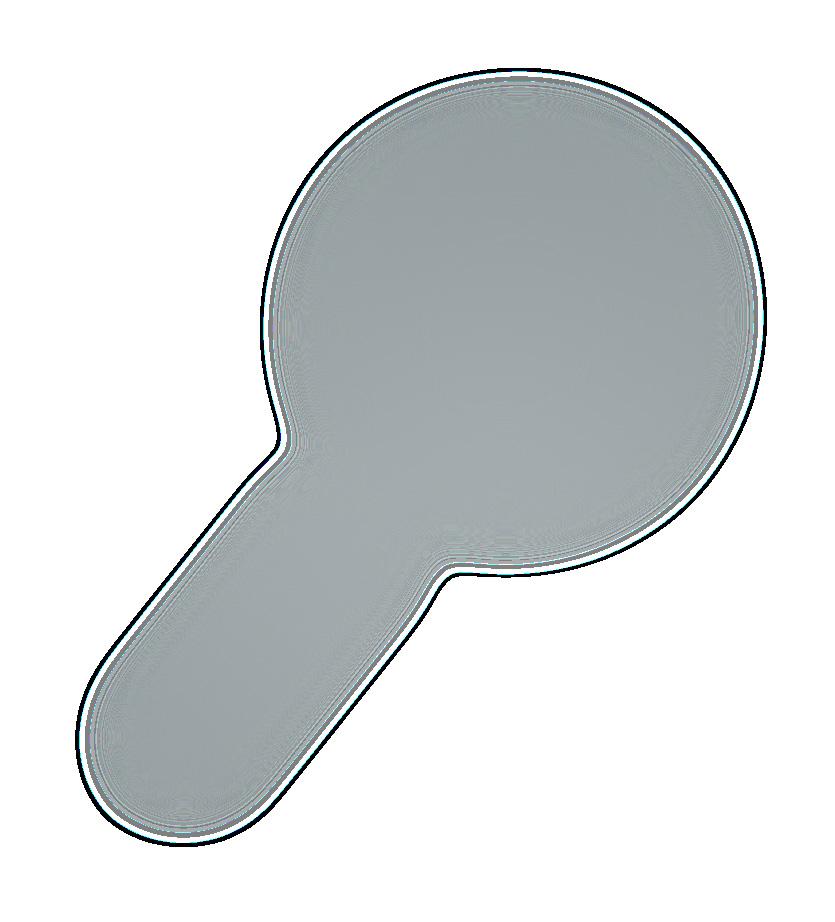

The Brunswick was a


significant technological improvement over the Baker rifle that had seen use in the British rifle brigades and battalions for the previous three decades. The Baker was a flintlock rifle with a slow twist seven-groove barrel. The rifling design had been selected not so much for accuracy, but for its ability to see significant use without becoming too fouled to load. In fact, the accuracy, or rather inaccuracy, of the rifle was such that during the last years of production the multileaf rear sight was abandoned for a fixed sight; with the Board of Ordnance feeling that the adjustable sight was unnecessary for the rifle or the rifleman! Lovell experimented with a variety of rifling systems for what would become the new Brunswick rifle. He finally settled upon a two-groove bore of .704 caliber that used a belted ball to insure a tight mechanical fit between the ball and
rifling. The new rifle resembled the older Baker in that it did not employ barrel bands, but rather had a key fastened stock and had a heavy bar on the right side of the barrel for the mounting of a saber bayonet.


The first version of the Brunswick, the Pattern 1837, had Lovell’s back action lock, a fixed sight with additional leaves for longer range shooting, and a hook breech. The rifle had a 30inch barrel and weighed approximately ten pounds. As noted, the gun had wedge retained barrels without barrel bands. The barrels were browned, the locks color case hardened, and the furniture was brass. This included a large brass patchbox in the obverse butt for the storage of patches and cleaning implements. The brass triggerguard tang also incorporated a skeletonized pistol grip. A bayonet bar on the barrel allowed the mounting of a brass hilted, wasp-waisted saber bayonet whose blade resembled a Roman gladius.
The Brunswick rifle went into production in 1838, with the first rifles reaching troops in the field during 1840. In 1841, an improved version was adopted with a conventional side lock and the hooked breech was eliminated. These Pattern 1841 rifles went into production around 1844 and were in the field the following year. Most collectors refer to the improved Brunswick as the Pattern 1844. The final change came in 1847, when Lacy & Reynolds, a London arms contractor, introduced an improvement to the bayonet mounting bar. Once the new improvement was officially adopted, the final version, the Pattern 1848 came into being. The Brunswick rifle remained a standard issue long arm for rifle troops until about 1853, when sufficient quantities of the new Pattern 1851 Minié rifles had been produced and could be issued, effectively turning all British infantrymen into “riflemen.” Even after the adoption of the small-bore .577 caliber Pattern 1853 “Enfield,” the Brunswick remained in service in a secondary issue roll, particularly among native and colonial
troops, through the mid-1860s.
With the adoption of the Pattern 1853 Enfield, the Brunswick rifle, along with the Pattern 1839 and 1842 muskets and the Pattern 1851 Minié rifle all became obsolete and essentially worthless arms in British military inventories. Some of these arms were sold off to the fledgling Confederacy during 1861 and 1862, as southern purchasing agents were looking to obtain small arms of any type to equip the newly formed Confederate armies that were then taking the field against the U.S. military. According to the Gorgas Summary of Small Arms Purchases that were made by Caleb Huse, some 2,020 “Brunswick Rifles” were purchased by the south at a cost of 54 schillings each. This summary report was dated February 3, 1863, and most likely covered the purchases made by Huse between the time he arrived in England during the summer of 1861 and the end of 1862.

Huse acquired all of his Brunswick Rifles from S. Isaac, Campbell & Company, who purchased the guns from J.E. Barnett & Son of London. The guns were acquired in eight lots between October 31, 1861, and March 27, 1862. To date, only nine examples of these Confederate purchased Brunswick rifles are known, all bearing the CH/1 inspection mark of Isaac Curtis and Charles Hughes, who acted as viewers for Confederate arms purchases in England, usually of guns sold by Barnett. These nine examples vary in features and caliber, with some being .704 two-groove military rifles (both 1837 and 1844 patterns) and some being smaller bore volunteer models. In all cases, even the surplus military guns have been upgraded with the addition of Pattern 1856 short rifle rear sights.
The Volunteer pattern, smaller bore guns have stamped inventory numbers, and the extant examples range from #207 through #1065. This suggests that Barnett may have produced these guns, or possibly built them from a variety of scavenged military parts and newly made parts, as Pattern 1853 type locks and newly made .63 barrels have been encountered on some of these guns. The Brunswick rifles documented in the Gorgas summary were shipped to the south in the cargos of the blockade runners Gladiator, Southwick, Stephen Hart, Ella Warley and Melita
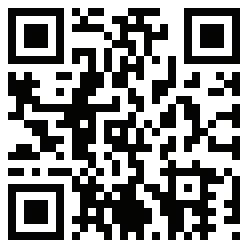
The rifles were shipped in crates of twenty each, with each rifle accompanied by the appropriate brass handled saber bayonet. A pair of cone wrenches and a single bullet mold were
also included in each case. These cases were marked in three lines B / WD / H within a rhomboid, indicating “Brunswick,” “War Department” (Confederate Ordnance Department) and “Huse.” One extant Confederate ordnance document dated August 27, 1862, records the transfer of “260 British rifles (twogroove)” from the Charleston Arsenal to General Sterling Price at Tupelo, Miss. Their description as “2-groove” rifles indicates that these were the .704 caliber British military pattern 1837 and 1844 Brunswick rifles. Thirteen thousand rounds of ammunition and thirteen bullet molds also accompanied the rifles to Tupelo. With only fifty rounds of ammunition sent with each gun, the bullet molds probably became rather important very quickly, if the guns were to remain in service very long! These Brunswick Rifles almost certainly saw combat less than a month later at the Battle of Iuka, Miss., (Sept. 19, 1862) and again soon after at the second Battle of Corinth, Miss., (Oct. 3-4, 1862).
One of the finest examples of a carved Confederate rifle is a .63 caliber Volunteer pattern Brunswick rifle identified by its exquisite period inscription to John C. Gillespie of Company K, 18th Arkansas Infantry. The 18th Arkansas fought at both Iuka and Corinth and suffered staggering causalities at the second battle with losses approaching 85% of the regiment. As the Gillespie gun is a numbered (#1065) “Volunteer” pattern, .63 caliber gun, it must have been part of a different shipment of Brunswick rifles to Price’s troops that we have not found the ordnance records for, as the record mentioned above clearly describes .704 caliber Brunswicks.
Not all the 2,020 Brunswick rifles purchased by Huse during 1861–62 successfully arrived in the Confederacy. The Stephan Hart was captured by the Federal Blockading Squadron and its cargo was subsequently sold at auction on May 22, 1862. Among its cargo were some 16 cases of Brunswick rifles, 320 in total, which were sold for $10 each at the auction. The Blockade Runner Ella Warley suffered a similar fate, and the September 30, 1863, auction of its cargo included 15 cases of Brunswick Rifles (noted as “small caliber, 7-groove”) which were sold for $12 each including their saber bayonets. This means that at least 620 of the 2,020 rifles never made it to southern ports, so a maximum of 1,400 documentable Brunswick rifles were delivered to the Confederacy.
22 Civil War News October 2019 www.CollegeHillArsenal.com Tim Prince College Hill Arsenal PO Box 178204 Nashville, TN 37217 615-972-2418
Tim Prince is a full-time dealer in fine & collectible military arms from the Colonial Period through WWII. He operates College Hill Arsenal, a web-based antique arms retail site. A long time collector & researcher, Tim has been a contributing author to two major book projects about Civil War era arms including The English Connection and a new book on southern retailer marked and Confederate used shotguns. Tim is also a featured Arms & Militaria appraiser on the PBS Series Antiques Roadshow.









Close up of the area where the CH/1 mark is found on the CS imported Brunswick rifles. This rifle had an old collection tag in the wood that mostly obliterated the mark. The inset photo shows what the mark would have looked like before the tang of the tag ruined it.











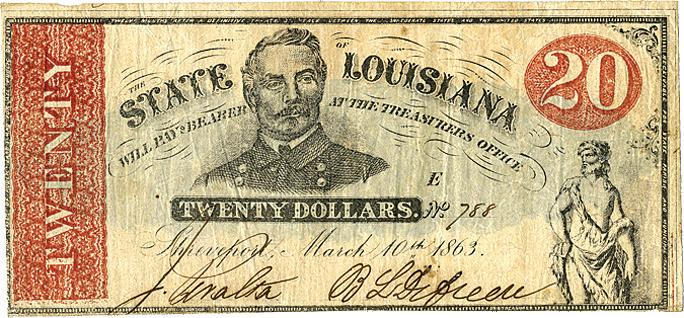

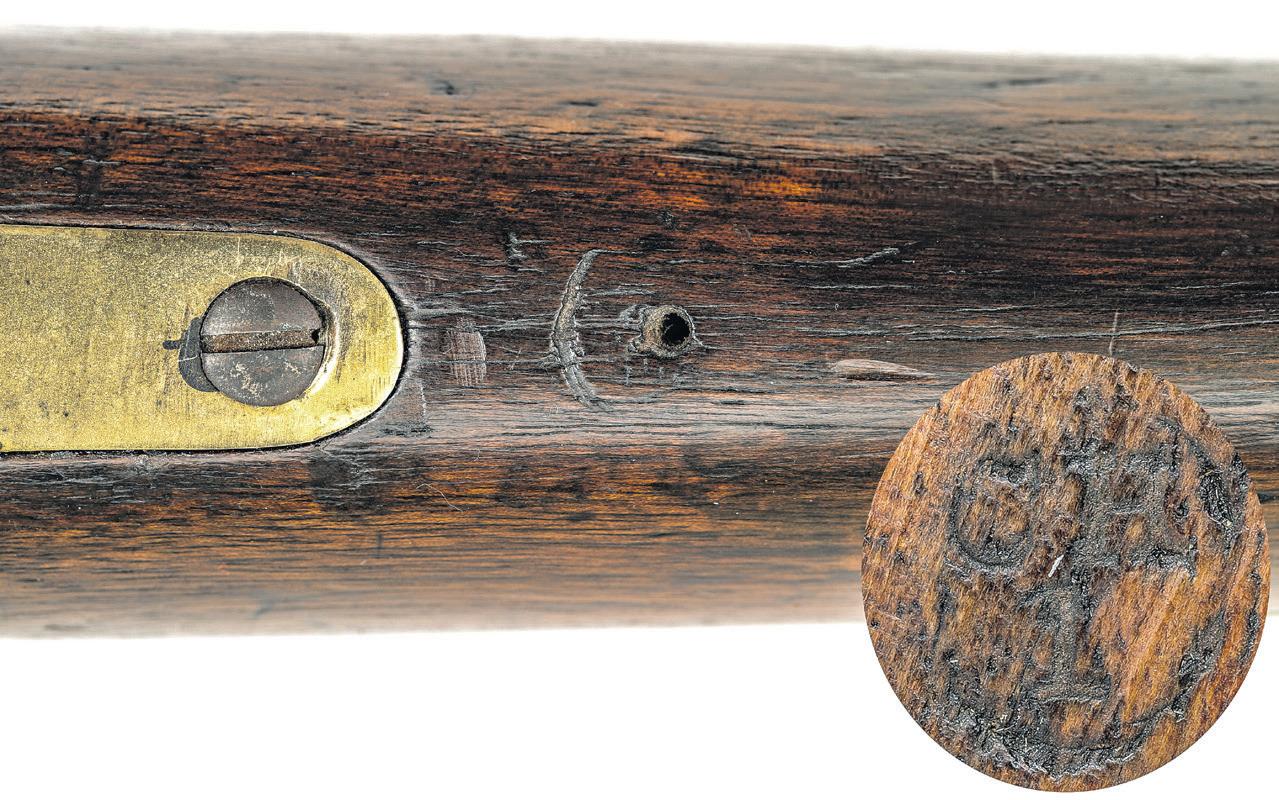



23 October 2019 Civil War News
Overall obverse view of a Confederate imported Brunswick rifle. All photographs by Tim Prince.
Close up of the lock and P1856 rear sight of a CS used Brunswick. This 1,100 yard Enfield pattern rear sight is one of the defining features of CS purchased Brunswick rifle.
Detail of the 1,100 yard sight leaf of the P1856 rear sight.
Close up of the two-groove .704 caliber bore of a CS imported Brunswick rifle, showing the heavy bayonet bar on the side of the barrel as well.
Greg Ton • P.O. Box 9 • Franklin, TN 37065 901-487-5944 • GTon1@aol.com Greg Ton Buying and Selling the Finest Confederate, Obsolete and Southern States Currency Since 1978 GregTonCurrency.com
Overall reverse view.
George Barnard’s Photographic Views of Sherman’s Campaigns


 By Stephen Davis Special to Civil War News
By Stephen Davis Special to Civil War News
The fire of General Logan’s men was so rapid as to heat their muskets to a degree that rendered them almost unserviceable. After the close of the engagement half melted bullets were drawn from muskets that had been used by men who had been killed or wounded. In conversation with some of the soldiers who were cleaning their guns directly after the battle, the information was received “that the barrels of the muskets got so hot that they made the wood-work smoke.” The water in the canteens of the men was exhausted early during the battle, and caused the resort to an unusual method of cooling muskets. –
Theodore Davis
So wrote Theodore Davis in his nineteen-page summary of the Atlanta Campaign published as part of George N. Barnard’s Photographic Views of Sherman’s Campaign (1866). More on this “unusual method;” you can probably guess it, but first, let’s step back a bit.
George Barnard was a fortyfour-year-old daguerreotypist from New York, a former employee of Mathew Brady, when he was hired on Dec. 28, 1863, by the Topographical Branch of the Department of Engineers, Army of the Cumberland, to run the army’s photographic operations. Barnard was based in Nashville, reproducing maps and taking pictures of battlefields and railroads
when Ulysses Grant was brought east in March 1864 to become general-in-chief of the Union armies. Grant handed over command of his Military Division of the Mississippi to Maj. Gen. William T. Sherman. In the following months, while Sherman was slogging through north Georgia, Barnard took more pictures of Nashville, Knoxville, and Chattanooga.
After Sherman took Atlanta in September 1864, his chief engineer, Capt. Orlando M. Poe, summoned Barnard to photograph the city’s surrounding fortifications. The cameraman took several hundred pictures of occupying Union troops and of the city itself. Then, in mid-November when Sherman
set out for the sea, Barnard accompanied the Federal forces to Savannah, though he took no pictures during the march. In early 1865 he made more images of Savannah and Charleston before returning to New York at the end of the war. We don’t know when Barnard began thinking of turning his wartime work into a photographic album. Keith F. Davis, in his definitive George N. Barnard: Photographer of Sherman‘s Campaign (1990), suggests the cameraman was out to make money, because in the postwar North William Tecumseh Sherman was a hot commodity. Maj. Ward Nichols, Sherman’s ADC, cashed in with his The Story of the Great March, published just months after Appomattox. Other books followed, including David Conyngham’s Sherman’s March through the South. In Gotham, Barnard would have picked up on all this buzz. Another possible prod may have been Alexander Gardner’s Photographic Sketch Book of the Civil War (1866).
(The front cover of Barnard’s eventual Photographic Views
looks a lot like that of Gardner’s Photographic Sketch Book.)

In the fall of 1866, Barnard was hard at work producing his album, which would include 61 photographic plates, all hand-mounted on pages by the photographer himself. Only a hundred, perhaps 150 copies were produced, specially sold by subscription for a hefty hundred bucks—and that’s in 1866 bucks!
In September Barnard persuaded Theodore Davis, the Harper’s Weekly illustrator who had accompanied Sherman in his campaigns, to write a historical narrative about them. In his republication of Barnard’s Photographic Views, Keith Davis doesn’t include Davis’ text; he explains that you can find it in Beaumont Newhall’s reprint of Barnard’s album (Dover Publications, 1977).
By the way, Davis’ “unusual method of cooling muskets,” if you haven’t guessed it, involved Union infantrymen urinating down their rifle barrels. Maj. Thomas Taylor of the 47th Ohio recorded in his diary that in the battle of Ezra Church, fought on July 28, 1864, west of Atlanta,
the men were “urinating & pouring water” into their hot muskets. I thank Gary Ecelbarger, of Annandale, Va., for citing Albert Castel’s Tom Taylor’s Civil War (Kansas, 2000) as source of this quote. Gary is author of Slaughter at the Chapel: The Battle of Ezra Church 1864 (Oklahoma, 2016). We’re fortunate to have all these volumes in our personal library—the Brigadier General Clement Anselm Evans Memorial Research Collection, as I call it— and can thus quote the text written by Theodore Davis 153 years ago.
This is just another example of the fun we Civil Warriors can have with the study of George Barnard’s monumental work.
Steve Davis, longtime Atlantan, received his bachelor’s and doctoral degrees from Emory and a master’s at Chapel Hill. He’s been studying the Atlanta Campaign for decades, and with it George Barnard’s photographs. He coined the word Barnardiana to reflect that the study of Barnard’s images deserves a highfalutin’ word.
24 Civil War News October 2019
Betcha haven’t seen this one!
By Stephen Davis
Special to Civil War News


Quick! What’s this view—a photograph taken by one of the Civil War’s most prominent cameramen?
Chances are that you’ve seen a slightly different view of this same scene in
• Francis Trevelyan Miller’s Photographic Views of the Civil War (1911), vol. 3, p. 135;
• Lamont Buchanan, A Pictorial History of the Confederacy (1951), p. 243;

• William C. Davis, ed., The Image of War: 1861–1865 (1983), vol. 5, p. 292; or
• Jeff L. Rosenheim, Photography and the American Civil War (2013), p. 210.
Hint: it’s also in countless histories of the Atlanta Campaign. In the Brig. Gen. Clement Anselm Evans Memorial Research Collection—AKA my personal library at home—I found fifteen
books in which the companion photograph has been published. But this one? Nada. We’re fortunate to have found it in the Orlando M. Poe Collection at the U.S. Military Academy, its collection of George N. Barnard photographs. To our knowledge, it’s never been published…
…until now, on page 112 of our new book, 100 Significant Photographs of the Civil War: Atlanta Campaign. The page is reproduced below.


Editor’s note: we are delighted to announce that America’s Civil War is working with Steve Davis and Jack Melton to publish a dozen of the Barnard photographs shown in our book. The pictorial portfolio is scheduled for the magazine’s January 2020 issue.


Comments from Our Readers
“I have read your new Barnard book with great interest and pleasure. It should be in the library of every student of the Atlanta Campaign.”
David Evans
Author of Sherman’s Horsemen: Union Cavalry Operations in the Atlanta Campaign
“I applaud Steve Davis’ selection and use of George Barnard’s photographs, which are seen on the printed page all too rarely. Davis takes readers on a visual journey from the earliest days of the Atlanta Campaign to Union capture of the city while zooming into the many details hidden in the depths of Barnard’s glass plate negatives. With introductory information and professionally curated and described photographs, Steve Davis presents a book from which casual Civil War buffs and serious Civil War photography students will benefit.”
Garry Adelman
Vice President, Center for Civil War Photography
“I’m thrilled with your very crisp, readable, easily grasped-yet-informative book. AND—it has the image quality and detail people love.”
Gordon L. Jones
Senior Military Historian and Curator, Atlanta History Center
“The first thing I look for and see in any volume of Civil War photos is the quality of reproduction, and Stephen Davis’ 100 Significant Civil War Photographs: Atlanta Campaign easily passes that test, with rich and appealing reproductions, many from the original glass negatives. Davis also distinguishes his work by showing many of the fascinating details that emerge only with a closer examination of the images. The study and presentation of Civil War photography has become increasingly specialized and detailed in the past 50 years, and Davis’ book exemplifies that and represents another significant addition to the field.”
Bob Zeller
President, Center for Civil War Photography
“I have a small roller-type book cart next to my desk, where I keep only special reference books, which I frequently consult in my research and writing. This title now has a place on the cart! I congratulate you on an engaging narrative to accompany the photographs you and I treasure. A job well done!”
Michael K. Shaffer, Instructor
Kennesaw
State University and Emory University, Kennesaw, Ga.
A Less Familiar View
This Barnard photograph is also at West Point, but it has not been published (so far as we know). The photographer set his camera and tripod so as to emphasize the chimneys of the Atlanta Rolling Mill.
Established in 1857, the facility specialized in rolling iron rails for the South’s growing railroad lines. Located beside the Georgia railroad east of downtown, the plant had six big furnaces—five of whose chimneys Barnard captured in this picture. After the war began, the mill turned out armor plate for the South’s ironclad warships.

When Sherman’s armies were nearing Atlanta, the mill’s valuable machinery was hauled by train to Columbia, S.C. By July 10, a correspondent for the Montgomery Advertiser reported that “Atlanta has been stripped of public stores and works.”
In the night of September 1-2, as Hood’s army abandoned Atlanta, the Georgia militia and Confederate cavalry destroyed the ammunition train and set fire to the nearby mill buildings.
After Federal troops entered the city, William Wallace of the 3rd Wisconsin saw “steam boilers, fly wheels, great piles of iron in various stages of manufacture,” but of the mill itself only the chimneys stood. Illinois private Laforest Dunham also saw the wreckage, noticing “lots of plateing for gun boats that they could not get off”—Confederate railroads proved unable to transport the rolling mill’s iron plate to the coastal facilities where the ironclad gunboats were being built.
25 October 2019 Civil War News Now Available!
112
100 Significant Civil War Photographs: Atlanta Campaign
Subscribe online at CivilWarNews.com
Edward Porter Alexander was a military professional, a keen observer, a thoughtful analyst, and a gifted writer. All these traits make his memoirs, Fighting for the Confederacy: The Personal Recollections of General Edward Porter Alexander (edited by Gary W. Gallagher and published in 1989), one of the best works of its kind. The account of how the memoirs came to be published is itself an interesting story.
Alexander began to write in 1897, while in Greytown, Nicaragua, where he served 28 months as an arbitrator helping resolve a Central American
border dispute. He intended the work for his own family, not for publication. He also “envisioned a modest work,” according to Gallagher, but the words kept flowing from his pen and filled 1200 handwritten pages, an account of the war and his role in it which “gave his children a precious legacy.”
In 1901 Alexander started a second account, similar to the first, but different in scope and tone. Military Memoirs of a Confederate: A Critical Narrative was published in 1907. For much of the 20th century the account begun in Nicaragua remained hidden among the Alexander Papers at the University of North Carolina, mixed in with drafts of Military Memoirs. Scholars examining the papers didn’t quite know what to make of the confusing bundle. Finally Gary Gallagher took on the task of “disentangling this material.”

The result was the 1989 book. One of the differences between the resurrected memoir and the 1907 work is its higher level of candor, what Gallagher calls “his unvarnished opinions about people and events.” High level leaders “and a host of lesser Confederates came in for
GEORGIA’S CONFEDERATE MONUMENTS

In Honor of a Fallen Nation
Gould B. Hagler, Jr.

This unique work contains a complete photographic record of Georgia’s memorials to the Confederacy, a full transcription of the words engraved upon them, and carefully-researched information about the monuments and the organizations which built them. These works of art and their eloquent inscriptions express a nation’s profound grief, praise the soldiers’ bravery and patriotism, and pay homage to the cause for which they fought.
www.mupress.org
866-895-1472 toll-free
break him down with the troops & to force the president to remove him.”
did not yet know well.
substantial criticism.”
This gets us to the column’s title, “L’audace, l’audace, toujours l’audace.” This phrase and variations of it are attributed to several people in history – Patton, Napoleon, Frederick the Great, and others. From my own knowledge I can say only that George C. Scott said it, but the point is there, whoever said it first: audacity is a highly desirable trait in a military commander.
What did Alexander have to say about this trait as embodied by Robert E. Lee?
In the early pages of Fighting for the Confederacy Alexander told of a conversation about Lee and audacity with Capt. Joseph Christmas Ives, a member of President Davis’s staff. After Gen. Joseph Johnston was seriously wounded at Seven Pines on May 30, 1862, the president named Lee to take Johnston’s place. Lee had not seen much success in his earlier assignments in western Virginia and on the South Atlantic coast. He was not a popular choice in all quarters. “And now that he was put into command of the army,” Alexander wrote, “some of the newspapers – especially the Richmond Examiner – pitched into him with extraordinary virulence, evidently trying to
Alexander interrupted the narrative at this point to tell us an anecdote about the Examiner’s editor John Daniel, one his journalistic sins yet to be committed, and the wages to be paid. I will digress for the same reason. Soon after the war Daniel wrote a piece regarding a local lady, one Mrs. Grant, “with insinuations against the young lady’s character.” Mrs. Grant’s brother took offense at the editor’s words and “shot him dead on the sidewalk in front of his office from an upstairs window on the opposite side of the street. A Richmond jury afterwards acquitted him.”
Lee would surely have reacted had Daniel made insinuations against any of the women of his family, but as the editor was assailing him; Lee paid the matter no mind. “Daniel’s attacks upon Gen. Lee were as bitter as he could make them, & were repeated almost daily,” Alexander wrote, but Daniel could not get a rise out of Lee. “I can’t recall any reply ever being made in any paper to these assaults,” Alexander said, “and Gen. Lee himself never seemed even remotely conscious of them.”
Let’s return to the conversation with Ives and the matter of audacity. One day, after Lee’s assumption of command, Alexander encountered the captain as he rode from Richmond “to look around the camps & lines.” As they rode together they conversed freely about the state of affairs. Ives asked Alexander whether the criticism in the press was having an effect on the army’s confidence in its commander.
“I replied,” wrote Alexander, “that I had, myself, seen no evidence of it, but that, being myself one of his staff officers, it would not be likely to be exhibited to me even if it existed.” Alexander in turn asked Ives a blunt question about his new boss, whom he
“Has Gen. Lee the audacity which is going to be required in the command of this army to meet the odds which will be brought against it?” Alexander summarized the situation for Ives, and it was a dire one. McClellan was at the gates of Richmond with a large force and with more men in the rear at Fort Monroe. McDowell was at Fredericksburg with close to 40,000 men, ready to pounce on Lee’s flank. “Here we are putting up some little lines in our front, but we are leaving the enemy to take his own time, & to perfect all his plans, & accumulate all his forces, & to choose his own battle…. Now with our inferior forces & resources such a course as that must finally end in defeat. Our only hope is to pounce on him & whip him somewhere before he is ready for us, and that needs audacity in our commander. Has Gen. Lee that audacity?”

Alexander quoted Ives’s reply from memory, as he wrote in Greytown a third of a century after the fact. “Alexander, if there is one man in either army, Federal or Confederate, who is, head & shoulders, far above every other one in either army in audacity that man is Gen. Lee, and you will very soon have lived to see it. Lee is audacity personified. His name is audacity, and you need not be afraid of not seeing all of it that you will want to see.”
Alexander did indeed see this audacity, at the upcoming Seven Days Battles and beyond. “I think that military critics will rank Gen. Lee as decidedly the most audacious commander who has lived since Napoleon,” wrote the old retired officer long after the young officer heard Ives’s prescient words.
Alexander’s admiration of Lee is apparent throughout his narrative, but it is a candid work and Lee, like every other man, made mistakes. In Alexander’s view Lee on occasion exhibited too much audacity. His memoirs
26 Civil War News October 2019
L’audace, l’audace, toujours l’audace
Pickett’s Charge: Too much audacity, according to Alexander. (Library of Congress)
Edward Porter Alexander
provide examples.
First, at Sharpsburg, Lee stood with his army and faced a more numerous foe, against odds “so immense that the utmost he could have hoped to do was what he did do – to repel all assaults & finally to withdraw safely across the Potomac.” In Alexander’s estimation Lee “fought where he could have avoided it, & where he had nothing to make & everything to lose – which a general should not do.”



Alexander made a similar assessment of Gettysburg. “Then perhaps in taking the aggressive

at Gettysburg in 1863 & certainly in the place & dispositions for the assault on the third day, I think, it will be undoubtedly held that he unnecessarily took the most desperate chances & the bloodiest road.”

We get his critique of the aftermath of Chancellorsville as well. The Confederates won a great victory on May 3; however, despite its losses the Army of the Potomac remained a very formidable force. “Hooker’s entire army, some 90,000 infantry, were in the Wilderness, backed against the Rapidan, & had had nearly
three days to fortify a short front, from the river above to the river below. And, in that dense forest of small wood, a timber slashing in front of a line of breastworks could in a few hours make a position absolutely impregnable to assault. But on the afternoon of the 5th Gen. Lee gave orders for a grand assault the next morning by his whole force of about 40,000 infantry, & I was all night getting my artillery in position for it. And how I did thank God when in the morning the enemy were gone!”
Alexander added this about the oversupply of audacity at




Chancellorsville: “I recalled ruefully Ives’s prophecy that I would see all the audacity I wanted to see, & felt that it was already overfulfilled: but, when to my intense delight, the enemy crossed the river in retreat during the night, & thus saved us from what would have been probably the bloodiest defeat of the war.” That was in the future, a year after Alexander’s conversation with Joseph Ives. Closer at hand was Lee’s audacious assault that drove McClellan from the Confederacy’s capital. Alexander’s memoirs cover that series of battles in great detail, and contain some frank assessment
about their incomplete results. A future column will examine this assessment.
Gould Hagler is a retired lobbyist living in Dunwoody, Ga. He is a past president of the Atlanta Civil War Round Table and the author of Georgia’s Confederate Monuments: In Honor of a Fallen Nation, published by Mercer University Press in 2014. Hagler speaks frequently on this topic and others related to different aspects of the Civil War and has been a regular contributor to CWN since 2016. He can be reached at gould.hagler@gmail.com.
27
October 2019 Civil War News
Hooker’s Headquarters at Chancellorsville: Federals retreated, Alexander much relieved. (Library of Congress)
Dunker Church at Sharpsburg: “Too much to lose and nothing to gain,” Alexander said. (Library of Congress)
Markert info@csacquisitions.com 16905 Nash Road • Dewitt, Virginia 23840 804-536-6413 • 804-469-7362
THE FINEST HISTORICAL ANTIQUE MILITARIA
Wallace
www.csacquisitions.com
Subscribe online at CivilWarNews.com
By Michael Pikunas
The morning of November 12, 1861, the youthful Federal soldiers of the 48th Pennsylvania Volunteer Infantry were not overjoyed by the unfamiliar sights and smells around them. They had landed at Hatteras Inlet, N.C., which compared to the lush green forests and farms of Eastern Pennsylvania, presented to them an endless and desolate expanse of bleached white sand. This was their first journey away from their homes in Schuylkill County, a region comprised of small coal mining towns near the Schuylkill River.
One of those small towns, Palo Alto, lay on the Schuylkill which flows eastward toward Philadelphia, less than one hundred miles away.
Just fifty miles to the east, was Bethlehem, settled in 1741 by a Christian sect of German Methodists called Moravians. These Germans “brought with them a high regard for education and a love for music.”1
But unlike their comrades from Palo Alto, the Bethlehemians had relatives and brethren in Bethania, N.C. Settled by Moravians in 1759; Bethania was a farm town near Salem, the Southern home of the Moravians. Like their northern brethren, the Bethanians enlisted to serve, not to put down the rebellion, but to don the Confederate gray and support it.
The blue clad and gray clad Moravians had more than their patriotism in common; they shared a talent for music and their
Tale of Two Eagles
Christian heritage, complete with its signs and symbols. “In their boarding schools they learned to draw their great Moravian symbol, The Star of Bethlehem. In this fashion, by drawing the shapes of a pyramid and gluing the shapes together they created a multi pointed star.”2 As the clouds of war darkened, many Moravians would join their respective ranks, not as soldiers, but as musicians.
Following the first cannon blasts at Fort Sumter, Moravian musicians from Salem, formed three bands, initially named as militia units. “The Forsyth Grays” became Company E, Eleventh Regiment, NC Volunteers. This company changed later to the Twenty-first Regiment, NC Troops. The Bethania Brass Band also known as the “Confederate Stars” was formed soon after and became Company F, then Company I of the Thirty-third Regiment, NC Troops. Finally, there was the Salem Brass Band, famously known as the “26th NC Regimental Band.”3 They would all wear the gray.
At Hatteras Inlet the young soldiers in blue eventually began to frolic in the surf, gathering what they called “secesh” shells. They’d ship the shells home to their relatives in wooden crates on board ocean borne “steamers.”4
They didn’t know what lay ahead, that three years hence their skills and ingenuity would be called upon to attempt a bold and decisive end to the seemingly endless war. The 48th Penna.
would tunnel underneath the rebel lines at Petersburg and plant a ton of explosives creating what would be known ever after as “The Crater.”
Aside from making history, during the course of their war, the soldiers of the 48th Penn. would capture two American Bald Eagles, making them souvenirs and shipping them back home to Schuylkill County. “A live eagle was captured after putting up a fight on the 48th’s picket line at Hatteras Inlet.”5 The other was a defiant eagle, hand painted by an unknown artist on the face of a rebel snare drum captured late in the war.
The bottom head of the ‘rebel eagle’ drum bears a number of six pointed stars, one of them large, “shaped in the same fashion as drawn by Moravian boarding school students in the mid-19th Century at Old Salem North Carolina.”6 Printed below the larger star by the same hand are two words LANE BAND. Appearing to the side of these markings in bold period ink is the name and home town of the soldier of the 48th Penn. who “captured” the drum and sent it home to Schuylkill County, (George W.) “Stellwagon, Palo Alto, Penna.”

The drum’s dimensions are: 12 and one half inches tall by 14 and one half inches wide. The shell is uncut. Next to the spreadwinged eagle motif is a symmetrical tack pattern that consists of a circle around the vent hole encompassed by a large square. The hoops, heads, leather tugs, and rope tensioners are original. The free hand painted motif consists of a spread -winged bald eagle on a gold sun-rayed blue field. The bald eagle is grasping the broken flagstaff of a furled Federal flag in its beak. The eagle is portrayed on the ground with pointed green ivy leaves and red berries. In its talons is a clutch of arrows. The drum shows a substantial amount of use and field wear. It bears no Federal markings, i.e., E Pluribus Unum, U.S., etc. Images of original Federal drums carried by 48th Penn. drummers can be seen on the 48th Pennsylvania website.7 George Stellwagon, an infantryman of the 48th Pennsylvania, as far as we know, was with his regiment at the battles of Roanoke Island, New Bern, Second Bull Run, Chantilly, South Mountain, and Antietam, where he sustained a serious head wound while waiting to cross Burnside's Bridge. Stellwagon recovered to re-join the 48th in 1864 for the Battle

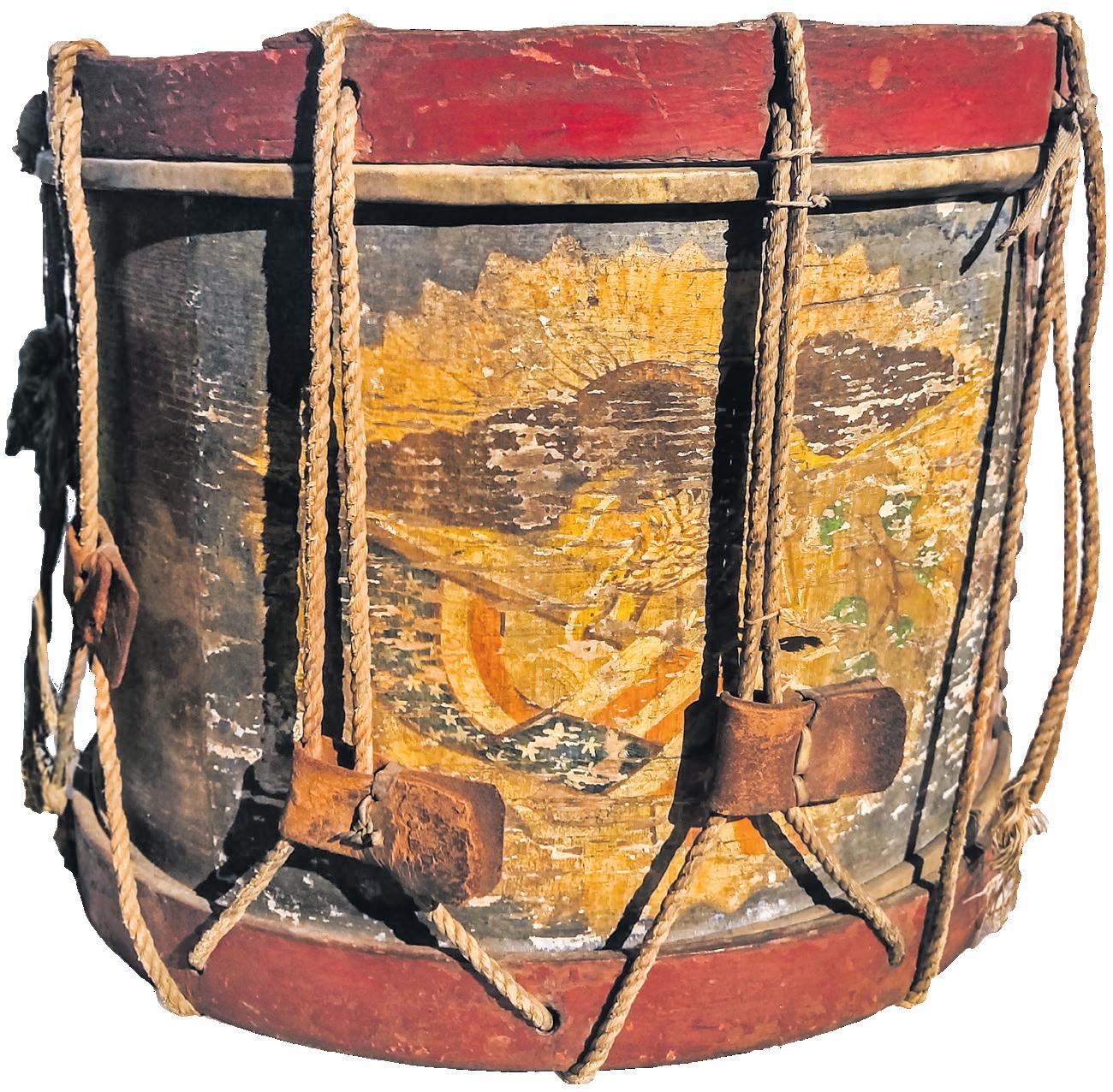
of the Wilderness and then to the war`s end.
What is the meaning of the words ‘LANE BAND’? The words printed by the Confederate musician, represent the Confederate regiment and brigade to which the ‘rebel eagle’ drum belonged: the Thirty-third Regiment, NC
Troops of General James Henry Lane's Brigade. General Lane received his brigadier star in November 1862 following the death of General Lawrence O. Branch at Sharpsburg. The Reminiscences of Oliver J. Lehman reveal the story.8 Known as “O. J.”, Lehman
28 Civil War News October 2019
Pre-Civil War spread winged eagle motif. the eagle motif which pre-dated the Civil War and North Carolina’s secession.
(All photos by the author)
View of the Eagle Drum’s brass tack pattern and vent hole.
Upper left is a hand-drawn Moravian 6-pointed Star of Bethlehem (a 2-dimensional representation of intersecting 3-dimensional 4-sided pyramids) and the hand-written words “LANE BAND” in the same hand, thereby linking the band to the Confederate brigade of General Lane.
was a Moravian musician from Bethania, N.C., who enlisted in Lane's Brigade and became band master to the Thirty-third NC Regimental Band. Lehman chose to serve with his fellow musicians who were formerly members of the Bethania Brass Band the “Confederate Stars.” “The Thirty-third Regimental Band although assigned to a regiment, was actually the brigade band for General Lane's Brigade, which included the Seventh, Eighteenth, Twenty-eighth, Thirty-third, and Thirty-seventh N.C. infantry regiments.”9 The Brigade was attached to Pender's Division, Third Corps, Army of Northern Virginia, under General Robert E. Lee.
While the live bald eagle at Hatteras Inlet put up a ferocious fight before being captured by a lieutenant and two privates of the 48th Pennsylvania armed with a fusillade of sea shells, the eagle on the rebel drum of General Lane's Band witnessed a much more prolonged and bloody struggle.
We can only speculate that the rebel drum’ eagle heard the screams of wounded soldiers
about to be consumed by flames in the woods at the Battle of Chancellorsville and witnessed the aftermath of the accidental wounding and death of General Stonewall Jackson caused by friendly fire from a sister regiment in Lane's Brigade. We can only speculate how close it got to the battle line on Seminary Ridge before marching toward Cemetery Ridge at Gettysburg. Did it inspire those brave soldiers by playing their favorite tunes— Bonnie Blue Flag and Dixie? For it was General Lee who once said, “I don't believe we can have an army without music.”10
We do know, according to Oliver Lehman that: “During all battles until the final surrender, General Lane's Band was in the opening of each, caring for the wounded and taking them to the field hospital just behind the line of battle. So our duties were not only as musicians but also as ambulance corps. We were often under severe shelling and small arms fire but we escaped almost miraculously.”11
We can feel confident that the rebel drum was there when fate brought together the 48th
Pennsylvania and the Thirty-third North Carolina regiments.
The eagle emblazoned on the ‘rebel drum,’ although forced to surrender has never surrendered its indomitable mystique. More of its story remains to be told. When all is quiet, an imaginative ear pressed against the vent hole might hear off in the distance the faint but unmistakable echo of the rebel yell.
Endnotes:
1. Hall, Harry H. 2006. A Johnny Reb Band from Salem: The Pride of Tarheelia. Raleigh N.C.: Office of Archives and History, N.C. Dept. of Cultural Resources.
2. Moravian Historical Society. About the Moravian Star, http:// moravianhistoricalsociety.org. (accessed June 10, 2018).
3. Hall, 2006.
4. Hoptack, John David. 2017. The Civil War letters of Private Daniel Reedy, Company F, 48th Pennsylvania Infantry, http://48thpennsylvania.blogspot.com/p/letters-diaries-civil-war-letters-of.html.

5. Hoptack, 2017.
6. Moravian Historical Society.
7. Hoptack, John David. 2017. The 48th Pennsylvania Volunteer Infantry, http://48thpennsylvania.blogspot.com.
8. Lehman, O. J. Reminiscences of the War Between the States, unpublished manuscript. Raleigh, N.C.: North Carolina State Archives.
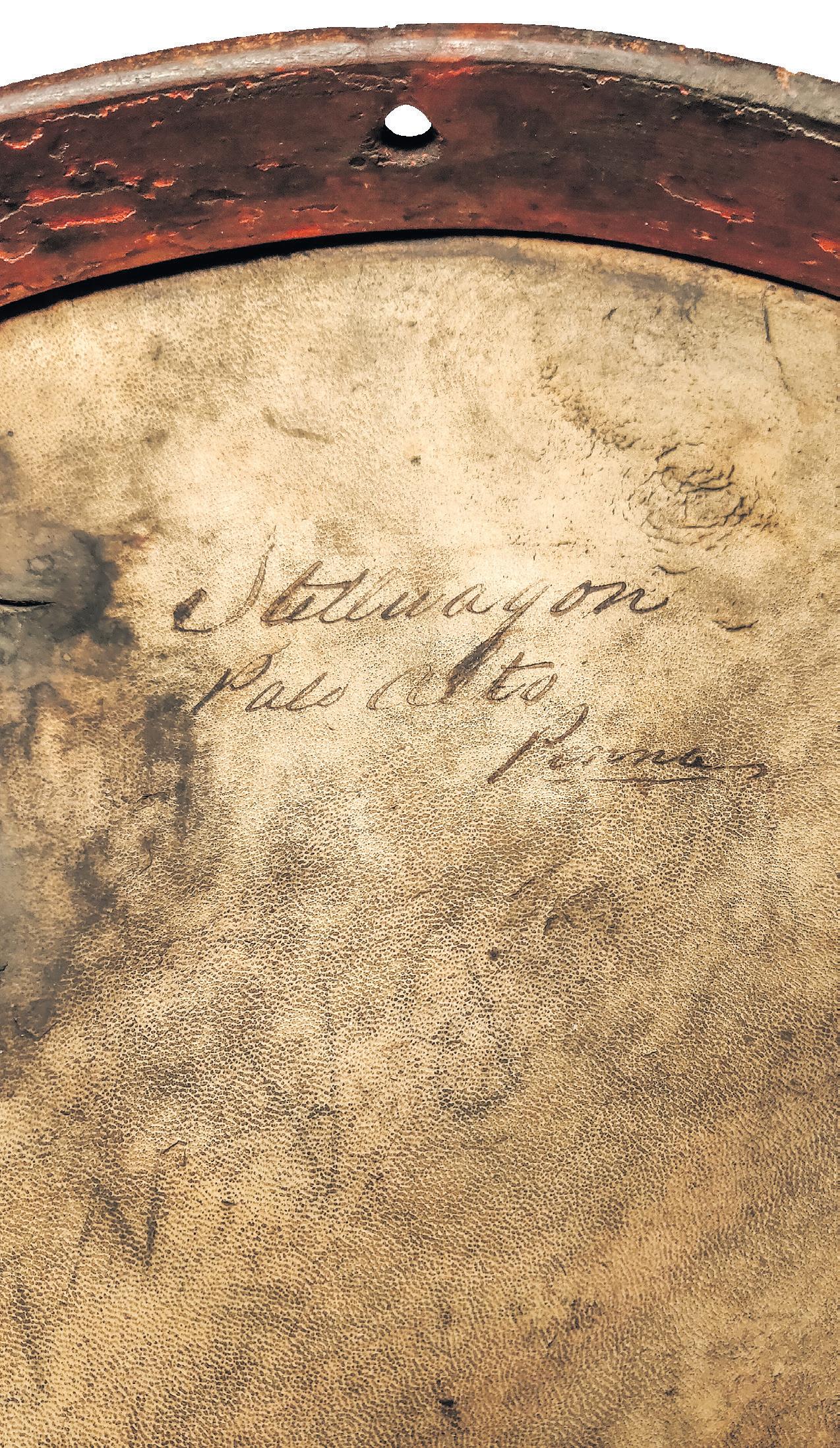
9. Ferguson, Benny Pryor. 1987. The Bands of the Confederacy: An Examination of the Musical and Military Contributions of the Bands and Musicians of the
Confederate States of America. North Texas State University.
10. Gerard, Philip. 2011. Battle of the Bands, https://www.ourstate. com/civil-war-bands.
11. Lehman, O. J. Reminiscences of the War Between the States, unpublished manuscript. Raleigh, N.C.: North Carolina State Archives.
Acknowledgements
I would like to recognize two persons in particular who helped me with their knowledge, expertise, and literary resources on the topic of Moravian Civil War history in Salem, North Carolina, namely, Historian Philip Dunigan and office manager Sarah Durham.

The invaluable forensic and technical skills of my friend, Ed Carlini, is also acknowledged along with my sister Anne Marie “Bunchy” Schwelm`s, moral and literary support and assistance, and for the many years of sharing the joy of Our Great American History.
Michael Pikunas is recently retired (March 2017) from a 33 year career
in Federal Law Enforcement. Born in Donora and raised in Pittsburgh, he has been fascinated with the American Civil War since reading many years ago a paperback copy of Combat: The Civil War – The Curtain Rises, by Don Congdon and Bruce Catton, many years ago. Soon after he stood on West Confederate Avenue at Gettysburg admiring the monuments and wondering that if the Southern Army was willing to come this far they must have been pretty serious. He continues to be an avid reader about the American Civil War and appreciates learning about and viewing the precious wartime relics preserved and shared by the collectors and historians of our times, especially Shannon Pritchard and Jack Melton.
Digital Issues of CWN are available by subscription alone or with print plus CWN archives at CivilWarNews.com

Civil War Artillery Book

New 392 page, full-color book, Civil War Artillery Projectiles –The Half Shell Book. For more information and how to order visit the website www. ArtillerymanMagazine.com or call 800-777-1862.
$89.95 + $8 media mail for the standard edition.

29
October 2019
Civil War News
Pen and ink inscription reading “Stellwagon, Palo Alto, Penna” linking the drum with the 48th Pennsylvania Volunteers.
By Don Hakenson and Chuck Mauro
Confederate Colonel John S. Mosby spent the last two and half years of the Civil War conducting guerilla combat operations against the Union Army in and around the city of Washington, the Union capital. He led a small band Confederate cavalrymen known as the Forty-third Battalion of Virginia Cavalry, or Mosby’s Rangers. His unit conducted their operations primarily behind enemy lines in Northern Virginia. They kept large numbers of Union troops guarding Washington instead of fighting against General Robert E. Lee. This little body of a few hundred men, under Mosby’s skillful and daring leadership, accomplished more with less. The Rangers struck quickly, gobbling up horses, men, and supplies before disappearing before reinforcements or help could arrive. The ability to appear and quickly disappear from a fight, and having no permanent camp, earned the Mosby the moniker the “Gray Ghost.”
This unit is recognized by today`s U.S. Army and Marine Corps as the most feared and successful guerilla unit in the history of American warfare. The area in which they operated would become known as Mosby’s Confederacy.
Authors Don Hakenson and Chuck Mauro have been retracing the steps of this famous guerilla leader for over 30 years, documenting the locations of his fights, safe houses, his men’s burials, and his other escapades in a series of books starting with A Tour Guide and History of Col. John S. Mosby’s Combat Operations in Fairfax County, Virginia, then in Loudoun County and now in Fauquier County, Virginia.
Although they have researched over 350 locations, they’ve documented, they still needed help for the less well known sites. For their Fauquier County book, they turned to two local historians for help.
One story they were researching goes as follows:
On April 27, 1863, at six o’clock in the morning, Union Major General Julius Stahel left Fairfax Court House in Northern Va., leading a brigade of two thousand cavalry and four cannon, with five days rations in an effort to capture or exterminate then Major John S. Mosby and his troublesome guerillas.1 When the expedition reached Cub Run, the Union advance guard


Chasing the Gray Ghost
captured three of Mosby’s men; Jack Barnes, Peachy Taliaferro, and Ab Wrenn, who were traveling horseless to Fairfax in the hope of obtaining some fine Union mounts.
prisoners increased by the acquisition of seven additional citizens and capture of three more Mosby men; Privates Thompson, Thomas N. Green, and Lycurgus Hutchinson.3 Stahel, hoping to strike terror in the hearts of the locals on the expedition, turned onto the road to Ashby’s Gap and prepared to spend the night near Middleburg. Stahel, riding a fine white horse, made an impressive sight for the citizens of that small town when the Union force passed through Middleburg.4
General Stahel allow to be kindled; for he very prudently remarked that he did not intend to light signal fires to direct guerillas in a nocturnal attack upon his camp.5
It was proposed to General Stahel by one of his officers to send these prisoners under guard to Fairfax Court House, but he replied that it was impossible for him to do so while on so important and hazardous an expedition. He would not weaken his force for any purpose whatever. “No,” said the general, with an air of profound cogitation, “the prisoners must be made to accompany the expedition on foot.”
At Aldie, the number of
Stahel determined to camp for the night in a body of woods one mile from the town. Stahel was a cautious man and ordered his artillery to open a concentrated fire on the wooded area before entering. Satisfied that not even guerillas could live under so destructive a fire, he finally proceeded to limber up and take possession of the desired camping ground. This shelling amused the now alerted Mosby and his men; they merrily ridiculed Stahel for bombarding an area that contained nothing more than bats and owls.
Each artillery piece was placed in such a position as to be most serviceable in case of a night attack. The horses were unbitted, but only long enough to enable them to eat; the men, after a hasty supper, were ordered to sleep with their animals in case of an emergency. The night was cold and rainy, yet not a fire would
The next day the Union brigade set their march towards Upperville but before the invading force had advanced halfway Ranger Tom Richards, with five or six men, met the advance guard and opened fire. Supposing this to be a general engagement, Stahel halted his column and placed it in line of battle, posting his artillery on neighboring elevations. He held this position unmolested for an hour, but at the end of that time, General Stahel moved abruptly to the left, in the direction of Salem (now Marshall), proposing to return to Fairfax through Thoroughfare Gap.
Mosby would not allow that to happen. Heading quickly to Salem, Mosby had come a few miles from the Gap, when he was overtaken by Alfred Glascock and Norman Smith, whom he had left on the road; they informed Mosby that five hundred of Stahel’s Union cavalrymen were now on Mosby’s tracks. Mosby quickly ordered, “They are the same men whom we whipped at Chantilly and at Miskell’s and we can do it again.”
Mosby immediately reversed his column and proceeded towards The Plains; after going a few miles, he was informed that Stahel had altered his plans again, and was trying to make good his retreat to Fairfax through Hopewell Gap in the Bull Run Mountains. Apparently, Stahel had been told that Mosby, and maybe even General J.E.B. Stuart’s cavalry, were at Thoroughfare Gap waiting to surprise him.
Mosby left the road and rode across country to a road leading from The Plains to the mountain pass. As fortune would have it, when Mosby reached the road,
he found the advance guard of Stahel’s command. The Union advance guard fell back and found General Stahel at The Plains. Stahel was informed that Stuart’s cavalry now occupied Hopewell Gap, and were then pressing forward to attack.6 Again, Stahel prepared for action, and drew up his forces in line of battle on a hill near The Plains, which would become known during the war as Stahel’s Hill.7
From an eminence near Kinloch, Mosby could plainly observe Stahel’s movements.8 Stahel, believed he was completely surrounded by barbarians and was obviously planning on cutting his way back to Fairfax and safety. General Stahel considered himself in a situation of extreme peril, surrounded by marauders who were doubtless waiting for him to make one mistake so they could pounce and begin a murderous encounter. Stahel thought the only course of action was a night march when he could give Stuart and Mosby the slip and make it back to the Union lines. At dusk the columns were formed, and headed towards Middleburg, the only avenue of escape still open.9
Today, the location of the hill that Mosby ascended and Stahel’s Hill are left to conjecture. There are a number of hills around the Kinloch house and The Plains that Mosby and Stahel could have used.
With the help of a topographical map kindly provided by Wendy Wheatcraft, the Fauquier County Preservation planner, the authors were able to first locate the only hill in the area large enough to accommodate General Stahel’s 2,000 men.
The hill south of the Plains that General Stahel most likely ascended is called Headache Hill today. It is the highest and largest hill in the area giving Stahel the ability to scout the Confederates

30 Civil War News October 2019
Union General Julius Stahel
Major John S. Mosby
Topographical map provided by Wendy Wheatcraft showing Stahel’s Hill circled south of The Plains and the location of Kinloch circled in the upper right-hand corner. Selby Lane is located where “The Plains” is denoted.
October 2019
via line of sight in any direction. It earned the name Headache Hill due to the difficulty that horses and wagons had crossing it in the early 1800s. It was subsequently known as Stahel’s Hill, as it was referred to by Confederate veterans in the area after the war.

The Archwood house and the Wakefield School are on top of the hill. The property was sold to the school from the Kinloch estate in 1994. This coincides with the account that Mosby could plainly see Stahel’s men from a hill on the Kinloch estate.


The Archwood house was built in 1916 as Ravenscroft by Robert Downman Jr., the son of Confederate Major Robert Henry Downman of the Black Horse Troop. It was subsequently renamed Archwood in 1928 by the new owner, Mr. H. Teller Archibald. It is on the site of the previous house named Ravenscroft, which predated the Civil War, but was torn down by Union troops for lumber to make a marquis for a ball for Union General John Pope.
the parameters of the historical accounts.
Charlie Mackall, the great-grandson of Confederate Brigadier General William Whann Mackall, currently lives on Selby. Charlie tells a family story that when his grandfather was eleven or twelve years old, living at nearby Avenel, he used to hide the family’s horses from the Union pickets as they
Civil War News
one could not see very far ahead. He saw Mosby and his rangers take off riding pell-mell down the north side of the hill toward Union soldiers guarding the railroad. Following a barrage of gunshots and commotion which he could hear but not see, he then saw Mosby and his men reappear from the fog bank, riding up the hill with captured Union soldiers on the backs of their horses.
Mackall House on Selby Lane, built in 1908, where Mosby had a Sunday dinner late in his life.

Till this day, Charlie and his family call such foggy mornings, “Mosby Mornings.”
Charlie also remembers his mother, Rebecca Beverley Mackall, telling him that Mosby had dined at the house for Sunday dinner with his grandfather and grandmother, Rebecca Dulany Beverly, a year or two before Mosby passed away in 1916.
The hill Mosby ascended, heading south from Kinloch, which he noted was within plain eyesight of Headache Hill, was more troublesome to locate. Stahel’s Hill is surrounded by many smaller hills and ridges to the north, east, and south. The Kinloch Estate does not extend further south, so the options were to the north and east.
To the east, O’Bannon Road runs along a long north-south ridge which Mosby and his men could have ascended. This ridge however is a little too far from Stahel’s Hill for a clear view of the Union cavalry. This is where The Plains historian, Marcia Markey, provided some much-needed insight. From her vast knowledge of the area and history of the Civil War, she indicated that the hill Mosby would have most likely ascended is one traversed today by Selby Lane. It is just northeast of Stahel’s Hill, across today’s Route 55, the John Marshall Highway. It, and Stahel’s Hill, were both part of the Kinloch estate, one key fitting
rode through the area or were stationed close by guarding the Manassas Gap Railroad. The rails ran between his property, a part of Avenel where he later built his house, and Headache Hill.
Beverley remembers seeing Mosby and his men on Headache Hill early one morning, while there was a thick bank of white fog in the valley between the two hills. The fog was so thick that
In this case, the authors were able to successfully chase down the location of the Gray Ghost while so many Union officers and soldiers were unable to do so during the war. They are continuing their work on this series.


Endnotes
1. Ramage, James A., Gray Ghost, The Life of Col. John Singleton Mosby; The University Press of Kentucky; Lexington, Kentucky; 1999; page 167.
2. Scott, John; Partisan Life with Mosby; Harpers & Brothers,
Publishers; (1867); New York; pages 78-79. Scott only provided the last names Thompson, Taliafero, Green and Hutchinson of the captured rangers.
3. Keen, Hugh C. & Mewborn, Horace; 43rd Battalion Virginia Cavalry Mosby’s Command; H.E. Howard, Inc.; 1993. A review of this regimental history provided the first names of Peachy Taliafero, Thomas N. Green, and Lycurgus Hutchinson.
4. Scott, John; Partisan Life with Mosby; Harpers & Brothers, Publishers; (1867); New York; page 82. Scott describes Stahel’s mount as “the general on a milkwhite steed.”
5. Scott, John; Partisan Life with Mosby; Harpers & Brothers, Publishers; (1867); New York; page 79.
6. Scott, John; Partisan Life with Mosby; Harpers & Brothers, Publishers; (1867); New York; pages 81-82.
7. Scott, John; Partisan Life
Mosby; Harpers & Brothers, Publishers; (1867); New York; page 82. Scott describes Stahel’s Hill, “the Federal general again prepared for action, and drew up his forces in line of battle on a hill near the Plains, henceforth to be known as Stahl’s [Stahel’s] Hill.”
8. Scott, John; Partisan Life with Mosby; Harpers & Brothers, Publishers; (1867); New York; page 82. Scott also stated “From an eminence in the neighborhood of Kinloch Mosby could plainly observe this movement.”
9. Scott, John; Partisan Life with Mosby; Harpers & Brothers, Publishers; (1867); New York; page 82.
Don and Chuck’s series of books on Mosby’s Combat Operations and other books on the Civil War in Northern Virginia are available on Amazon and www.hmshistory. com. Feel free to contact them at dhakenson@verizon.net and cmauro10@aol.com.
31
School as seen from Headache/Stahel Hill
Map of Mosby sites in Fauquier County by Stephen Wolfsberger.
View of Archwood and The Wakefield School on Headache/ Stahel’s Hill from Selby Lane.
with
Dunaway Branch between Selby Lane and Headache/ Stahel’s Hill.
The old Manassas Gap Railroad between Selby Lane and Headache/Stahel’s Hill used by Amtrak today.
Over 40 years Experience APPRAISALS



Since 1981, I have traveled over 5 million miles buying, selling, appraising, brokering, cataloging and researching over $100,000,000 in value of historical memorabilia, including the most expensive and valuable Confederate arms in most every category over the past 25 years. These items included the finest firearms, swords and textiles to ever come to the market.
I still travel over 100,000 miles a year attending all major antique arms and Civil War shows as well as all major auctions of historical arms and Civil War. I provide services in securing the finest items with guaranteed authenticity to the most discerning Institution or collector. My fees are reasonable and well worth the "peace of mind" of having qualified written authenticity report on valuable objects.

for Valuable American Historic Items of Any Genre John Sexton 77 0 -329-498 4 CivilWarAppraiser@gmail.com
FOR
Confidential Consultations & Appraisals • FEDERAL TAX PURPOSES • EQUITABLE DISTRIBUTION • INSURANCE, ETC. ISA-CAPP AMERICANSOCIETY OFAPPRAISERS ACCREDITED SE NIOR APPRAISER John Sexton
Allstadt’s Corner, important to John Brown’s Raid, donated to Harpers Ferry National Historical Park 13-acre site also played major roles the 1862 Battle of Harpers Ferry and in early 20th century regional industrialization
HARPERS FERRY, W.V.—
Nearly 160 years after John Brown raided the Federal arsenal at Harpers Ferry, the National Park Service (NPS) celebrated the addition of 13 acres that help tell his story. The American Battlefield Trust purchased the property known as Allstadt’s Corner, which includes Allstadt’s Ordinary, and transferred it to Harpers Ferry National Historical Park. The donation comes during the park’s yearlong 75th
anniversary celebration.
“The events at Allstadt’s Corner shaped our nation,” Superintendent H. Tyrone Brandyburg said. “This generous donation to the American people allows the National Park Service to preserve this important place, its lessons and its stories forever.
It’s an honor to be entrusted with its care.”
Allstadt’s Ordinary, built circa 1790, played an important role in John Brown’s 1859 raid on
the Federal arsenal, and the surrounding farm saw action during the 1862 Civil War Battle of Harpers Ferry. The Ordinary later stood witness as industrialization and mining transformed the landscape in the 1900s.
“The donation of Allstadt’s Corner is just the latest example of the Trust working alongside Harpers Ferry National Historical Park to protect critical landscapes involved in some of the most dramatic chapters of American history,” American Battlefield Trust board member Lt. Gen. Richard Mills said. “Since 2002 we have joined together with fellow conservation groups to add 342 acres associated with the 1862 battle to the park.”
The American Battlefield Trust purchased Allstadt’s Corner with an exceptional gift from Elliotsville Plantation, Inc., a grant from the NPS American Battlefield Protection Program, and private individual donations. The National Park Foundation, the State of West Virginia Division of Culture & History, and the Jefferson County Historic Landmarks Commission provided additional support.
“It was particularly rewarding to work with the NPS and the American Battlefield Trust to preserve this unique and fascinating historic structure,”
Roxanne Quimby, co-founder of the Elliotsville Plantation, Inc., said. “I learned a great deal about the era and the story of Allstadt’s Ordinary, and enjoyed having the opportunity to admire the beautiful landscape of the region. It’s gratifying to see the culmination of our efforts come to fruition.”
The American Battlefield Trust has protected 542 acres at Harpers Ferry, much of it along Schoolhouse Ridge. Of those 542 acres, 342 acres have become part of the national park and the rest serve as viewsheds protected through conservation easement.
About the American Battlefield Trust
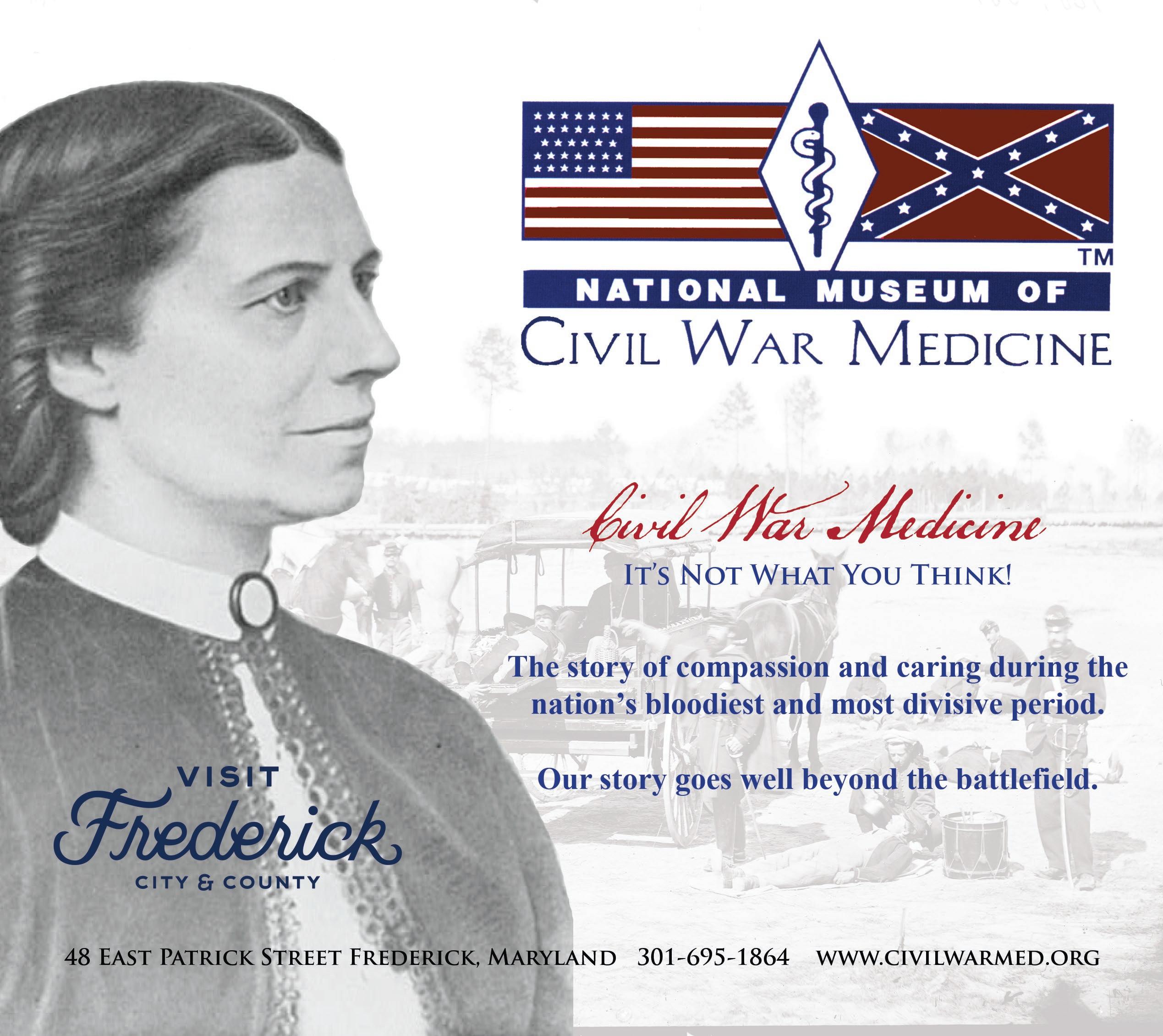

The American Battlefield Trust is dedicated to preserving America’s hallowed battlegrounds and educating the public about what happened there and why it matters today. The nonprofit, nonpartisan organization has protected more than 50,000 acres associated with the Revolutionary War, War of 1812, and Civil War. Learn more at www.battlefields.org.
About Harpers Ferry National Historical Park Harpers Ferry National Historical Park is one of more than 400 national parks cared for by the National Park Service. The
3,500-acre park preserves, protects, and interprets the nationally significant history of Harpers Ferry which includes the topics of natural heritage, industry, transportation, John Brown’s Raid, the Civil War, and African American history. Located in West Virginia, Virginia, and Maryland, the park features over 20 miles of hiking trails. For more information, visit www.nps.gov/hafe.
“From front to back: American Battlefield Trust board member Lt. Gen. Richard Mills, USMC (Ret.), Harpers Ferry National Historical Park superintendent H. Tyrone Brandyburg and Harpers Ferry Park Association executive director Catherine Baldau sign a ceremonial deed to mark the Trust’s transfer of Allstadt’s Corner to the National Park Service.”
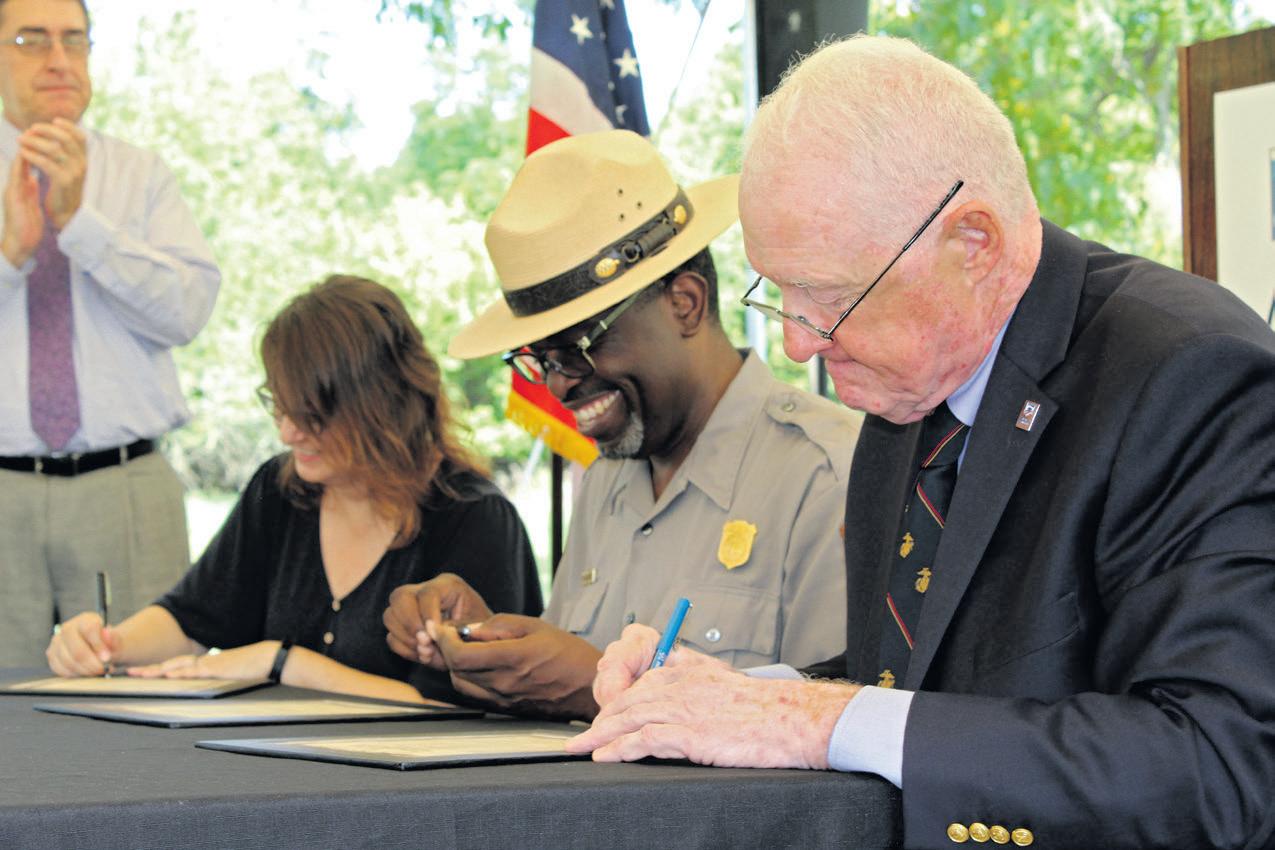
(American Battlefield Trust)
“From left to right: Dan Neff with the office of U.S. Rep. Alex Mooney, Cathy Baldau of the Harpers Ferry Park Association, Harpers Ferry National Historical Park superintendent H. Tyrone Brandyburg, American Battlefield Trust board member Lt. Gen. Richard Mills, USMC (Ret.), and Keith McIntosh with the office of U.S. Sen. Joe Manchin stand next to the signed ceremonial deed in front of Allstadt’s Ordinary, a historic structure located on the Allstadt’s Corner property built circa 1790 that played an important role in John Brown’s 1859 raid on the Federal arsenal at Harpers Ferry.”

(American Battlefield Trust)

33 October 2019 Civil War News Want to Advertise in Civil War News? Email us at ads@civilwarnews.com
Subscribe online at CivilWarNews.com
From the Editor
When Kris White, Jake Struhelka, and I sat on the porch of the caretaker’s cottage at the Jackson Shrine in the summer of 2011, kicking around the idea of starting up a blog, it was kind of a lark, to be honest. We wanted to create a platform that would allow us to showcase the work of a small group of young historians whose work we believed in—“emerging voices” in the field, as we envisioned it. Thus, Emerging Civil War was born. Beyond that, we didn’t necessarily have an end goal in mind. We just wanted to get the blog up and going and then see where things would take us from there.
From the outset, we’ve tried to operate in the spirit of a nonprofit organization, but for a long time, there wasn’t really any need to be formal or official about it. Behind the scenes, we’ve always thought of ourselves as a little “mom and pop” operation.
However, ECW has experienced a tremendous amount of growth since that cigar-smokefilled evening eight years ago. As an organization, we’ve adapted as we’ve grown, and not without growing pains. Finally, this year, we reached a point where we had to “get official” about a few things.
ECW no longer operates in the spirit of a non-profit but, instead, we officially are a non-profit corporation, as registered with and recognized by the Commonwealth of Virginia. We’re especially proud of this step because it reflects the support so many people have shown for our educational mission.
We’re still working on the IRS
end of things, so although we’re not yet a 501(c)3, we are moving in that direction. We don’t intend to get into the fund-raising business as there are plenty of other worthy Civil War organizations who need your money more than we do! We do hope this will eventually open us up to some additional funding sources that’ll help us keep the lights on, a key part of the inglorious work every mom and pop worries about in their behind-the-scenes work.
Thank you for your ongoing support of Emerging Civil War. We’re deeply grateful that you’ve joined us as we continue the journey. As Kris White’s wife said to him, “Not too bad for three idiots sitting on a porch.”
— Chris Mackowski, Ph.D. Editor-in-Chief, Emerging Civil War
The Seventh Annual Emerging Civil War Symposium at Stevenson Ridge


Mark your calendars for the first full weekend in August 2020! Yes, the dust is still settling from this year’s ECW Symposium, but we’re already looking ahead toward Aug. 7-9, 2020.
Our theme next year will be “Fallen Leaders.” Our keynote speaker will be Gordon Rhea, who’ll talk about the loss of Jeb Stuart at Yellow Tavern and its impact on the Army of Northern Virginia. Our Sunday tour, led by Greg Mertz, will look at the wounding of James Longstreet in the Wilderness.
We’ll announce our full line-up of speakers later this fall.
Our early-bird rate through December 31 is $155/ticket. Regular price will be $175. Order tickets and get more info at https://emergingcivilwar. com/2020-symposium/. We hope you’ll join us!
10 Questions . . . with Edward Alexander
Edward Alexander is one of ECW’s longest-serving writers. He was first profiled in the August 2016 newsletter (https:// conta.cc/2brvA5t).
You can read his full ECW bio here: https://emergingcivilwar. com/author-biographies/authors/ edward-s-alexander/.
are just renditions of a previously made map and do not include the locations and troop movements actually mentioned in the text.
What other mapmaking are you in the midst of (that you’re allowed to share)?
misleading monuments placed during the 1910s and centennial around Petersburg.
Favorite unsung hero of the Civil War era?
The name of your company, Make Me a Map, LLC, is a cool Civil War reference. Where’d you come up with that inspiration?
Most Civil War enthusiasts will recognize the name from the famous Stonewall Jackson quote asking Jedediah Hotchkiss to make him a map of the Shenandoah Valley, which enabled Confederate forces to outmaneuver three Union armies. I had played around with a couple other name ideas, but this one seemed perfect for both being catchy as well as having Civil War relevance. I can accurately map better than I can creatively design, so I really need to commission someone to make me a logo to really take a step forward.
At our August ECW Symposium, Will Greene mentioned that he was at work on the next book in his three-volume series on the battle for Petersburg. Your maps were such a great part of volume one. Have you started work on volume two’s maps yet?
Volume 1 of A Campaign for Giants: The Battle for Petersburg was released in mid-2018. The mapping work began in October 2016 and probably took 4-6 months to complete. Will’s research and writing obviously took years to produce. His retirement is allowing him to pick up the pace, but we are still a few years out from Volume 2 hitting the shelves. Volume 1’s maps were the first I had done for publication. I have learned a lot of cartographic and graphic design skills since then, so the next batch will have a different look but hopefully quicker production. I expect to start on the basemaps soon, but I won’t be adding troop movements or labels until the manuscript is complete. One thing about Volume 1 that really satisfied us was how the maps matched the text. That is critical for a book. My biggest pet peeve as a reader is when it is obvious that a book’s map details
In addition to working with Will, I have a few projects for the Emerging Revolutionary War Series (Monmouth, Valley Forge, and Morristown/Middlebrook), a few for the Emerging Civil War Series (Hampton Roads, Elmira, and Joshua Lawrence Chamberlain’s battles), and just finished up a unique map set of World War 2 Burma for Chris Kolakowski. Have a few other projects outside the ECW umbrella, too, a busy slate!
Is there anything you’d really like to make a map of that you don’t necessarily foresee a chance to do?
Everything is still a learning experience, so I’ve dabbled in a few projects that I haven’t been contracted to do. One of these is a Richmond brewery map. Making products that aren’t battle or campaign projects allows me to experiment with different graphic design styles that I can go back and incorporate into my typical projects. I’d also love to work more with online, interactive maps but really only have the time to work on print products.
You’ve been concentrating a lot lately on your mapmaking, but are you working at all on any writing projects these days?
I’ve really had to set aside writing to focus on mapping. Unfortunately, I have a few halfbaked projects that never really made it over the hill. But I’m excited to be working on an essay on the battle of Five Forks in memory for an upcoming “Engaging the Civil War” series title.
Lightning Round (short answers):
Favorite primary source?
The diary of William Wallace Perry, 82nd Pennsylvania Infantry, in the Joyner Library at East Carolina University. Perry was among the youngest actual infantry soldiers in the Army of the Potomac and kept a well-written journal. He has great commentary on the last year of the war, particularly the Petersburg Breakthrough.
Favorite Civil War-related monument?
Hard to say. I know as a kid I loved the Warren statue on Little Round Top. My least favorite are all the woefully inaccurate,
Captain Charles Gilbert Gould, 5th Vermont Infantry, the first man over the works at the Petersburg Breakthrough. He’s starting to receive more credit.
What’s a bucket-list Civil War site you’ve not yet visited?
I’ve been to almost all the ones I’d want to see, but I’d love to revisit some of the places like Vicksburg and Shiloh that I haven’t seen since being a kid.
Favorite ECWS book that’s not one of your own?
Grant’s Last Battle: The Story Behind the Personal Memoirs of Ulysses S. Grant. Just a fascinating story of Grant racing to take care of his family before he dies and an illumination of the behindthe-scenes that produced one of the pinnacle memoirs of the war.
ECW News & Notes
Edward Alexander recently spoke to the Western North Carolina Civil War Round Table and took advantage of being out that way to visit the Great Smoky Mountains for the first time. He also followed a barbecue trail back home. He notes that Rising Smoke BBQ in South Hill was the best of the batch.
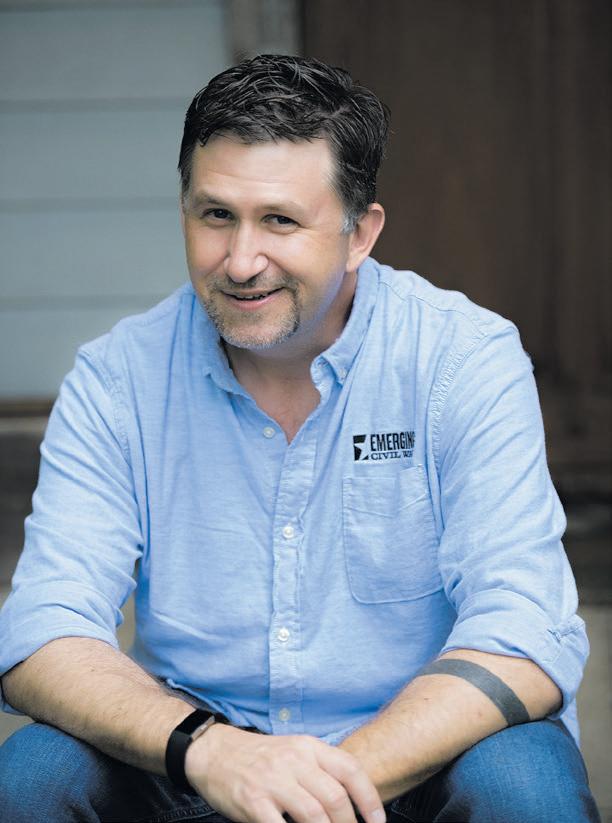
Steve Davis’s “Critics Corner” in the September issue of Civil War News focused on Jonathan D. Sarna’s When General Grant Expelled the Jews. Steve also shared a great personal story in that issue about the sale of the first copy of his new book, 100 Significant Civil War Photographs: Atlanta Campaign. Steve and publisher Jack Melton are at work with America’s Civil War magazine on a photo essay for the January 2020 issue that highlights some of those “significant Civil War photographs.”
Jon-Erik Gilot joins a dozen other ECWers authoring for the Essential Civil War Curriculum, a project of the Virginia Center for Civil War Studies at Virginia Tech. More information on this project may be found at: www. essentialcivilwarcurriculum.com
Steward Henderson is working on a new Slavery and the Civil War battlefield tour for Fredericksburg Tours. Look for this new tour soon.
34 Civil War News October 2019
www.emergingcivilwar.com
Chris Mackowski
Chris Kolakowski’s review of
Edward Alexander at the 2019 ECW Symposium.
Darrell L. Collins’ The Army of the Cumberland: Organization, Strength, Casualties, 1862-1865 appeared in the September 2019 issue of Civil War News.
Chris Mackowski’s review of A. Wilson Greene’s A Campaign of Giants: The Battle for Petersburg (vol. 1) also appeared in the September 2019 issue of Civil War News.

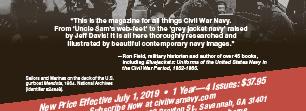
Derek Maxfield, of Rudely Stamp’d, will perform the play Now We Stand by Each Other Always on
• August 24th at the Attica Historical Society, Attica, NY at 2:00 PM,
• Sept. 7th at Genesee Community College Medina Campus Center, Medina, NY at 1:00 PM,
• Sept. 21st at BuffaloNiagara Heritage Village, Amherst, NY at 1:00 PM, and
• Oct. 23rd at the Hornell Public Library, Hornell, NY at 6:30 PM.
“If you can make one of these performances,” he says, “you won’t want to miss it!”
Kevin Pawlak’s new book, Antietam National Battlefield, in the Images of America series, recently hit the shelves. Look for it at your local book retailer.

Kolakowski talked about the Civil War connections of Gen. Douglas MacArthur.

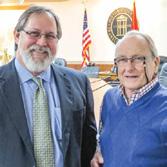
Podcasts are $1.99/episode and are available at https://www. patreon.com/emergingcivilwar. Proceeds go to support production of the podcast.
Douglas MacArthur and the Civil War: “The Reunion of Blue & Gray Personified”



The American Civil War was an immediate and formative experience for Douglas MacArthur’s parents and their families, and their experiences helped inspire and shape MacArthur. MacArthur’s wife also had a significant Civil War pedigree. Between them, General and Mrs. MacArthur had ties to virtually every major land campaign east of the Mississippi River.
The MacArthur Memorial and Emerging Civil War are co-sponsoring a symposium with four scholars exploring the Civil War activities of Douglas and Jean MacArthur’s ancestors. Speakers include Chris Mackowski, Charlie McKnight, Dan Welch, and Brian Steel Wills. Chris Kolakowski will moderate.
Join us on September 28, 2019, from 9:15 a.m. – 3:00 p.m. at the MacArthur Memorial, 198 Bank Street, Norfolk, VA 23510. The event is FREE, but registration is required. Call 757.441.2965 to reserve a seat or register online.
Revolutionary War News


September 28, 2019, in partnership with Gadsby’s Tavern Museum in Alexandria, Virginia. It’s only $60 to reserve your seat. In addition, check out Emerging Revolutionary War at www. emergingrevolutionarywar.org for symposium updates and highlights leading up to the day.

Speakers Bureau Spotlight
The new 2019-2020 Emerging Civil War Speakers Bureau brochure is now available. This year’s speakers bureau features twenty-three historians who offer more than 150 talks.

New this year: ECW is pleased to offer a series of talks based on our book Turning Points of the American Civil War, the first volume from our “Engaging the Civil War” Series published in cooperation with Southern Illinois University Press.
The Emerging Civil War Podcast
In our first August podcast, Chris Mackowski and Dan Welch spoke with Derek Maxfield and Tracy Ford of the Rudely Stamp’d Theater Company. Maxfield and Ford portray Ulysses S. Grant and William T. Sherman in the two-man show Now We Stand By Each Other Always.
In our second August podcast, Chris Mackowski and Chris
The month of August in American Revolutionary military history saw highs and lows for the American cause. Paulus Hook, which saw a nighttime strike by “Light Horse” Harry Lee, was fought in this month, along with some of the battles of the Saratoga Campaign. In the southern theater, in 1780, one of the worst defeats for the Continental Army happened in South Carolina at Camden. Many of these sites are preserved today by local, state, and/or national parks for you to visit and explore. Some of these battles will also be the subjects of Emerging Revolutionary War Series titles in the coming years.
Let’s cast an eye though toward September and the first Emerging Revolutionary War-partnered symposium, “Before They Were Americans: A Prologue to the Revolutionary War.” The ERW Symposium is being held on
You can download a free PDF of the brochure here: https://emergingcivilwar. com/upcoming-presentations/ speakers-bureau.
35 October 2019 Civil War News Digital Issues of CWN are available by subscription alone or with print plus CWN archives at CivilWarNews.com
SpeakersBureau 2019—2020
ECW’s new speakers bureau is now available.
www.emergingcivilwar.com
Deadlines for Advertising or Editorial Submissions is the 20th of each month. Email to ads@civilwarnews.com Want To Advertise In Civil War News? Email us at ads@civilwarnews.com Call 800-777-1862 Civil War News Vol. 42, No. 48 Pages, April 2016 $3.00 Battlefield Of Franklin Land Preservation Purchase---------H Franklin see page
Antietam National Battlefield by Kevin Pawlak is part of Arcadia Publishing’s “Images of America Series.”
Looking at the Work of Sherman’s Cameraman
100 Significant Civil War Photographs: Atlanta Campaign. By Stephen Davis. Introduction, bibliography, index, 126 pp., 2019. Historical Publications, LLC, www.historicalpubs.com. $19.95 softcover.

Reviewed by Gordon L. Jones
Memoir by One of General Sherman’s Scouts
The Perfect Scout: A Soldier’s Memoir of the Great March to the Sea and the Campaign of the Carolinas. By George W. Quimby. Edited by Anne Sarah Rubin and Stephen Murphy. Notes, maps, bibliography, index, 224 pp., University of Alabama Press, www.uapress.ua.edu. $29.95 cloth.

Reviewed by Paul Taylor
Quimby’s recollections as a scout in General William T. Sherman’s army during the legendary 1864 “March to the Sea” and 1865 Carolinas Campaign.
This is just the kind of Civil War book I want: super-clear photographs, crisp captions that tell me what I want to know, all in a handy and affordable format. And, it’s an author you can trust: Stephen Davis, master of what he aptly terms “Barnardiana,” the study of George N. Barnard’s 1864 photographs of Atlanta and the Atlanta Campaign.

Even if you’re an old Civil Warrior and think you’ve seen it all, ponder this question: if you had to choose 100 photographs of the Atlanta Campaign, which ones would you pick? Davis starts by breaking down all the available images (Barnard produced well over two hundred) into thematic chapters. So you have portraits of the generals (not made by Barnard), Confederate fortifications (why the U.S. Army hired Barnard in the first place),”War Scenes” (the campaign north of Atlanta), followed by “Federals in Atlanta,” “City Scenes,” and “Wrecking Atlanta.” Among many nuggets
in these pages, don’t miss the “less familiar view” of Barnard’s iconic “Destruction of Hood’s Ordnance Train.” It’s less familiar because it’s never been published before.
My favorite chapter is in the middle of the book: “Barnard Under the Microscope.” Here Davis draws on the work of Bob Zeller, Garry Adelman, Ken Denny, and many others whose careful dissections of the high-resolution scans produced by the Library of Congress in the mid-2000s revealed hidden and quite telling details of otherwise taken-for-granted scenes. Do you know how we can date Barnard’s images of occupied Atlanta? By reading the dated concert notices pasted on the buildings, of course. Do you know why a lone African American soldier sits in front of the slave market on Whitehall Street, reading a book? Neither does anybody else, but there he is with corporal’s stripes and a U.S. Model 1861 rifle-musket.
If you think it’s hard deciding which images to include, try captioning them in half a page (it’s one image per page). Davis’s captions are pithy and cut right to the cool details. For example, that’s not just any horse under General Sherman, it’s “Duke.” Or, “Joe Wheeler earned his nickname, ‘Fightin’ Joe, ‘fightin’ Indians.” By the way, the names of those U.S. officers in front of the Windsor Smith house (view #1) are known today only because a copy of the photograph was discovered in the 1940s with the names on the back, probably written by one of the officers.
For those who worry that we can’t get the next generation interested in the Civil War, buy this book for your kids. Even better, this is just the first in a series –the next volume is Charleston.
The published memoirs of Civil War soldiers exist by the hundreds if not thousands, yet this work stands unique in that it is one of only a handful written by a man who served as a scout in either army. These were the uniformed men formally assigned to their respective armies who utilized stealth and speed as they gathered enemy intelligence, generally on the flanks or even in the rear of the march. Meanwhile, their columns utilized advance guards or pickets toward the front. These activities separated scouts from spies who may have assumed secret civilian or military identities as they pretended to work for one side, while secretly feeding intelligence to the other. This is the important groundwork that author and Union scout George Quimby (1842–1926) sets out to convey to his readers.
On occasion, though, that distinction became blurred. In Quimby’s case, he explains how he often rode into enemy territory wearing Confederate grey as a ruse to gain the locals’ trust or to slip past Confederate pickets. Left unsaid is that had he been captured by the Rebels in such attire, he most likely would have faced an immediate hanging.
Readers will learn via the Introduction that Quimby first enlisted in 1862 with the 32nd Wisconsin Infantry and served in that regiment in western Tennessee and near Vicksburg before marching toward Georgia. The core of this book, however, is
Quimby’s memoir is certainly captivating for his war recollections. In one instance, for example, he details his disagreement with General Sherman’s recollections over a particular incident in the latter’s Memoirs. Even better are Quimby’s homespun accounts of his impressions and stories of contact with enemy soldiers, white civilians—especially trying to flirt with angry Southern women—and African American slaves. The author kept his personal politics out of his story; nonetheless, an element of sympathy shines through toward the hardscrabble Southern farmer who had little time to focus on war but merely wanted to feed his family. Quimby had low regard for the infamous “bummer” who “liberated” hams or chickens from the poor; however, his disapproval was less so when the homes of wealthy Southerners were plundered.
Also enlightening are his tales of capturing Confederate scouts and pickets—often only briefly, for these men would consistently try to escape. Those butternut-or grey-clad clad men were always treated with respect by Quimby for he and his men knew that if—and when—the tables were turned, they wanted to be treated in a similar manner.
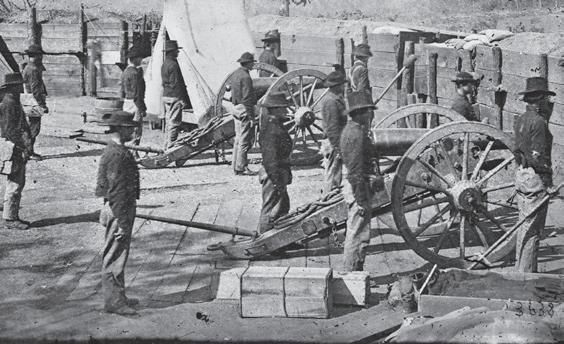
Quimby wrote his memoir around 1901 and it is filled with derring-do and hilarity. His
explanation as to how he and his fellow scouts would give fake commands in loud voices when the enemy was near-–in the hope that their adversaries would think they were leading a much larger force—will certainly bring a smile to any reader’s face.
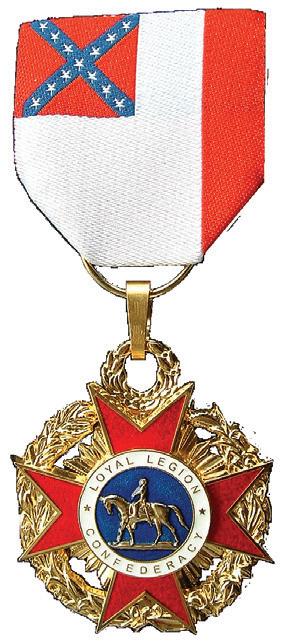
As Professor Anne Sarah Rubin points out in her illuminating Introduction, this memoir indeed reads more like an adventure novel than a dry retelling of names and dates. Such books written from memory long after the fact should generally be taken by the reader with a grain of salt; however, in this case, we are told that Quimby’s neatly typewritten manuscript often referred to other historical evidence to support his version of events.
Though family lore often told of Quimby’s Civil War exploits, it appears the typed memoir lay dormant and unseen until 1990, when Stephen Murphy (the husband of Quimby’s great-great-granddaughter) found it in three legal-sized folders while cleaning out the house of his wife’s recently deceased father. Civil War students everywhere should be thankful that Mr. Murphy made his fortuitous discovery.
Paul Taylor is an award-winning author of seven books pertaining to the Civil War era. His new book is titled “The Most Complete Political Machine Ever Known”: The North’s Union Leagues in the American Civil War, recently published by Kent State University Press.
36 Civil War News October 2019
Loyal Legion of the Confederacy CSA National Defense Medals & other banned internet items Civil War Recreations WWW.CWMEDALS.COM cwmedals@yahoo.com 1 Smithbridge Rd., Unit 61, Chester Heights, PA 19017 widely telegraphed famous for photographic engineer to hundred of site of July 22, photographer’s at West widow. History in though STEPHEN DAVIS 100 SIGNIFICANT CIVIL WAR PHOTOGRAPHS ATLANTA CAMPAIGN
Gordon L. Jones is Senior Military Historian at the Atlanta History Center.
Contact Stephen Davis, Civil War News Book Review Editor. Email: BookReviews@CivilWarNews.com.
Two Years of Adversity and Exhilaration
Blue-Blooded Cavalryman: Captain William Brooke Rawle in the Army of the Potomac, May 1863-August 1865. Edited by J. Gregory Acken. Notes, index, 352 pp., 2019. Kent State University Press, www.KentState UniversityPress.com. $49.95 cloth.

Reviewed by David Marshall

serve with the Cavalry Corps of the Army of the Potomac through the spring of 1864, fighting partisans and guerillas in northern Virginia and seeing action during the Bristoe Station and Mine Run campaigns of late 1863. Their fighting involvement stopped prior to the Overland Campaign. These men went on to provide security for Union General George Meade and his headquarters staff, escorting prisoners, gathering up stragglers during combat, arresting deserters, and guarding large herds of cattle.
Stories of Famous and Not-So-Famous Confederate Ironclads

Confederate Ironclads at War. By R. Thomas Campbell. Maps, photos, illustrations, endnotes, index, appendix, 276 pp., 2019. McFarland, McFarlandBooks.com. $49.95 softcover.

Reviewed by Gould Hagler
William Brooke Rawle was born into a privileged Philadelphia family. As a nineteen-year old he finished his studies at the University of Pennsylvania in May 1863 and within two months had participated in the battles of Brandy Station and Gettysburg with the 3rd Pennsylvania Cavalry. Instead of attending his college graduation, fighting the Army of Northern Virginia’s cavalry on July 3 in East Cavalry Field turned out to be the “supreme moment” of his life. The young man gave up a refined, cultured life of wealth and luxury for two years of adversity, challenge, and exhilaration.
The 3rd Pennsylvania Cavalry was organized during the summer of 1861. Its second commander, Colonel William Averell, imparted Regular Army responsibilities and practices to the volunteers and prepared them for the burdens they would face. Averell appointed many officers who had prior military experience, but many did not. Rawle and the sons of many other prominent Philadelphia families such as the Newhalls, Stilles, Treichels, and Wetherills were commissioned as officers into the regiment. J. Gregory Acken makes an excellent point that many of the enlisted veterans did not accept these appointments and viewed Rawle and his colleagues as unqualified men who had prevented the advancement of more capable individuals from the ranks.
Following the Gettysburg Campaign, Brooke Rawle and the Third Pennsylvania would

A painstaking diarist and letter writer, Brooke Rawle documented almost everything that he observed in 150 well-written letters sent home to his family over the twenty-seven months he spent in the Union army. 136 of these letters are included in this volume. The letters, augmented by Rawle’s diary entries, provide a captivating and richly comprehensive eyewitness account into the life of a regimental cavalry officer during the last two years of the Civil War in the eastern theater. The typescript duplicate of the diary, completed in 1898, contained 154 single-spaced, single-sided pages and was entitled “Diary of Service with the Army of the Potomac.” Most of the correspondence was written to Rawle’s mother; however, once he wrote one of his sisters and advised that his letters needed to be kept private. Though the lieutenant participated in a few important and deadly battles, rarely were any specifics from the fighting mentioned in the communications home.
While Rawle wrote a great deal concerning his military service, he left no record of why he joined the army. Sadly, he never mentions how the political and military events of the war influenced him or his opinion of anything prior to enlisting in 1863. Additionally, he remained quiet on slavery. However, during his postwar life, he wrote histories of several prominent Philadelphia families and a study of the cavalry fighting on the Union right flank at Gettysburg on July 2-3. Acken’s use of numerous photographs and George Skoch’s excellent maps are most effective and helpful.
While an expensive volume, Blue-Blooded Cavalryman is well written and tells much about the life of a Northern cavalry officer in the last two years of the war.
David Marshall teaches high school history in Miami.
The CSS Virginia, which battled the USS Monitor in the Civil War’s most famous naval engagement, was but one of 34 ironclads built by the Confederacy and one of 25 put into service. Some never fired a shot at the enemy; some, like the Virginia, saw temporary success and wreaked havoc, at least for a while. Most were well-armed with rams as well as guns. They punched hard, and could take a punch too. Only one Confederate ironclad was sunk by the enemy.
From the James River to the Mississippi and the Red these ungainly craft fought with tenacity in the South’s effort to break the blockade and to keep its inland waterways free of the enemy. In Confederate Ironclads at War, R. Thomas Campbell capably tells the story of these ships, the men who built them and the officers and crews who sailed them into action.
In fourteen chapters, each of which stands alone as the history of a single ship or a squadron, Campbell tells how these ships were constructed; how the builders struggled to do their work in the face of dire shortages of every kind; how the workers somehow made repairs after breakdowns and battle damage; how the ships struggled to maneuver with woefully underpowered engines; and how, on rivers and in coastal waters from Virginia to Louisiana, the crews slugged it out with their foe.
Everybody who reads this
review knows about the March 1862 battle in Hampton Roads, but many, I am sure, are far less familiar with the history of the Albemarle, the Louisiana, the Tennessee, and the many other ironclads featured in Campbell’s account. Excellent diagrams show us how the ships were designed. We learn a great deal about the industrial enterprises responsible for the work. Many readers will meet officers with whom they were not previously acquainted, like Comdr. James Johnston and Comdr. Isaac Brown, and become more familiar with the likes of Adm. Franklin Buchanan, Comdr. James Bulloch and Lt. Catesby ap Roger Jones. Campbell draws on many primary sources as well as secondary material. His own narration is supplemented by interesting passages written by the men who built the ironclads and who officered them in battle.
Campbell, who has written and edited several other books on the Confederate Navy, points out that as the war progressed the authorities realized that their “behemoths were in no way seaworthy and could not challenge the Union blockade.” They focused instead on smaller, more nimble ironclads to protect their rivers and harbors. Still, they did not give up completely on ocean-going ironclads. The CSS Stonewall, built in Bordeaux,
managed a stormy Atlantic crossing in 1865. Arriving in Havana on May 11, the ship’s captain, Thomas Jefferson Page, learned that he was too late. Page refused generous surrender-terms offered by an old friend commanding a U.S. ship in the same harbor. Instead, he sold the vessel to the captain-general of Cuba for the sum of $16,000. The officers and crew were paid off by the proceeds of this sale.
An appendix lists the officers and crewmen assigned to six of the more significant Confederate ironclads. There is no glossary of naval terms, so landlubber readers, like this landlubber reviewer, must keep a dictionary on hand for words like keelson, sponson, holystone, and kedge.
Gould Hagler is a retired lobbyist living in Dunwoody, Ga. He is a past president of the Atlanta Civil War Round Table and the author of Georgia’s Confederate Monuments: In Honor of a Fallen Nation, published by Mercer University Press in 2014. Hagler speaks frequently on this topic and others related to different aspects of the Civil War and has been a regular contributor to CWN since 2016.

37 October 2019 Civil War News Subscribe at CivilWarNews.com
An Approachable Look at the Battle of Antietam for Beginners and Novices

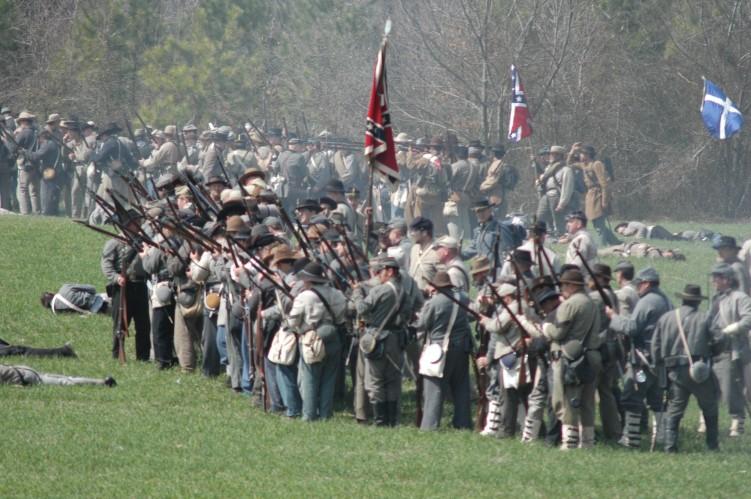

Visual Antietam Vol. 1 Ezra Carman’s Antietam Through Maps and Pictures: Dawn to Dunker Church. Edited by Brad Butkovich. Illustrations, maps, bibliography, index, 230 pp., 2018. Historic Imagination LLC, www.historicimagination.com. $19.95 paperback.
Reviewed by Claire Affinito
present a new look on the battle of Antietam with “an emphasis on visual context.” However, he fails to provide anything new or unique to this highly scrutinized battle. The main text is composed of Ezra Carman’s famous manuscripts on the Maryland Campaign. Butkovich accompanies Carman’s text with 63 images and 26 maps. This is the first in a series of three books that follow the chronological order of the battle. Volume One focuses on the first four hours of the battle that begins with the Union advance at dawn and ends with the fighting around the Dunker Church. All three volumes combined will trace the beginning of the battle to its conclusion.

In Visual Antietam Vol.

1: Ezra Carman’s Antietam Through Maps and Pictures: Dawn to Dunker Church, editor Brad Butkovich attempts to
Carman was the legendary early Civil War historian. As a veteran of the battle and “historical expert” for the Antietam Battlefield Board, his text is widely accepted as the most complete and accurate account of the battle. Carman used after-action reports, regimental histories, and correspondence from hundreds of veterans. His text is revered by Antietam historians. However, Butkovich’s use of Carman’s text fails to provide a new or unique perspective. Past historians have
provided richer and more indepth evaluations of Carman’s text. The most thorough of these is Tom Clemens’ The Maryland Campaign of September 1862. Clemens’s three-volume masterpiece provides an annotated and edited analysis of Carman’s work that is an invaluable source for Antietam historians. Visual Antietam takes Carman’s text in a different direction. Butkovich picks and chooses chapters of Carman’s work that only focus on the events of the battle. He keeps the text in its original form without all but the basic notes or corrections. It seems Butkovich’s intention was to create a volume that could be carried onto the battlefield. He does succeed in making the book small and compact. However, in doing so, he loses some of the explanation and clarification that are necessary to truly understand Carman. Therefore, if you are a serious historian who wants a detailed look at Carman’s text and the battlefield, this book is not for you. However, I would recommend it for a more casual observer of Antietam or those who will be taking a trip to the battlefield and want a portable companion guide.
The most valuable sections
of Visual Antietam are its maps and images. The maps are Butkovich’s own and are impressive in their detail. Each of the 26 maps includes topographical and terrain details including elevation, crops, and fences. These details are overlaid with troop movements down to the regimental level. Along with these maps, there are 63 images including photographs taken by the author on the battlefield. The author’s images provide the reader with a good understanding of the terrain and view of the battlefield today, which is very useful to readers both on and off the field. Together the maps and the images allow the reader to visualize the battlefield. However, these great assets have a major drawback. In the paperback edition that I reviewed, all the maps and images were in black and white. This is a major detriment to such a noble endeavor. Butkovich’s goal in Visual Antietam of bringing the battle to life is lost with the absence of color. His maps are highly detailed and this feature at times becomes lost. Likewise, some of his photos are dark and hard to see.
Bradley Gottfried’s The Maps of Antietam contains similar maps in color. Therefore, the utility of
the book is diminished with the absence of color.
Overall, if you are a longtime historian of Antietam this book is not for you. You can find the major components of this book in greater detail elsewhere. If you want comprehensive and easy-to-read maps of Antietam, Gottfried’s The Maps of Antietam is for you. If you want an in-depth look at Ezra Carman’s manuscript of the Maryland Campaign, see Tom Clemens’ The Maryland Campaign of September 1862. However, if you are a casual or novice historian on the battle of Antietam, Visual Antietam is worth your while.
Claire Affinito graduated in May 2019 from Shepherd University with her bachelor’s in history. She is currently an education intern at Antietam National Battlefield.
Digital Issues of CWN are available by subscription alone or with print plus CWN archives at CivilWarNews.com
38 Civil War News October 2019
Grant’s Masterpiece: The Vicksburg Campaign
The Decision Was Always My Own: Ulysses S. Grant and the Vicksburg Campaign. By Timothy B. Smith. Notes, index, 249 pp. 2018, Southern Illinois University Press, www.siupress. com. $34.50 cloth.
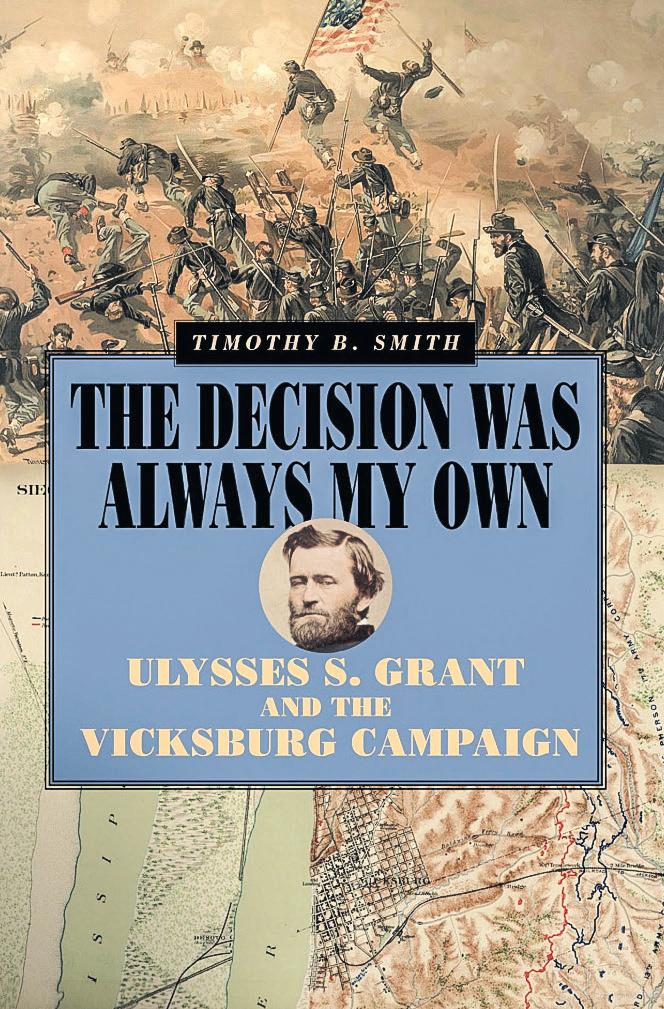
Reviewed by Greg Biggs
graduated officers with more of an engineering background than tactical/strategic background and that the better graduates would grow in their respective commands. That Grant was able to do what he did at Vicksburg, a ninemonth campaign covering no less than six attempts to take the city, is a real testament to his abilities as a military commander along with his ability to be flexible on the battlefield and operationally. Smith correctly labels Grant a Clausewitzian commander rather than a Jominian one (pretty much the rest of the Civil War commanders) despite the fact that Grant had never read a word of the Prussian theorist.
Contributions of Civil War Chaplains
reports and daily communications. Smith’s book offers plentiful examples of each and how Grant dealt with them. Yet when things seemed to go against him, Grant just dug in his heels and figured out a different way to get things done. Halleck got testy as time wore on but Lincoln, seeing the bigger picture, wrote Grant, “I know that you can judge these matters there much better than I can here,” showing well how officials in Washington rarely understood realities in the field.
In God’s Presence: Chaplains, Missionaries, and Religious Space during the American Civil War. By Benjamin L. Miller. Photos, notes, bibliography, index, 268 pp., 2019. University Press of Kansas, www.kansaspress.ku.edu. $39.95 hardcover.

Reviewed by Sean A. Scott
non-sectarian churches exhibited a degree of ecumenism that foreshadowed postwar shifts in the religious landscape.
Some Union chaplains ministered to black soldiers or freedmen, providing a glimpse of racial equality that leaders of some denominations briefly pursued during Reconstruction before segregated churches, oftentimes favored by both blacks and whites, became the norm.
Historian Tim Smith has once again penned a wonderful work that takes a look at the Vicksburg Campaign, but not in the typical manner of a campaign or battle study (the latter he has done with his excellent book on Champion Hill). Rather, he makes an examination of how Union General Ulysses S. Grant looked at the problem of taking the city and how he made his decisions to do so during the campaign.
Smith organizes the book into eight chapters, each one focusing on a specific decision Grant made. These decisions and their outcomes are somewhat explained in the Introduction and Prologue where Smith compares Grant to a four-year college student with West Point being the freshman year in his military growth. The classroom of the Mexican and Civil War battlefields took care of his three other “college” years quite well, the whole point being that West Point
Upon assumption of command of the Department of Tennessee in October 1862, Grant wrote his boss Henry Halleck, asking what was expected of him and his new command. After not being prohibited to begin an offensive, Grant did just that, thus showing one of his prime attributes as a commander. Smith delves into this—covering Grant’s proposed lines of advance, his corresponding supply problems, and manpower needs for a successful offensive. All this culminated, however, in the defeat Grant suffered in December when Confederate cavalry raiders smashed his railroad line of supply and Sherman was repulsed in his thrust down the Mississippi River. Despite this, as Smith shows, Grant displayed talent in getting multiple columns moving into Mississippi in a coordinated manner.
Within the Vicksburg Campaign Grant had to deal with his own subordinates (some of whom he liked and some he did not, McClernand being at the fore of the latter), his logistics, Confederate movements and reinforcements, his own family (son Fred and wife Julia attended him during the campaign), as well as writing mounds of paper to his superiors in terms of
How Grant dealt with McClernand takes up a fair bit of Smith’s account. Grant changed his opinion from good (“McClernand performed his job with much skill and without loss”) to bad, and when McClernand finally got on Grant’s nerves for too long, he was able to fire him.
The work culminates with how Grant dealt with the captured Confederate garrison of some 30,000 troops as well as how he made sure his own rear was protected from Joe Johnston’s Confederates. Grant also had to deal with superiors who balked at the proposed parole of the large Rebel army. Halleck, somewhat a thorn in Grant’s side to this point in the war, complimented him with a telegram comparing his victory to that of Napoleon at Ulm.
This is a fine study of Grant and how he tackled the Vicksburg dilemma. It is well researched and written and uses often the words of those involved to move the story along. Smith’s analysis is even-handed. If you ever had doubts as to Grant’s ability as a commander or perhaps thought him overrated, this book should shatter those conceptions. Grant was the pinnacle of Civil War commanders, Vicksburg was his masterpiece and Tim Smith nails it.
Greg Biggs, of Clarksville, Tenn., has studied military history from the Spartans to today. His main interests include the Napoleonic Wars, Civil War and World War Two and tanks/armor. He is also a recognized authority on Civil War flags. Greg lectures across the country to roundtables, museums and other history groups and conducts Civil War tours for history groups and staff rides for the U.S. Army.
The Civil War impacted countless aspects of everyday life, including religion. In this clearly written study Benjamin Miller applies the concept of spatial theory to illuminate continuity and change in religious practices from the antebellum era to the war. Chaplains, and to a lesser extent civilian missionaries sent to visit the troops, served as catalysts that helped transfer religious meaning from “static physical spaces” of churches at home to battlefields, camps, hospitals, and prisons. In essence, “by their presence” chaplains brought “dynamic sacred spaces” to these war settings. The book provides a valuable collective portrait of the duties and daily experiences of chaplains. Of course, the methods and messages of these religious leaders changed little from their prewar work among their congregations. Preaching outdoors or in makeshift chapels shared similarities with antebellum revivalism. Encouraging Bible reading and prayer, admonishing men to resist temptation and shun sin, and winning converts through personal testimony and exemplary living remained a constant theme of pastoral work whether at home or in the army.
However, the war posed challenges that created new opportunities and reshaped religious practices. Most Protestant chaplains set aside denominational differences and cooperated with each other to promote a shared faith. Preaching for each other, uniting to perform baptisms and observe communion, and soliciting soldier memberships in
Miller also maintains that hospitals and prisons, new spaces of religious activity for most clergy, “proved to be the foundation for Northern and Southern civil religions that came to fruition in the postbellum era.” Imprisoned chaplains defiantly prayed for their respective armies and presidents in earshot of their captors, and hospital chaplains observed days of national thanksgiving or publicly mourned Lincoln’s death. But far from originating a patriotically imbued faith, these activities, as documented in Richard Carwardine’s Evangelicals and Politics in Antebellum America (1993) or my own A Visitation of God: Northern Civilians Interpret the Civil War (2011), merely carried on a long tradition of blending religion and politics that characterized both northern and southern churches across most denominations throughout the sectional crisis and during the war.
Diaries, personal correspondence, Union chaplains’ hospital reports, and postwar reminiscences furnish a solid source base for this study, although incorporating the abundance of chaplain letters from religious periodicals could have yielded additional insights. Miller offers a balanced description that considers Protestant, Catholic, Union, and Confederate examples to form his assessment of the valuable contributions of chaplains.
Ample anecdotal evidence confirms that some men who served as Civil War chaplains were impostors, hypocrites, or otherwise unfit for their duties, but most of their rank more readily deserved one Confederate soldier’s commendation for being “a sincere and hard working Christian.” Anyone interested in the religious history of the war should enjoy Miller’s fine addition to this growing literature.
Sean A. Scott, assistant professor of history at the Indiana Academy for Science, Mathematics, and Humanities, is writing a biography of chaplain and postwar carpetbagger missionary Nelson L. Brakeman of the 21st Indiana Volunteers.

39 October 2019 Civil War News
online at CivilWarNews.com
Subscribe
A Legacy of Valor
A Legacy of Valor: The Memoirs and Letters of Captain Henry Newton Comey, 2nd Massachusetts Infantry. Edited by Lyman Richard Comey. University of Tennessee Press, 2004.

already for a sturdy volume. Subsequently, in the rarest display of scholarly generosity I have ever encountered, Dr. Castel sent me his photocopies of Union soldiers’ manuscripts and diaries concerning the occupation, most from Northern libraries and archives that I could never hope to visit.
University of Tennessee Press in its “Voices of the Civil War” Series in 2004.
Henry Comey was 21, recently graduated from Phillips Exeter Academy, when he enlisted as a private in Co. G, 2nd Massachusetts Infantry, on May 14, 1861. He was promoted corporal in June 1862, 1st sergeant three months later, and second lieutenant in January 1863. In letters, a diary, and a memoir (written just after the war), Comey described his experiences with an arresting admixture of sensitivity and erudition. At Kernstown he saw a man’s head blown off by cannon-shot. “It was the worst sight I have ever seen in my life, and I would never forget it….but I will never be able to find the words to describe it.”
Throughout his experience, in fact, Comey found it hard to put into writing what a soldier saw. This reminds me of what I read decades ago about English Victorians: it wasn’t that they were prudish about sexuality; they just hadn’t developed the vocabulary to express it.
Slightly wounded at Cedar Mountain, Comey opined, “soldiers are so poorly informed that they often do not know much about their regiment’s success or failure in a particular battle.”
violent death and dying, and I knew I would be forever changed in some way by that experience.”
Captain Comey’s service with the 2nd Massachusetts extended to the western theater, as he followed Sherman into Georgia and the Carolinas. Through his words, artfully edited by Lyman Comey from their three sources, we have a chance yet again to understand the soldier’s experience: hardship and suffering, violence
and death, frequent skepticism of their officers, yet selfless perseverance through patriotic ardor and loyalty to comrades. Even in our armchair, reading such writing today can be for us an uplifting, emotional encounter.
Stephen Davis is Book Review Editor for CWN. His What the Yankees Did to Us was published in 2012 by Mercer University Press.
Titles By Stephen Davis
100 Significant Civil War Photographs: Atlanta Campaign


Voices of the Civil War Series, Peter Carmichael, Series Editor.

For my What the Yankees Did to Us (2012), I drew upon a number of Union soldiers’ letters, memoirs and diaries.
Some of them were unpublished, from libraries and archives. In meum opus pingue (Latin for “my fat work”—it was 527 pages!) I thanked the late, great Albert Castel. When I was reading Dr. Castel’s draft of Decision in the West in the summer of 1990, Albert told me that he had researched beyond Sherman’s capture of the city, into its occupation by Union troops. He once thought of including the Federal occupation in his book, and had accumulated research material on it; but by then he had sufficient text
Albert surprised me further when my Atlanta Will Fall: Sherman, Joe Johnston, and the Yankee Heavy Battalions was published in 2001. Unknown to me, my publisher had sent my draft to him, asking for a pre-publication assessment. Imagine my surprise when the first copy of my book arrived, and I read Albert’s blurb on the back cover: “Demolishes old myths and replaces them with new truths, and does so in a fashion that is as hard-hitting as a 20-pounder Parrott shell striking its target. To be read with profit and joy.” (Wherever you are, thank you, Albert!)
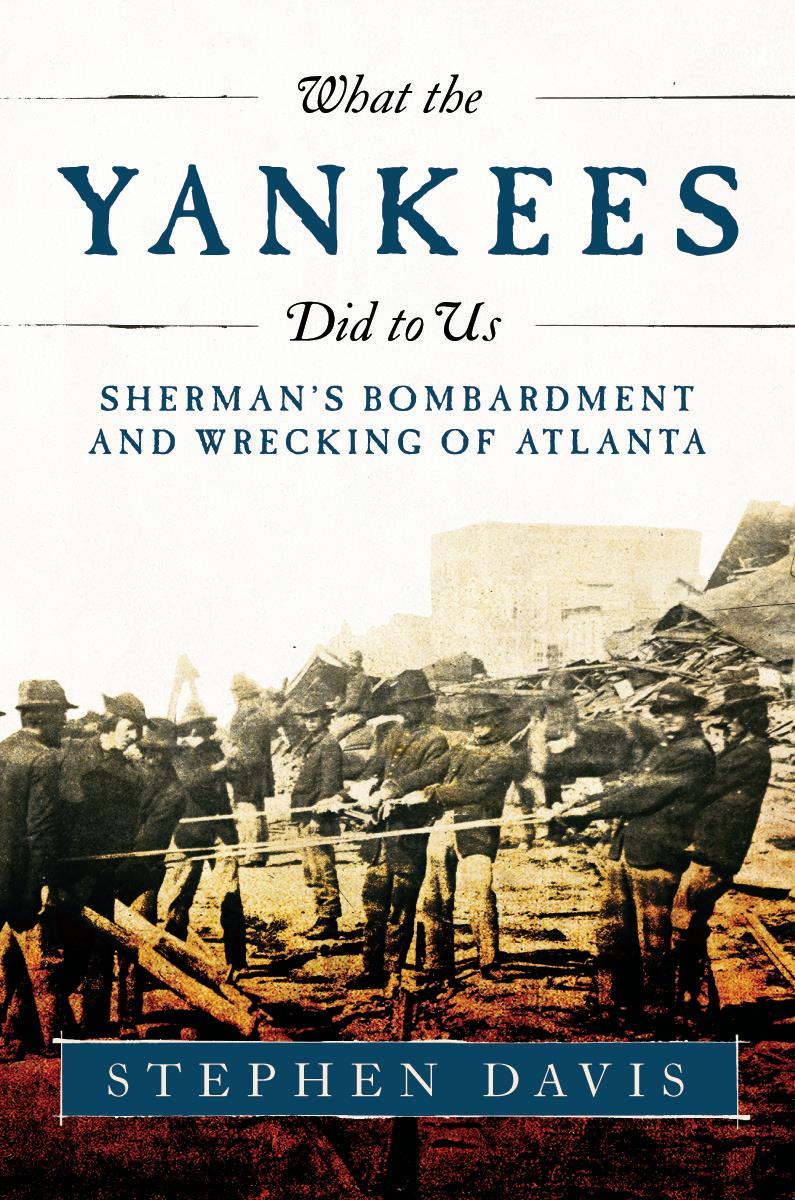
But back to the published literature of the occupation, which is rich and diverse.
Every now and then it behooves us armchair historians to put aside the increasingly microscopic battle histories and generals’ biographies, and get the real scoop on the war, which is to say, from the writings of the soldiers themselves. In my research on the Union occupation of our city, one of the most valuable sources I found was A Legacy of Valor: The Memoirs and Letters of Captain Henry Newton Comey, 2nd Massachusetts Infantry It has been edited by Lyman Richard Comey; Captain Comey was his great-grandfather’s cousin. Publication was by the
More, soldiers exercised a very justified right to question the generals’ take on a battle. Comey did: “General Pope [says] that the battle of Cedar Mountain was a ‘great victory.’ We have great doubt about that. Possibly somebody’s purpose was accomplished, but the members of the Second beg to say that ours was not.” After Antietam, Comey again found words wanting to describe what he had seen in a letter of September 18: “You must not wonder if I don’t write you. You would not if you knew.”
Then, after Chancellorsville, where he “had splattered in my face twice, men’s brains,” Comey confessed to his father that he had “so much to write, everything is mixed up.” On the third morning of Gettysburg, Comey, a captain by now, overheard his regimental commander question an order to attack the Rebels.
“Are you sure that is the order?”
“Yes,” answered the courier.
“Well, it is murder, but it’s the order. Up, men; over the works.”
Later, Comey buried the body of his colonel.
Seeing such things, Comey recorded what many of his comrades concluded: “I had learned a hard lesson of loyalty, courage and valor which I would never forget. I had also learned about
George N. Barnard’s photographs of the Atlanta Campaign
The Atlanta Campaign
While Mathew Brady, Timothy O’Sullivan and a few others won fame as photographers of the American Civil War’s eastern theater, George N. Barnard earned a reputation as the key cameraman of the war’s western area. Evidence of this is Barnard’s hundreds of photographs taken of Atlanta Campaign scenes. Some were published in 1866, but many more have appeared in the countless pictorial histories of the Civil War.
Paperback, 128 pages. $19.95 + $3.50 shipping
A Long and Bloody Task
The Atlanta Campaign from Dalton through Kennesaw Mountain to the Chattahoochee River May 5–July 18, 1864
Davis’ narrative history of the Atlanta Campaign is divided into two paperbacks from Savas Beatie’s Emerging Civil War Series. Volume One, A Long and Bloody Task, carries Sherman’s forces from Dalton in northwest Georgia to the Chattahoochee River. There the Confederate government was forced to relieve its army commander, Joseph E. Johnston, and replace him with Gen. John B. Hood.

Paperback, 192 pages. $14.95 + $3.55 shipping
All the Fighting They Want
The Atlanta Campaign from Peachtree Creek to the City’s Surrender July 18–September 2, 1864

With the Yankee army five miles outside of Atlanta, Hood promised not to give up with city without a fight— which is all President Jefferson Davis asked. Davis’ companion volume, All the Fighting They Want, describes Hood’s efforts to defend Atlanta. Its fall in early September 1864 was a mortal blow to Confederate hopes for independence and a big boost to Lincoln’s hopes for presidential reelection.
Paperback, 192 pages. $14.95 + $3.55 shipping
To order a signed copy from author Stephen Davis email: SteveATL1861@yahoo.com
40 Civil War News October 2019
The American Civil War was the first war in which both sides widely used entrenchments, repeating rifles, ironclad warships, and telegraphed communications. It was also the first American War to be extensively photographed. Mathew Brady, Alexander Gardner and Timothy O’Sullivan are famous for having made iconic photographs in the Civil War’s eastern theater. George N. Barnard deserves to be ranked in this top tier for his photographic work in the war’s western theater. A civilian photographer hired by Gen. William T. Sherman’s chief engineer to take pictures of fortifications around Atlanta, Barnard took several hundred of them in and around the city in the fall of 1864. His most famous is the site of Union Maj. Gen. James B. McPherson’s death in the battle of Atlanta, July 22, 1864. Thus far, no comprehensive, definitive listing has been made of the photographer’s work. The Library of Congress has 130 images; the U. S. Military Academy at West Point, New York, has at least 98 photographs, donated by Captain Poe’s widow. Other repositories, such as the Gilder Lehrman Institute of American History in New York City, have smaller collections. For this book we have chosen a hundred images we deem “significant,” though other students may wonder at some of our selections. We hope that this work will stimulate further interest in Barnardiana, and that other scholarly volumes are yet to come.
STEPHEN DAVIS 100 SIGNIFICANT CIVIL WAR PHOTOGRAPHS ATLANTA CAMPAIGN
Atlanta Campaign

1. Who was the Union army commander killed in the battle fought east of Atlanta on July 22, 1864?
2. Who was Johnston’s and Hood’s cavalry commander?
3. What was William T. Sherman’s middle name? And from it, his nickname?
4. Who was senior corps commander in the Army of Tennessee after Hood was promoted to lead it?
5. Commander of the Union XV Corps during the campaign was this Illinoisan, nicknamed “Black Jack.” Who?

6. Hood fought three attacking battles on July 20, 22, and 28. What was the name of the third, fought west of the city?

7. This Union major general of cavalry was captured July 31 northeast of Macon. He had formerly commanded the Army of the Potomac’s cavalry under Hooker. Who?
8. Governor of Georgia in 1864, he sent several thousand state militia to help Hood defend Atlanta. Which governor?
9. This Union brigadier general led the division that defended an important bald hill in the battle of July 22. Later some named the hill after the general. Who?
10. This Confederate brigadier, commander of Johnston’s artillery, devised innovative earth-and-log infantry forts as a defensive line along the north bank of the Chattahoochee River. What was his name? And the nickname that the soldiers gave his little forts?
Answers found on page 46.
Steve Davis is the Civil War News Book Review Editor. He can be contacted by email at: SteveATL1861@yahoo.com.

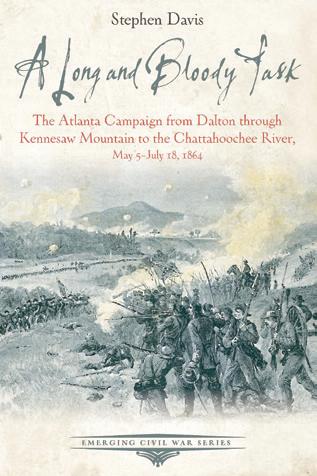

Some of us old-timers can remember Judy Collins’ hit, “Both Sides Now” (1968), in which she sings of gazing at clouds in the sky.
Well, that’s what George Barnard invites us to do in his Photographic Views of Sherman’s Campaign. The album of sixty-one photographic plates was produced by Barnard in 1866 in some 100 to 150 copies. Each featured pictures taken by the photographer as he traveled with Sherman’s army during the war and in spring 1866, when he returned to the South.

Barnard’s Photographic Views is reprinted in Keith F. Davis’ definitive George N. Barnard:
Photographer of Sherman’s Campaign (Kansas City, 1990).
In it Davis observes that by careful double printing, Barnard could add clouds to the skylines of his war scenes for aesthetic effect.
Theodore Davis, the Harpers Weekly illustrator whom Barnard had met during Sherman’s Georgia campaign, was assisting him with the Photographic Views album when he wrote Capt. Orlando Poe (Sherman’s former chief engineer) on Sept. 9, 1866: “Barnard has by a new process (double printing) got the most beautiful clouds in his prints, which excel any thing that I have ever seen in the way
of photograph[y].” Keith Davis notes that Barnard had not invented the double-printing process, but adds that it was still relatively new when Barnard employed it in 1866.
Those clouds moved around, as one can see in plate 24, “Allatoona from the Etawah,” and plate 46, “City of Atlanta, Ga., No. 2.”
They’re the same cloud formation!
This is just another example of the fun to be had in Barnardiana— studying the work of the Civil War western theater’s very best photographer.
Selling and Brokering
41 October 2019 Civil War News
Deadlines for Advertising or Editorial Submissions is the 20th of each month. Email to ads@civilwarnews.com
404.735.8447 • SteveATL1861@yahoo.com Programs for Civil War Round Tables and Historical Societies The American Civil War was the first war in which both sides widely used entrenchments, repeating rifles, ironclad warships, and telegraphed communications. wasalso firstAmericanWartobeextensivelyphotographed. Mathew Brady, Alexander Gardner and Timothy O’Sullivan are famous for havingmadeiconicphotographsintheCivilWar’seasterntheater. George N. Barnard deserves be ranked in this top tier for his photographic work the war’s western theater. civilian photographer hired by Gen. William T. Sherman’s chief engineer to take pictures of fortifications around Atlanta, Barnard took several hundred of them in and around city in fall of 1864. His most famous is the site of Union Maj. Gen. James B. McPherson’s death in the battle of Atlanta, July 22, Thusfar,nocomprehensive,definitivelistinghasbeenmade thephotographer’s The Library of Congress has 130 images; the U. Military Academy West Point, New York, has at least photographs, donated by Captain Poe’s widow. Otherrepositories,suchastheGilderLehrmanInstituteofAmericanHistoryin NewYorkCity,havesmallercollections. For this book we have chosen hundred images we deem “significant,” though otherstudentsmaywonderatsomeofourselections. We hope that this work will stimulate further interest in Barnardiana,andthatotherscholarlyvolumes yettocome. The Atlanta Campaign STEPHEN DAVIS 100 SIGNIFICANT CIVIL WAR PHOTOGRAPHS ATLANTA CAMPAIGN Stephen Davis Cumming, Ga. • Lecturer • Author • Course Instructor “Ask anyone who’s heard me.” For speaking engagements call or email:
“I’ve looked at clouds from both sides now”
Buying,
Jack Melton 520 Folly Rd, Suite 25 PMB 379 Charleston, SC 29412 jack@jackmelton.com 843-696-6385 Let me help connect you with a buyer or seller. I specialize in cannon, projectiles, fuses and wrenches, implements, sights, gunner’s equipment, tools, and other artillery related equipment. From single items to collections. Finders Fees Paid. Purveyor of Original Artillery Items
Plate
no. 46, “City of Atlanta, GA No. 2.”
Total War for Resources
War Stuff: The Struggle for the Human and Environmental Resources in the American Civil War. By Joan
 E. Cashin. Notes, works cited, index, 258 pp., 2018. Cambridge University Press, www.cambridge.org. $24.99 paperback.
Reviewed
E. Cashin. Notes, works cited, index, 258 pp., 2018. Cambridge University Press, www.cambridge.org. $24.99 paperback.
Reviewed
by John
Martin McMillan
environment. In his 2001 article for the National Humanities Center, environmental historian Jack Temple Kirby called for the connection of Civil War and environmental studies. Since then, historians from both fields have answered the call. Organized thematically and divided into seven chapters, Joan E. Cashin’s War Stuff is a valuable contribution to this growing Civil War subfield. Building on the work produced by Megan Kate Nelson’s Ruin Nation and Matthew Stith’s Extreme Civil War, Cashin combines the themes of these two books to grow our understanding of how consuming the Civil War was for resources and civilians.
In the last several years Civil War scholarship has seen a surge of studies focused on the war and its relationship with the
As Cashin’s subtitle indicates, the book focuses on the human and environmental resources available to both armies during the war. Furthermore, it illuminates the tensions between military and civilian relations. Union and Confederate armies’ attitudes towards civilians, their habitats, food and timber, and ineffective policy on attaining those resources made the Civil War “a ‘total’ war, in that it involved the complete exploitation of human and material resources.”
Cashin further contends there was no early war period of cooperation between the armies and civilians. “From the beginning, both armies practiced ‘hard’ war because of failures of supply and discipline.” The “total” war waged by both armies destroyed the South’s human and natural resources. Important to the book’s contribution, and persuasively argued, is that Confederate armies were as guilty as their Union adversaries for the destruction of southern resources. The book’s final chapter discusses this notion with greater depth. In it, Cashin explores how the destruction of the South’s resources affected the way Southerners understood the war.
Throughout War Stuff, Cashin urges that soldiers put their needs for resources over anything else. Necessity trumped policy. Early in the war, both armies adopted the Articles of War, written in 1806, that aimed to regulate actions between soldiers and subordinate civilians to the military. Later in the war, each side implemented new official policies for civilian-military relations: Union General John Pope’s and Secretary of War
Edwin Stanton’s General Orders in July and August 1862 and official Confederate regulations in January 1863. Even with these policies, Cashin contends, both armies “proved willing to exploit civilians for their own purposes, regardless of what policy might say…[and] had little impact on the behavior of soldiers on the ground.”

A central aspect of the book is its analysis of antebellum notions of communalism towards other whites and stewardship of resources. These attitudes were vital to life and culture in the North and South in the pre-war decades. Ideas of communalism and stewardship, however, were shattered by the conflict as armies took advantage of available resources and civilians continually looked towards their survival.
One element of human resources, however, is glaringly absent from War Stuff. Slaves proved to be valuable resources to both
armies. Whether they provided Union armies with intelligence or built Confederate fortifications, each side had a vested interest in South’s enslaved population. More inclusion of this group would provide a deeper analysis of the South’s human resources. Still, Cashin has produced a meticulously researched and eloquently written book. Underscoring the strained military-civilian relationship between both Union and Confederate armies, War Stuff illuminates how devastating and total the American Civil War was.

John Martin McMillan is a Ph.D. student and graduate teaching assistant in the Department of History at West Virginia University in Morgantown, West Virginia. His master’s thesis examined the role of the natural environment on the early military campaigns in West Virginia during the summer and fall of 1861.
Digital Issues of CWN are available by subscription alone or with print plus CWN archives at CivilWarNews.com
42 Civil War News October 2019
Fort Jefferson Gun Conservation—General Rodman's Cannon
By Joan Wenner, J.D.
Historical records note some in the Northern leadership had seen the Civil War as a limited fight without going all out onto a war footing, and once certain areas had fallen under Federal control, the Confederate government would realize it would be impossible to win independence by force, negotiation was the path for readmission into the Union. Of course that did not happen as the war changed from being limited into a total war in which one side would have to conquer.
It’s been claimed that before his inauguration Lincoln apparently opted for a strategy of continuing business as usual understanding that the ‘planter aristocracy’ particularly wished to prevent freeing the slaves. Early on Lincoln decided to take no overt step toward war. Indeed in his inaugural address he had said: “In your hands, my dissatisfied countrymen, and not in mine, is the momentous issue of civil war. The government will not assail you. You can have no conflict without being yourselves the aggressors.”
But the President also was determined, and obliged, to hold and occupy Federal property within the seceded states; this included Florida`s Fort Jefferson where construction had begun in 1846. In contrast to Fort Sumter, the apparent unimportance of the Florida forts made Federal retention relatively easy, even after Florida left the Union on January 10, 1861.

Also used as a prison from 1872–1878, it remains a ‘Federal’ outpost where the National Park Service hosts many visitors who combine history with nature, picnics on the beach, and peaceful exploration against a backdrop of silent cannons at Dry Tortugas National Park's Garden Key.
The national landmark was designed as “an immense gun platform and heavily armed,” according to the Park Service staff. Today, only twenty-five 15-inch smoothbore Rodman cannon, each weighing around 50,000 lbs., are known to exist. They note that among the fort`s various cannon types, in addition to Parrott rifles, one of the largest was the “Rodman Cannon,” with a 15-inch bore,
that could fire a 440-pound shell over 3-½ miles. 'Rodman gun' refers to a series of Columbiads designed by Union artilleryman Bvt. Brigadier General Thomas Jackson Rodman; these were smoothbore, heavy guns that fired both solid shot and shell. Rodman had developed a new cannon founding process, hollow casting, that resulted in cast iron guns much stronger than those previous made.
Intended for seacoast fortifications and manufactured with 8, 10, 12, 15, and 20-inch bores, "they were all nearly identical in design, with a curving soda bottle shape, and a large flat back with rachets or sockets for the elevating mechanism."
The Project
The South Florida National Parks Trust says its 25-ton Rodman was mounted on a Maryland-made reproduction carriage in 2015. The undertaking to mount the cannon began five years earlier in 2010, according to museum curator Nancy Russell, who said at the time, “A Rodman cannon hasn’t been seen at Fort Jefferson in over 100 years.” The original gun carriages had been scrapped in 1900 leading to corrosion and deterioration of the cannon at Fort Jefferson.

A team of civilian and government experts from many backgrounds, plus the military from Homestead AFB, were enlisted in 2010 to mount the massive gun. Logistics were a major challenge as the site location was 70 miles west of Key West where accessibility was only possible by boat or seaplane. Mounting the gun and carriage 45 feet above the parade ground posed difficulties. Safety was also daunting because working with such a heavy object with a crane or helicopter was not possible.
The barrel was ultimately raised 7.5 feet with a ‘gun lift’ inspired by a circa 1876 Rodman jack designed by Colonel Theodore T.S. Laidley specifically for the 15inch Rodman, but with a modification. With the barrel suspended, the carriage was then assembled, one part at a time, underneath the gun. The assembly was complicated because pieces weighed
almost 1,000 lbs. and each had to be hauled to the terreplein.
Ongoing Conservation
The NPS contracts for continuing conservation treatment methods and coatings established by the Naval Research Laboratory's Center for Corrosion Science and Engineering. The goal is longterm sustainability in the harsh marine environment of Garden Key.
A Side Note: Thomas Rodman, an 1841 West Point graduate who designed the gun, began his career in the Ordnance Department at the Allegheny Arsenal. During the Civil War, he served as superintendent of the Watertown Arsenal, in Cambridge, Mass., before taking command of the

Rock Island Arsenal in August 1865. In addition to creating an arsenal master plan, he tested gun metal, supervised cannon manufacture, tested guns and gunpowder, and served on ordnance and artillery boards. View the Rock Island Arsenal Museum's website at www.arsenalhistoricalsociety. org/museum for its history and visitor hours. Arsenal: Exploring Tomorrow Through Yesterday, published in 1996, is available at many university libraries. A story by the author also appeared in the Summer 2014 issue of The Artilleryman.
Joan Wenner, J.D. is a longtime history and maritime writer previously published in The Artilleryman, America’s Civil War, Military Heritage; and others. She
also contributes stories and book reviews for the Civil War News. Comments are welcomed at joan_ writer@yahoo.com
43 October 2019 Civil War News Publishers: Send your book(s) for review to: CWN Book Review Editor, Stephen Davis 3670 Falling Leaf Lane, Cumming, GA 30041-2087
Thomas J. Rodman, 1865. (Courtesy U.S. Army Garrison, Rock Island Arsenal Museum)
Aerial view of Fort Jefferson from the south. Garden Key, Key West, Monroe County, Fla. (Library of Congress)
Civil War period photograph of a 15-inch Rodman smoothbore cannon in Battery Rogers, Alexandria, Va., 1864. Note the soldier is behind the cannon and not to scale. (National Archives)




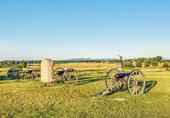













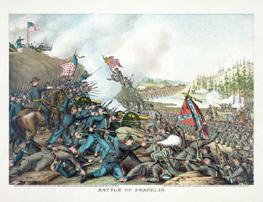
44 Civil War News October 2019 Historical Publications, LLC Civil War News • 800-777-1862 520 Folly Road, Suite 25 PMB 379 Charleston, SC 29412 www.CIVILWARNEWS.com UP-TO-DATE COVERAGE • PRESERVATION NEWS • BOOK REVIEWS SHOWS, LIVING HISTORY AND REENACTMENTS • HISTORICAL ARTICLES MONTHLY COLUMNS • CALENDAR OF EVENTS STAY INFORMED! Only $38.50/One Year • $66.00/ Two Years THE MONTHLY CURRENT EVENTS NEWSPAPER -FORCIVIL WAR ENTHUSIASTS SINCE 1974 12 ISSUES PER YEAR PRINT & DIGITAL EDITIONS AVAILABLE CALL OR SUBSCRIBE ONLINE TODAY! 2018 CW N 44, $3.50 America’s Monthly Newspaper For War Enthusiasts Wa acres states! Culpeper Virginia. Friend Civil War Trust’s Path to Preservation CW N No. Pages, Civil War News America’s Newspaper Enthusiasts Holzer Dancingsee Inside this issue: GETTYSBURG, town industryaround spirits. might placesmore where then departedplace McClellan’s now nursed woundedwoman ballroom. believe these banquet eraroomRemembrance andPenn., Karen beenDay, photographs themeantime, please dancers ball. Dancing the Night Away at the Gettysburg Hotel Poretsky guides Lincoln Scholar Harold Holzer’s Oration at the 154th Anniversary of the Gettysburg Address Gettysburg spot—in Washington—standsclutchingbecauseAmerican “unvemen something great oday, politically the kneeling theDespite endure, suchwithoutcontroversy—the roiling remember Gettysburg who mightgallery,uments:and secessionwhenequal—remained coming—in asspeech own, other statues Lincoln INSIDE EVERY ISSUE Buying, Selling and Brokering Jack Melton 520 Folly Rd, Suite 25 PMB 379 Charleston, SC 29412 jack@jackmelton.com 843-696-6385 Let me help connect you with a buyer or seller. I specialize in cannon, projectiles, fuses and wrenches, implements, sights, gunner’s equipment, tools, and other artillery related equipment. From single items to collections. Finders Fees Paid. Purveyor of Original Artillery Items Want To Advertise In Civil War News? Email us at ads@civilwarnews.com Call 800-777-1862 Civil War News Battlefield Of Franklin Land Preservation Purchasejoined together more than ten years--------H Franklin Deadline for submissions and advertising is the 20th of each month for the following Civil War News issue.
Before making plans to attend any event contact the event host.
Deadlines for Advertising, Editorial or Events
Submissions is the 20th of each month. We strive to add all events submitted to us but do not guarantee that your event will be published. There is a 100 word maximum for each event. Email events to: ads@civilwarnews.com
Sept. 21-22, Pennsylvania. Fall Farm Skirmish Historic Daniel Lady Farm, 1008 Hanover St. Gettysburg, Pa. Saturday, 10 a.m. – 4 p.m., Sunday, 10 a.m. – 4 p.m.
In honor of its 60th Anniversary, the Gettysburg Battlefield Preservation Association will host a live action and living history program that will include Confederate and Union encampments and skirmishing on the hallowed ground of the Historic Daniel Lady Farm in Gettysburg. Over 500 reenactors will present the Battle of Antietam’s “Bloody Lane” along with a cavalry reenactment and other clashes during the two-day program. Adults: $15 for a one-day pass and $25 for a two-day pass. Children 15 and under free. Includes tours of the historic Daniel Lady farmhouse and barn. For information, www. gbpa.org. Email: events@gbpa.org.
Sept. 28, Pennsylvania. Ride for Monument Preservation Soldier’s Grove, Pennsylvania Capitol Building East Wing. The 19th Annual Ride for the Monuments from Harrisburg to Gettysburg is sponsored by the Alliance of Bikers Aimed Toward Education (A.B.A.T.E.). It supports the Pennsylvania Gettysburg Monuments Trust for maintenance and upkeep of more than 140 monuments and markers on the battlefield that memorialize the actions of Pennsylvania troops. A portion also benefits upkeep of the Gettysburg Battlefield Preservation Association’s Historic Daniel Lady Farm. Registration begins at 11 a.m. outside the State Capitol Building’s East Wing.
Welcoming ceremony: 12:15 p.m. Ride departure: 1 p.m. Open to all interested riders. Rain or shine. Registration $10. For information, www.gbpa.org and www.abatepa.org.
Sept. 29, Illinois. Civil War Show and Sale
Zurko Promotions presents The National Civil War Collectors Fall Show and Sale which will be held at the DuPage County Fairgrounds in Wheaton. Hours: 9 a.m. to 4 p.m. Admission is $9 – includes admission to the CADA Collector Arms Dealers Assoc. Show. For information; www.chicagocivilwarshow.com.
Oct. 4-6, Virginia. Period Firearms Competition


The North-South Skirmish Association 140th National Competition near Winchester. Over 3,000 uniformed competitors in 200-member units compete in live-fire matches with muskets, carbines, revolvers, mortars and cannon plus costume competitions and historical lectures. The largest Civil War live-fire event in the country. Free admission, large sutler area, and food service. For information; www.n-ssa.org.
Oct. 5, Pennsylvania. Civil War Dance
Historic Gettysburg-Adams County will hold its Barn Dance at Beech Springs Farm in Ortanna, PA. Admission includes an historic barn tour, lite fare and silent auction. Period attire encouraged but not required. Adults: $35 advanced sales/$40 at door, $10 for children 6-15. Advance tickets: http://www.hgaconline.org/ or call 717-3345185.
Oct. 12-14, Pennsylvania. Annual Meade Society Fall Trip
“The Civil War in Western Pa.” Highlights include narrated river cruise; tour of Soldiers & Sailors Hall; Allegheny Cemetery; Pa. Trolley Museum, G.A.R. post and library in Carnegie and more. $375 per person, dbl. occupancy; includes motor coach, 2 nights lodging w/breakfast, river cruise, one lunch, two dinners, snacks and beverages. For information; 215-848-7753 or gedwinmc@msn.com.

Oct. 17, Massachusetts. CWRT Annual Jubilee Dinner

Olde Colony Civil War Round Table’s annual Jubilee Dinner at “Four Points by Sheraton Norwood, 1125 Boston Providence Turnpike, Norwood, MA.” Featuring the Hon. Frank J. Williams speaking on “U.S. Grant as a Hero.” Info/tickets: call Bob Hearsey at 781-828-3183.
Oct. 23-27, Pennsylvania. Guerillas, Partisans and Raiders
Featuring Martin West, Kevin Pawlak, Michael Hardy, Ted Alexander, Steve French and others based in Chambersburg, Pa. Special guest, award-winning author and historian Brian Steele Wills will also join us. We will examine irregular warfare through the ages from the Romans to present. Tours will include McCausland’s Raid, the Johnston/Gilmore Baltimore Raid, Mosby’s Confederacy and McNeil’s raids against the B&O Railroad. Talks also given by the historians listed above. The full itinerary & pricing available on www.CivilWarSeminars.org.
October 24-27, Pennsylvania. Forging the Path to Gettysburg
Discover the little-known action of spring/summer 1863 leading up to the pivotal Battle of Gettysburg! Tours led by area historian and Camp Curtin Historical Society President Jim Schmick and award-winning author and historian Scott Mingus. Lectures offered by The Tattooed Historian - John Heckman, Cooper Wingert, Debra McCauslin and others. Based in Chambersburg, Pa. For more details: www.CivilWarSeminars.org or call 717-264-7101.
Oct. 26-17, Alabama. Skirmish

Alabama’s oldest active working farm, Old Baker Farm is located approximately 25 minutes south on Hwy. 280 from Birmingham in Harpersville. All branches invited. Firewood, hay, water and powder for Artillery provided. Sutlers welcome. For information; Jimmy White, alabamabattery@yahoo.com, 1174 Curt Jarrett Rd., Ashville, AL 35953.
Nov. 2, Louisiana. Living History and Open House
Camp Parapet Day in Jefferson, the Greater New Orleans area, from 10 a.m. to 3 p.m. Jefferson Parish will open the grounds of its historic Civil War fortification for tours. Several vendors and exhibitors will be present including representatives of the state parks and other Louisiana history museums and sites. View a scale model of the large Camp Parapet facility as it existed in the 1860s. Experience period music, dancing and military reenactors representing both sides of the conflict. Camp Parapet served both the Confederacy and the Union during the war as a defensive position. It is also a location of significance to local African American history. Escaped slaves gathered near the site and some of the first African American soldiers were headquartered there. Music will be played each hour commemorating the various flags that flew over the site culminating with the National Anthem as Old Glory is raised Located a block off Causeway Blvd. between Jefferson Hwy. and River Rd., on Arlington Ave. Free admission.
Nov. 8-9, Pennsylvania. Licensed Battlefield Guides of Gettysburg Fall Seminar

“Gone, But Not Forgotten,” a visit to locations, landmarks, and areas that used to be on the Battlefield, but are no longer there. Join us Fri. at 6:30 p.m. at The Gettysburg Heritage Center, 297 Steinwehr Ave. for welcome reception with snacks & beverages. At 7 p.m., LBG Dave Weaver will conduct a presentation of WWI at Gettysburg. On Sat. we meet at 8 A.M. at the Hilton Garden Inn, 1061 York Road, for a light breakfast before tours beginning at 8:30 a.m., 10:30 a.m., 1 p.m. and 3 p.m. Lunch will be held at HGI’s Garden Grill at noon. Final wrap-up will be held at 4:30 p.m. at The General’s Ballroom at HGI. The cost for this seminar will be $125 per person which includes the five programs, snacks, light breakfast, lunch, and transportation. For more information and reservations: https:// gettysburgtourguides.org/2019-fall-seminar/.
Nov. 23, Pennsylvania. Remembrance Day in Gettysburg
General Meade & his Generals and the veterans of the Battle of Gettysburg Honor/Dedication Ceremonies during the Remembrance Day Observance. Honoring all commanders and veterans of the Battle. Meet at the General Meade Equestrian Monument at 10:30 a.m. For info; Jerry McCormick, 215-848-7753 or gedwinmc@msn.com.
Nov. 16-17, Virginia. Civil War Show and Sale
MK Shows presents the “Original Richmond” Capital of the Confederacy Civil War Show for collectors and history enthusiasts. There are hundreds of dealers with tables filled with books, authentic artifacts, guns, swords, uniform
45 October 2019
News
Civil War
gear, images, artillery, belt buckles, buttons, and other accoutrements. Located at the Richmond International Raceway, 600 E. Laburnum Ave. Free parking. Over 350 tables. Adults $10, Children under 12 are free. Sat. 9-5 and Sun. 9-3. For information; www.MKShows.com or mike@mkshows.com.
Dec. 7-8, Tennessee. Civil War Show and Sale
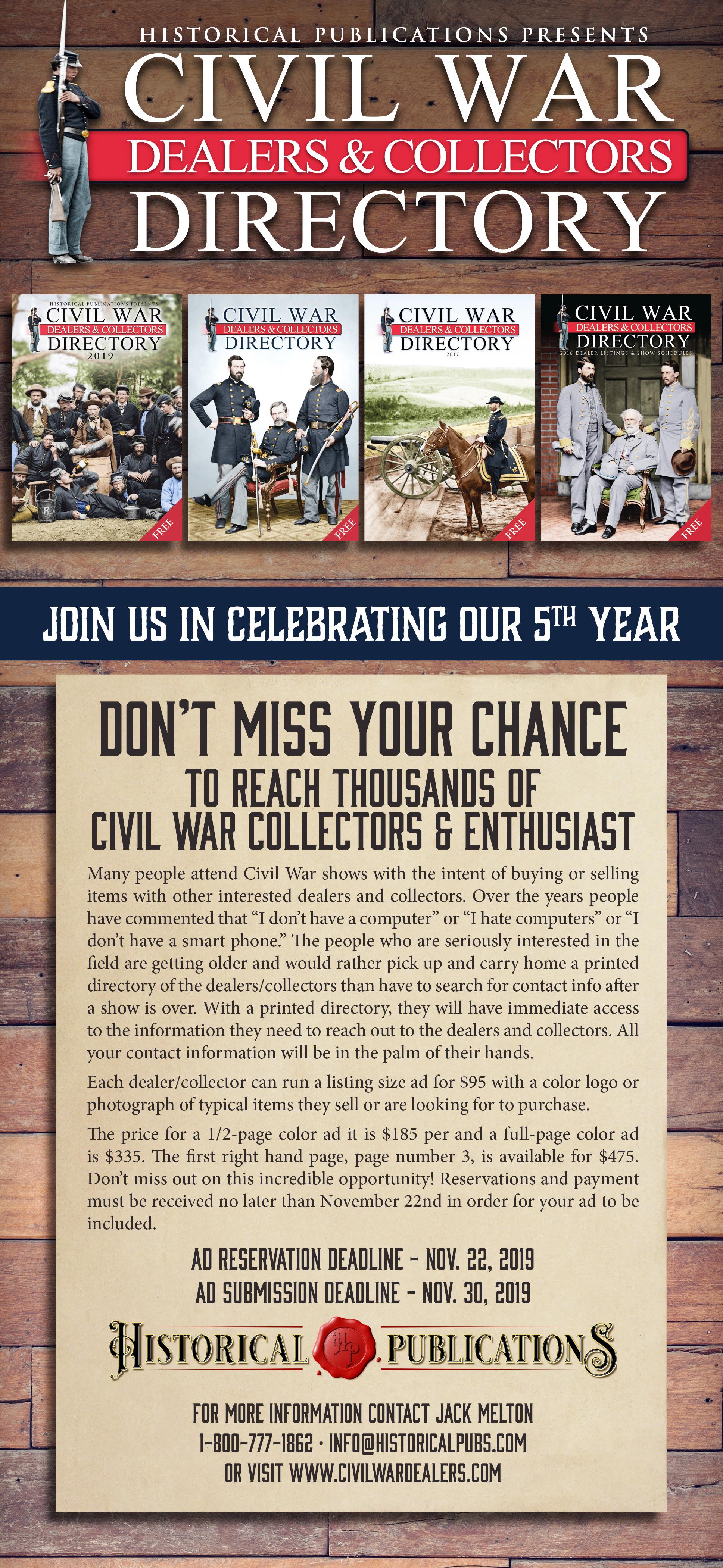
MK Shows presents the 32nd Annual Middle Tennessee Civil War Show and Sale at the Williamson County Ag Expo Park, 4215 Long Lane in Franklin. The nation’s largest Civil War show, featuring 1,000 tables of antique weapons, artifacts and memorabilia from top dealers and collectors around the country and encompassing all eras of military history from the Revolutionary War through World War II. Appraisers are always on hand to help you identify and value your military collectibles at no cost. Hours are 9-5 on Saturday, 9-3 on Sunday, parking is free and admission is only $10/adults and children 12 and under are free. For more information; www.MKShows.com or Mike@ MKShows.com.
Dec. 31, Pennsylvania. Annual General Meade Birthday Celebration
Mark the annual anniversary of the birth of General George G. Meade, heroic commander of the victorious Union army at the Battle of Gettysburg. The General Meade Society of Philadelphia will celebrate at Historic Laurel Hill Cemetery, 3822 Ridge Ave. at 12 p.m. Champagne toast and reception will follow. For information; 215-228-8200 Laurel Hill Cemetery.
2020
Jan. 4-5. South Carolina. Civil War Show
Low Country Civil War Show & Sale at Omar Shrine Temple, Mount Pleasant, Sat. 9-5, Sun. 9-3. Sponsored by American Digger Magazine. For information, 770-362-8671, 716-574-0465, www.americandigger.com.
Feb 1-2, Georgia. Civil War Show
MK Shows presents the Chickamauga (Dalton) Civil War Show at the Northwest Georgia Trade Center, Dalton, Ga., for collectors and history enthusiasts. Over 400 sale and display tables. Adults $10, Children under 12 are free. Open Sat. 9-5 and Sunday, 9-3. For information; www.MKShows. com, email Mike Kent at mike@mkshows.com.
Small Talk Trivia
Answers
1. James Birdseye McPherson (1828–1864)
2. Joseph Wheeler (1836–1906)
3. Tecumseh. “Cump.”
4. William Joseph Hardee (1815–1873)
5. John Alexander Logan (1826–1886)
6. Ezra Church
7. George Stoneman (1822–1894)
8. Joseph Emerson Brown (1821–1894)
9. Mortimer Dormer Leggett (1821–1896)
10. Francis Asbury Shoup (1834–1896). “Shoupades.”
100
Significant Civil War Photographs: Atlanta Campaign collection of George Barnard’s camera work. Most of the photographs are from Barnard’s time in Atlanta, mid-September to mid-November 1864, during the Federal occupation of the city. With this volume, Stephen Davis advances the scholarly literature of Barnardiana.
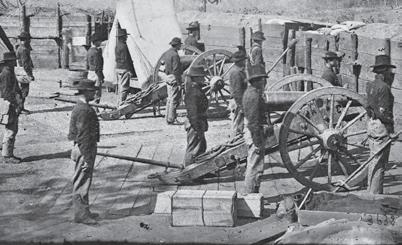
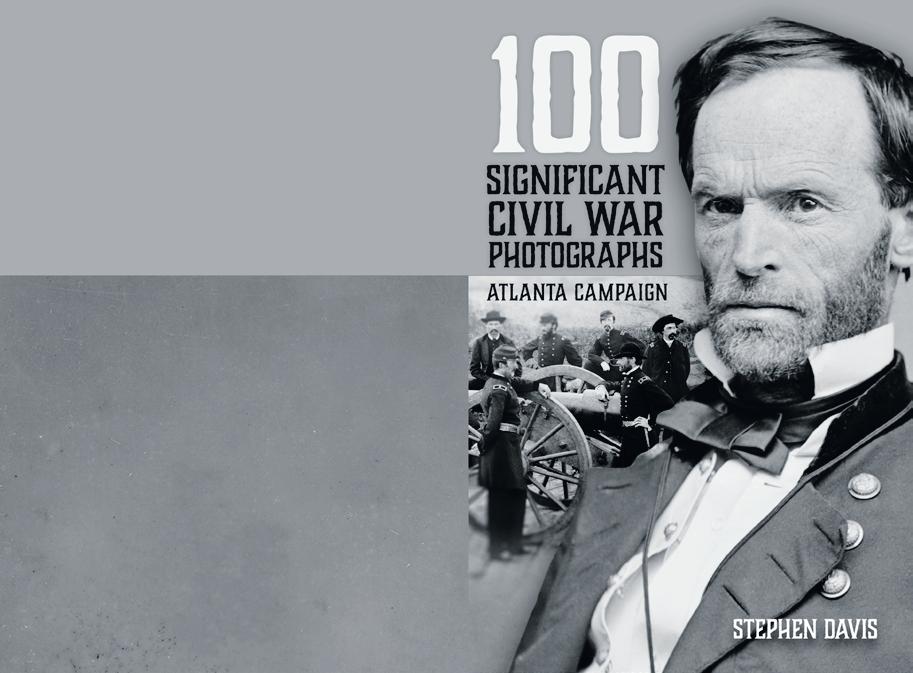
$19.95 + $3.50 shipping
128 pages, photographs, maps, bibliography. $19.95 + $3.50 shipping. Softbound.
ISBN: 978-1-61850-151-6. www.HistoricalPubs.com. Order online at www.HistoricalPubs.com or call 800-777-1862
46 Civil War News October 2019
The American Civil War was the first war in which both sides widely used entrenchments, repeating rifles, ironclad warships, and telegraphed communications. It was also the first American War to be extensively photographed. Mathew Brady, Alexander Gardner and Timothy O’Sullivan are famous for having made iconic photographs in the Civil War’s eastern theater. George N. Barnard deserves to be ranked in this top tier for his photographic work in the war’s western theater. A civilian photographer hired by Gen. William T. Sherman’s chief engineer to take pictures of fortifications around Atlanta, Barnard took several hundred of them in and around the city in the fall of 1864. His most famous is the site of Union Maj. Gen. James B. McPherson’s death in the battle of Atlanta, July 22, 1864. Thus far, no comprehensive, definitive listing has been made of the photographer’s work. The Library of Congress has 130 images; the U. S. Military Academy at West Point, New York, has at least 98 photographs, donated by Captain Poe’s widow. Other repositories, such as the Gilder Lehrman Institute of American History in New York City, have smaller collections. For this book we have chosen hundred images we deem “significant,” though other students may wonder at some of our selections. We hope that this work will stimulate further interest in Barnardiana, and that other scholarly volumes are yet to come. The Atlanta Campaign STEPHEN DAVIS 100 SIGNIFICANT CIVIL WAR PHOTOGRAPHS ATLANTA CAMPAIGN
Terms and Conditions
The following terms and conditions shall be incorporated by reference into all placement and order for placement of any advertisements in Civil War News by Advertiser and any Agency acting on Advertiser’s behalf. By submitting an order for placement of an advertisement and/or by placing an advertisement, Advertiser and Agency, and each of them, agree to be bound by all of the following terms and conditions:
1. All advertisements are subject to acceptance by Publisher who has the right to refuse any ad submitted for any reason.
2. The advertiser and/or their agency warrant that they have permission and rights to anything contained within the advertisement as to copyrights, trademarks or registrations. Any infringement will be the responsibility of the advertiser or their agency and the advertiser will hold harmless the Publisher for any claims or damages from publishing their advertisement. This includes all attorney fees and judgments.
3. The Publisher will not be held responsible for incorrect placement of the advertisement and will not be responsible for any loss of income or potential profit lost.
4. All orders to place advertisements in the publication are subject to the rate card charges, space units and specifications then in effect, all of which are subject to change and shall be made a part of these terms and conditions.
5. Photographs or images sent for publication must be high resolution, unedited and full size. Phone photographs are discouraged.
6. At the discretion of Civil War News any and all articles will be edited for accuracy, clarity, grammar and punctuation per our style guide.
7. Articles can be emailed as a Word Doc attachment or emailed in the body of the message. Microsoft Word format is preferred. Email articles and photographs: mail@civilwarnews.com

47 October 2019 Civil War News Advertisers In This Issue: 100 Significant Civil War Photographs – Atlanta 25 A Bloody Day at Gaines’ Mill book 42 Ace Pyro LLC 13 American Digger Magazine 44 Artilleryman Magazine 45 Brian & Maria Green 2 C.S. Acquisitions 27 Civil War Artillery – The Half Shell Book 21 Civil War Dealers Directory 46 CWMedals.com, Civil War Recreations 36 Civil War Navy Magazine 35 Civil War Shop – Will Gorges 6 College Hill Arsenal – Tim Prince 22 Dell’s Leather Works 20 Dixie Gun Works Inc. 18 Fugawee.com 13 Georgia’s Confederate Monuments – Book 26 Gettysburg Foundation 6 Greg Ton Currency 23 Gunsight Antiques 14 Harpers Ferry Civil War Guns 4 The Horse Soldier 11 Jack Melton 44 James Country Mercantile 5 Jeweler’s Daughter 11 Jessica Hack Textile Restoration 11 John Fazio – Author – Lecturer – Presenter 37 John Sexton Appraiser 32 Le Juneau Gallery 7 Mike Brackin 15 Military Images Magazine 12 National Museum of Civil War Medicine 33 N-SSA 5 Old South Antiques 19 Owens & Ramsey Booksellers 39 Panther Lodges 4 The Regimental Quartermaster 6 Richard LaPosta Civil War Books 36 Stephen Davis – Author 40, 41 Suppliers to the Confederacy – Book, Craig Barry 10 Ulysses S. Grant impersonator – Curt Fields 7 University of Tennessee Press 16 Vin Caponi Historic Antiques 8 Events: 155th Bentonville Reenactment 38 MKShows, Mike Kent 3, 29 Poulin Auctions 48
c c c c c c
NAME ADDRESS ADDRESS CITY STATE ZIP CODE EMAIL $38.50
Print $48.50
$66
Print $86
$29.95
Payment Enclosed Check # Card # Exp. Date Security Code Name on Card New Renewal c Make checks payable to Historical Publications LLC. c c c c
War News
PHONE Email (required for digital subscription) USA Subscriptions Only No Canada or International Mail to: Historical Publications LLC 520 Folly Road, Suite 25 PMB 379, Charleston, SC 29412 Deadlines for Advertising or Editorial Submissions is the 20th of each month. Email to ads@civilwarnews.com Subscribe online www.CivilWarNews.com Mike@MKShows.com • www.MKShows.com Admission Coupon To Any MKShows Event $1 Off 770-630-7296 Publishers: Please send your book(s) for review to: CWN Book Review Editor, Stephen Davis 3670 Falling Leaf Lane • Cumming, GA 30041-2087 Email cover image to bookreviews@civilwarnews.com Civil War News cannot assure that unsolicited books will be assigned for review.
Charge my: Discover MasterCard Visa
- 1 year USA
- 1 year USA Print & Digital
- 2 year USA
- 2 year USA Print & Digital
- 1 year Digital only
Civil
– 12 Issues Per Year
































































































 Glassell
Glassell










 By Stephen Davis Special to Civil War News
By Stephen Davis Special to Civil War News







 By Shannon Pritchard
By Shannon Pritchard









 Tom Gersbeck
Tom Gersbeck


 Les Jensen Former Curator of the Museum of the Confederacy
Les Jensen Former Curator of the Museum of the Confederacy




































 By Stephen Davis Special to Civil War News
By Stephen Davis Special to Civil War News
























































































 E. Cashin. Notes, works cited, index, 258 pp., 2018. Cambridge University Press, www.cambridge.org. $24.99 paperback.
Reviewed
E. Cashin. Notes, works cited, index, 258 pp., 2018. Cambridge University Press, www.cambridge.org. $24.99 paperback.
Reviewed






































